

The Scenic Natchez Trace Parkway: our Ultimate Road Trip Guide
Most travellers would say that a really great road trip lets you explore stunning landscapes, historic places and amazing cities - and the Natchez Trace Parkway is all three in one.
The 470-mile road trip from Nashville to Natchez along the Natchez Trace Parkway takes 9 hours to drive, passing Leipers Fork, Fall Hollow Falls, the Meriwether Lewis Monument, Florence, Dogwood Valley, Tupelo, Bynum Mounds, Jackson and Sunken Trace.
One of the best things about the Natchez Trace Parkway is that for almost its entire length, it's free of development, so you can really enjoy this beautiful and unspoiled landscape, while still being able to visit some great towns and attractions on or near the route. So sit back and enjoy the ride as you travel a route that's crossed this fascinating part of the country for centuries.
Where is the Natchez Trace Parkway?
Natchez Trace Parkway, located in the southern states of Tennessee, Alabama and Mississippi, is famous for being a historic cross-country trail used first by Native Americans and then by European settlers, to make the difficult journey from Nashville to the Mississippi River.
The forest trail that came to be known as the Old Natchez Trace has been used since prehistoric times, but it was President Jefferson who gave the order that turned the trail into a postal road from Nashville to the Mississippi River which, at the time, marked the United States frontier.
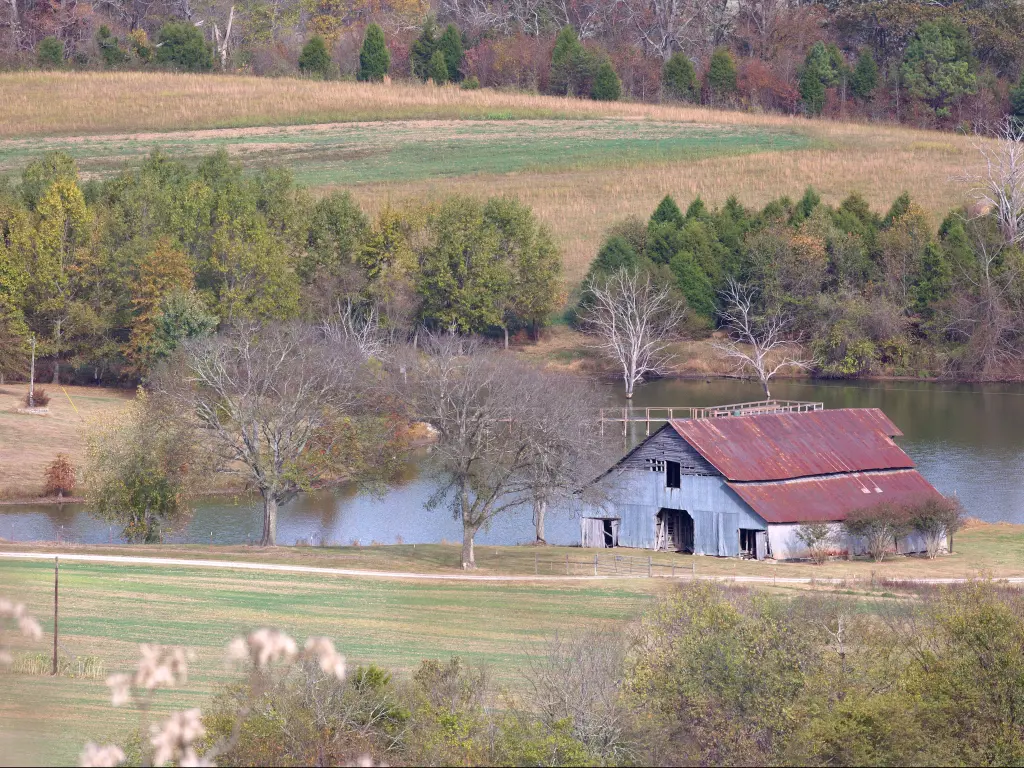
Back in the day when folk travelled this route in wagons and on horseback, they called the Trace the Devil's Backbone, since it was such a hard route to travel. It used to take up to 3 weeks to make the journey, and it was frequented by highwaymen.
It's a much easier route to travel now though, since the Parkway was constructed in line with the historic trail. The road is closed to commercial traffic, and speed limits are mostly 50 mph or under, so it's a relaxed drive that lets you explore some untouched scenery at your own pace.
Where does the Natchez Trace Parkway begin and end?
The Natchez Trace Parkway runs between Nashville and Natchez. It mainly runs through Tennessee and Mississippi, with a short section in the northwest of Alabama too.
The modern-day Parkway is a national park which follows the historic route of the Old Natchez Trace, taking you between towns, cities and former settlements which mainly grew up around this important trade and transportation route.
It passes through or near a number of towns and cities, including Collinwood, Florence, Tupelo, French Camp, Kosciusko, Jackson, Clinton and Port Gibson, and crosses the Tennessee and Duck Rivers.
The whole length of the route is a national park, but the road also passes near Devil's Backbone State Natural Area, Laurel Hill Wildlife Management Area, Tishomingo State Park, Tombigbee State Park and National Forest, Chickasaw Wildlife Management Area.
How long is the Natchez Trace Parkway, and how long will it take to drive its entire length?
If you join the Natchez Trace Parkway in the early morning, you could make the 9 hour 10 minute drive all the way from Nashville to Natchez in a single day.
However, that won't leave much time to stop and enjoy all the amazing places you'll pass along the way, so we'd recommend allowing 3 to 4 days to drive the whole 470-mile length of the route.
This means that on each day you'll only have 2 or 3 hours of driving, so you can really immerse yourself in the natural and historic sights you'll see along your trip.
The shorter route option from Nashville to Winona takes around 3 hours less, so we'd suggest taking 2 or 3 days for this 330-mile journey along the Natchez Trace Parkway.
Whether you're driving the full route or exiting at Winona, the section from Jackson Falls to the Meriwether Lewis Monument is the busiest part of the whole Parkway, so don't expect to have the road to yourself until you're further into your drive.
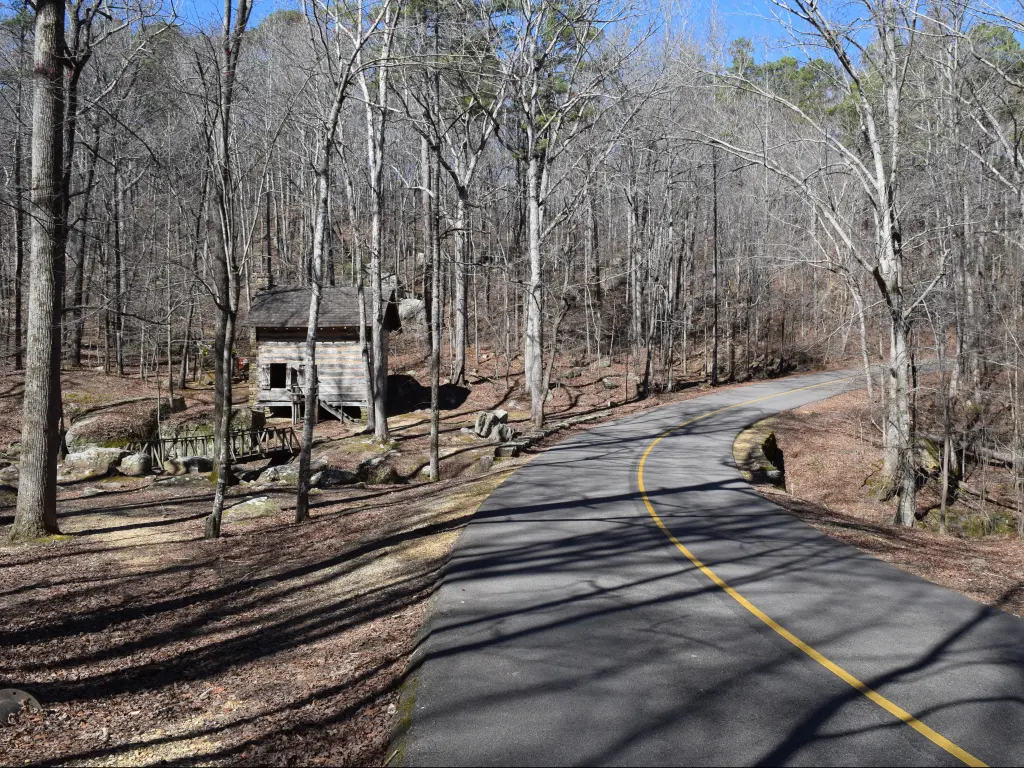
The shortest option of all, from Jackson to Natchez, only takes 2 hours to drive. You can make this manageable 110-mile trip in a single day. However, seeing as this stretch is also a popular commuter option linking the two cities, it can get busy in the morning and evening rush.
Best way to drive the Natchez Trace Parkway
The whole length of this route is stunning, whatever time of year you travel. As well as the many beautiful Overlooks that you can stop and enjoy as you pass, you'll find numerous trailheads which let you hike out to explore the beautiful surroundings.
Some of the highlights of driving the whole route include sections of the Old Trace that you can hike and sometimes drive along (depending on your vehicle), Jackson Falls, the Meriwether Lewis Memorial and Native American Burial Mounds,
If you don't have the time to get all the way to Natchez, you can follow the route as far as Mathison and then exit towards Winona. You'll cover three quarters of the full route, so you'll still get a real feel for the Parkway, with many chances to see parts of the Old Trace, burial mounds, historic settlements and of course, hike some fantastic trailheads.
By following the Parkway from Nashville to Winona, you'll find yourself back on the Interstate, so you can continue your journey to other destinations if that's what you have planned. Or you can be back in Nashville in around 5 hours, if you're taking a round trip.
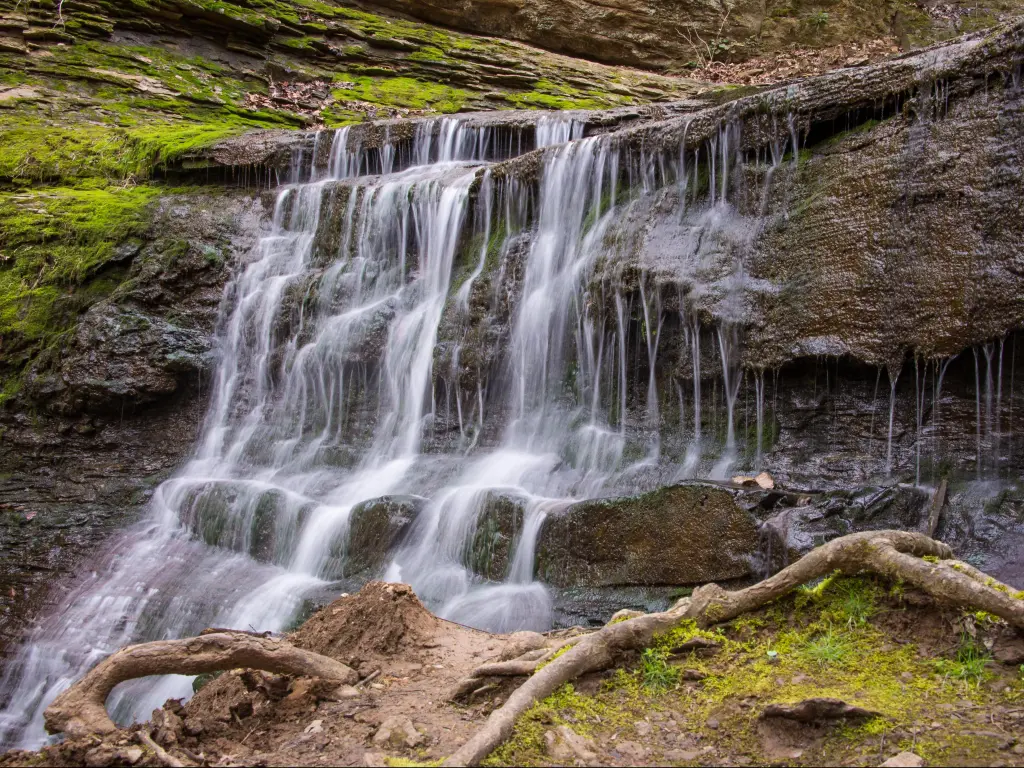
For travellers with only a little time to spare, the drive from Jackson to Natchez is the perfect way to enjoy a part of the Natchez Trace Parkway. This route can be driven in a day. You'll still get a flavor for the area's beautiful landscape and fascinating history, and you can take some time to explore Sunken Trace.
Joining the Parkway at Jackson means you're right on the Interstate too, so it can easily be combined with a longer road trip – an East-West trip from Savannah or Montgomery towards Dallas would link up especially well, or join the Parkway as part of a longer trip south via St Louis or Memphis.
So, whether you have the time to drive the whole route or just a part of it, it will be a truly unforgettable trip. Keep reading to find out what's in store.
Driving the entire length of the Natchez Trace Parkway
This is a route that has been used to travel from Natchez to Nashville for centuries, so driving the whole length of the modern-day Parkway lets you revisit that long and challenging history journey in full.
You'll see everything that the Natchez Trace Parkway has to offer, and follow in the footsteps and wagon tracks of countless travellers in the past.
To join the Parkway, take the highway out of Nashville to Pasquo, where you'll have the chance to grab a coffee or refuel before joining the northern end of the Natchez Trace Parkway.
Soon, you'll cross the impressive Natchez Trace Parkway Bridge, and you'll really feel like your road trip is underway!
Seeing as this is a dedicated scenic parkway, it's pretty easy to navigate your way along the length of the route. Simply follow the road until you reach the final exit point at Natchez! However, there are a number of places to look out for as you pass them along the way.
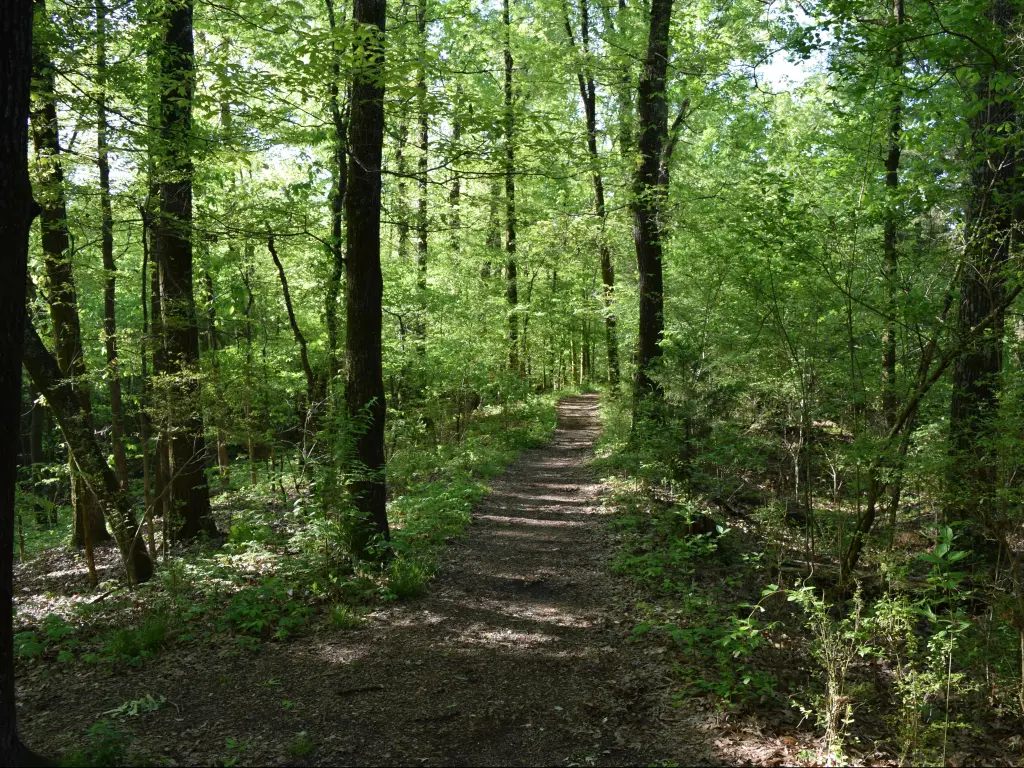
Stop for food in Leipers Fork, or enjoy some time outdoors at Garrison Creek Park or up at Water Valley Overlook. Next, you'll pass Gordon House Historic Site, right by the Duck River, then continue on to beautiful Jackson Falls.
You can really get the feel for the history of this route when you stop at places like Old Tobacco Farm, then continue on past Devil's Backbone State Natural Area, Swan View Overlook and Fall Hollow Falls.
One of the most visited parts of the Natchez Trace Parkway, the Meriwether Lewis Monument, is you next waypoint. Then think about a short detour off the Parkway to visit Florence, Alabama, before crossing the Tennessee River just by Rock Springs Nature Trail.
As you carry on south, you should definitely stop off at Bear Creek Mound, the first of several Native American ceremonial mounds that you'll pass on this drive.
If you have time, take a short detour off the Parkway to visit Bay Springs Lake, then head back to the main route to walk through the beautiful Dogwood Valley and then stop in Tupelo, which as well as being the birthplace of Elvis Presley, is also where you'll find the Natchez Trace Parkway Visitor Center.
From here, carry on past Bynum Mounds and then the towns of French Camp and Kosciusko which are right by the Parkway. Then continue further south past Pearl River State Wildlife Management Area until you get to Mississippi's state capital, Jackson.
If you're visiting the city, it's a simple run in and out of Jackson along the highway. From here, the last stretch of your drive will take you through Sunken Trace - one of the most visited parts of the Old Trace - and Brandon Hall Plantation. Then you'll pass Natchez State Park just before reaching the end of the Natchez Trace Parkway in the city of Natchez.
Driving the Natchez Trace Parkway from Natchez to Jackson
To reach the southern entrance to the Natchez Trace Parkway, pick up Liberty Road as you travel South West out of the city and it will take you straight there.
After visiting Natchez State Park, you can visit Emerald Mound, then continue north until you reach the lovely small town of Port Gibson. From here it's only a short drive until you reach Sunken Trace, which many say is the most atmospheric and special part of the Natchez Trace Parkway.

After around an hour, you'll exit the Natchez Trace Parkway onto Interstate 20, then follow the interstate into the center of Jackson to complete your short road trip in Mississippi's stunning state capital.
Driving the Natchez Trace Parkway from Nashville to Winona
If you're only following the Natchez Trace Parkway as far as Winona, you can save a little time by joining the Parkway a few miles after its starting point. Simply take I-65 south out of Nashville, then continue west past Burwood. From here, pick up Leipers Creek Road which will take you onto the Parkway just after the small town of Fly.
From here, simply follow the route south - it's impossible to get lost!
Along the way you'll pass many of the same waypoints as the full route, including Gordon House Historic Site, Jackson Falls, the Meriwether Lewis Monument and Bear Creek Mound.
You can also stop and spend some time in Tupelo as you make your way along the southern part of this route, then you'll pass the impressive Bynum Mounds.

After a few more miles it will be time to leave the Natchez Trace Parkway. Follow signs onto Route 82, which you'll follow west through Stewart and Hendrix into Winona, at the end of your amazing road trip.
Best places to stay along the Natchez Trace Parkway
To enjoy the Natchez Trace Parkway to the full, we'd recommend making a couple of overnight stops, so keep on reading for our top picks along the route.
If you'd like to see more options for an overnight stop along the beautiful Natchez Trace Parkway, check out our ultimate guide to the best stops on the route here .
Overnight stop in Tupelo
Whether you're driving the whole of the Natchez Trace Parkway or just going as far as Winona, Tupelo is one of the larger cities along the route. With plenty to see and do, and some great restaurant and hotel choices, it's the ideal place for an overnight stop.
Tupelo, which is around 4 hours out of Nashville, is best known as the birthplace of Elvis Presley, and most visitors to Tupelo head straight to see his childhood home. It's only small, as the legendary musician came from humble beginnings, so tag on a visit to the Elvis Presley Museum too.
There's more to the town than just its musical heritage though. Natchez Trace HQ is located right here in Tupelo, and can fill you in with more details on the Parkway and its history.
The Oren Dunn City Museum is dedicated to telling the story of the area around Tupelo, you can find out more about some of the places you'll have driven through on the Parkway.
History fans might also like to pay a visit to Tupelo National Battlefield Site, where a significant Civil War battle is commemorated, or the Tupelo Veterans Museum. The city is also a great place to go hunting for antiques - check out Relics Antique Marketplace to see what you can find.
Back on the road and not far from Tupelo you can explore the Dogwood Valley, a beautiful, wooded section of the Old Trace. A little further afield is Tombigbee State Park, a beautiful habitat full of wetlands and waterways where you can fish and hike.
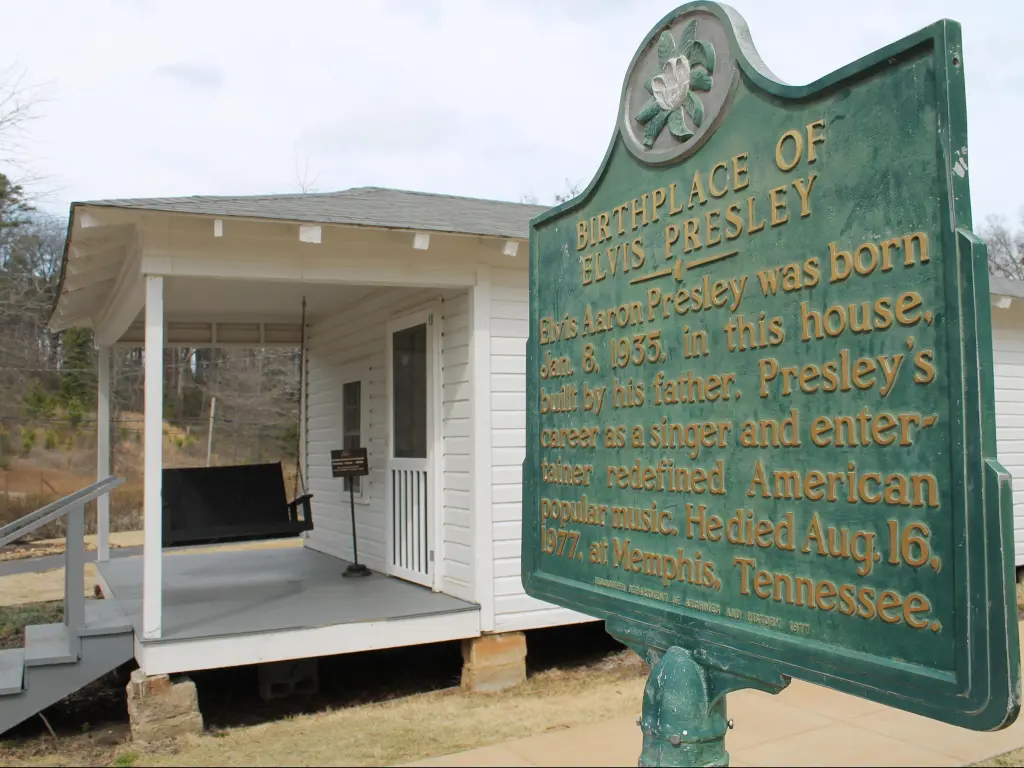
One of the best hotel choices in town is Hotel Tupelo , which is more central than most Tupelo hotels. The hotel has spacious rooms which feature simple but elegant design with a nod to Tupelo native Elvis Presley and the 1950s and 60s.
There are all the facilities you'd expect here, including a fitness center and in-house restaurant and bar, plus a terrace with views across the town. You can also walk to Elvis Presley's birthplace from here.
Parking is easily available nearby, and as it's just off the highway which takes you back to the Parkway when you're ready to carry on your drive.
Overnight stop in Jackson
Mississippi's state capital prides itself on its southern hospitality, and as one of the biggest cities on the whole of the Natchez Trace Parkway, it's a great place to spend a night if you're driving the whole route or the shortest section which ends in the city itself.
There's plenty to see in the City With Soul, including the Old Capitol Museum. The Old Capitol was the state's seat of government during the 19th century, and at this informative museum you can learn about this period, when wagons still followed the Natchez Trace.

Rolling forward in time, the Mississippi Civil Rights Museum tells the important story of some of the people who helped shape the modern United States
You can also follow the self-guided Freedom Trail, which illustrates the African-American history of the city, and includes parts of the Farish Street Historic District. Or for a different view of Jackson, take a guided kayak tour through the center of the city.
With welcoming staff, spacious rooms and smart, modern design throughout, The Westin Jackson is an amazing place to stay in the city . It also offers a great breakfast, and with a pool and on-site spa you can treat yourself to some relaxation time.
The hotel is really centrally located. It's just a short walk to the state capitol and also near to Mississippi Museum of Art and Mississippi Civil Rights Museum
On-site parking will take away some of the stress of arriving in a new place, and seeing as the hotel in only a couple of blocks to the main interstate and highway, you can get on and off the Natchez Trace Parkway really easily too.
Things to see on a road trip along the Natchez Trace Parkway
From stunning hikes and historic sites to charming small towns, there's plenty to see and do when you take a road trip along the Natchez Trace Parkway.
What you can see depends on the route you take. If you drive the whole Parkway, you'll pass all the attractions listed for the shorter routes, plus some extra gems that sit outside of the other sections.
The Natchez to Jackson section:
- Natchez State Park - Centered around Natchez Lake, you can enjoy fishing and other outdoor activities here, or take a tour of one of the 19th century mansions which have been preserved here.
- Brandon Hall Plantation - A former cotton plantation, the historic buildings here have been preserved and now operate as a bed and breakfast.
- Emerald Mound - This man-made mound is thought to have been used for hundreds of years, as a ceremonial meeting point for local populations.
- Mount Locust - At this house dating back to the 1780s, you can now admire the historic building and also take a moment of reflection in the cemetery for the slaves who worked for the house's owners.
- Sunken Trace - This atmospheric part of the Old Trace Trail was trodden down by travelers over many years so that the path now makes a hollow through the forest.
- Owens Creek Waterfall - The spring which feeds this waterfall often dries up, but after heavy rain, this atmospheric small cascade can still be seen at times.
- Jackson - Mississippi's state capital is a rare urban break as you travel along the Parkway. Visit the Old Capitol Museum, or follow the Blues Trail and Freedom Trail around the city.

The Nashville to Winona section:
- Water Valley Overlook - As the name suggests, this hilltop overlook will reward you with beautiful river views, which are spectacular when decked out in fall foliage.
- Gordon House Historic Site - This brick-built house has been a landmark on the Old Trace for over 200 years. Even after Trace become less used as a trading route, locals continued to use the Duck River ferry which operated from the house.
- Jackson Falls - Hike up to this beautiful woodland waterfall – be prepared for a fairly steep climb though.
- Old Tobacco Farm - Tobacco was big business along the Natchez Trace, and this farm is set up as it would have been around 1900.
- Devil's Backbone State Natural Area - This is a great hiking opportunity, which follows a creek through the forest.
- Fall Hollow Falls - This impressive cascade is only a few meters off the route, so it's easily accessible even if you don't have time for a long hike.
- Meriwether Lewis Monument - One of the great pioneers of the United States, who famously traveled to the Pacific Ocean in 1805, was found dead as he made his way along the Trace just 4 years later.
- Rock Springs Nature Trail - Seek out beaver dams and watch the flourishing birdlife in this beautiful wetland area.
- Bear Creek Mound - This ceremonial mound, thought to be almost 1000 years old, has been restored after being damaged by farming.
- Bay Springs Lake - Take a short detour off the Natchez Trace Parkway to enjoy boating and fishing.
- Dogwood Valley - Lined with the dogwood trees that this section of the Old Trace is named after, you can take a relaxing and peaceful walk along the old trail here.
- Tupelo - The birthplace of Elvis Presley is a great place to pause and refuel, rest your legs or grab a meal. Take a detour to Tombigbee State Park to fish and hike if you have extra time.
- Bynum Mounds The oldest mounds here date from around 100 years BC, and formed a cultural meeting point for the Chickasaw people who built them.
Things you can only see if you drive the whole Parkway:
- Natchez Trace Parkway Bridge - Take a moment to appreciate the views from this stunning man-made feature, which marks your entry onto the parkway.
- Leipers Fork - This small Tennessee town is a hidden gem, full of great restaurants and boutique shops, and with a buzzing live music scene. Get a taste of bourbon at the distillery while you're in town too!
- French Camp - Visit the reconstructed historic village here to get a real feel for what life would have been like in the heyday of the Natchez Trace.
- Kosciusko - This much-visited small town was named after a Polish general who fought in the American Revolution, but one of its more well known modern inhabitants is Oprah Winfrey, who was born here. Take a stroll around the town's historic buildings and visit the Cultural Center while you're in town.
- Pearl River State Wildlife Management Area - Take a short detour off the route to enjoy hiking or bird watching in this peaceful wetland habitat.
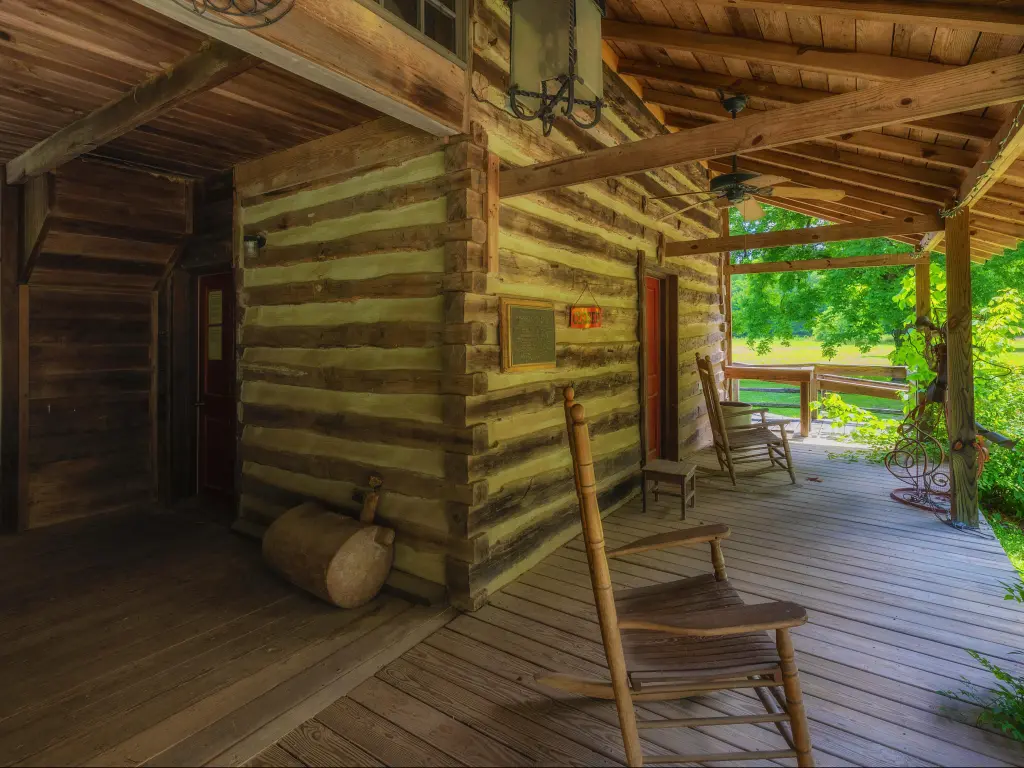
Best time to visit the Natchez Trace Parkway
The Natchez Trace Parkway is open 365 days a year, but seasonal variation means you'll have a very different experience depending on when you travel.
The region enjoys a sub-tropical climate, so conditions can be quite hot or humid from April through to October, with temperatures into the 90s Fahrenheit during the peak summer months. There's frequent rainfall, so come prepared!
Winters here tend to stay mild, but temperatures can drop below freezing and there's a chance of snow right the way from December to March, which will occasionally close sections of the Parkway. Keep an eye on updates on closures and local conditions from the National Parks Service if you're planning on taking the trip in winter.
Also, be sure to drive safely, as there are no street lights on the road, and make sure your vehicle is ready for the drive – GPS coverage is limited on parts of the route. With cooler weather, most travellers prefer not to drive this scenic route in winter, as the hikes and the views are better from spring to fall.
Spring and fall are probably the most popular times to travel along the Parkway, with average temperatures ranging from 60 to 80 degrees as the seasons change. Popular Spring and Fall Pilgrimage Tours run for a month in each season, so popular attractions will be busier at these times – check ahead for dates to avoid if you prefer to have a quieter view of these historic sites.
In spring, you'll see wildflowers bursting into life. In May, the Natchez Trace Century Ride sees cyclists coming from miles around to ride up to 100 miles of the Parkway, so you might like to load up your bike and make this a part of your trip. Cyclists share the road with cars, so your drive is likely to be a little slower if you visit the same weekend.
Along the Natchez Trace Parkway, the fall foliage is some of the best in the US. It will be busy at times, especially in the areas closest to the cities.

During Fall, several of the towns along the Trace hold Harvest Festivals, where you can enjoy food and drink, traditional crafts, live music and horse and carriage rides. Natchez also holds an impressive Hot Air Balloon Festival each year in October.
Travellers should also be aware that, although this is technically a scenic drive, it's also used by local commuters. This means peak times can see heavy traffic on the sections nearest bigger towns - the perfect excuse to linger over breakfast before setting out!
Join our email list!
By joining our email list, you give LazyTrips permission to use your email for sending you newsletters, emails and updates including for marketing purposes. Your email will not be provided to third parties.
Related posts

Already have an account? Log in

My Itchy Travel Feet
The Baby Boomer's Guide To Travel
Driving through History on a Natchez Trace Road Trip
This article may contain referral links. Read our DISCLOSURE
On a Natchez Trace road trip, you’ll experience history, culture and a scenic drive through beautiful areas of the South. Alan and I have driven a small portion of the road on a short, Natchez Trace tour .
However My Itchy Travel Feet Featured Contributor, Debi Lander from ByLanderSea , drove the entire parkway. She shares her Natchez Trace itinerary so that you can do that, too!
The 444-mile Natchez Trace Parkway runs from Nashville, Tennessee , to Natchez, Mississippi . The recreational road and scenic drive links the Cumberland, Tennessee, and Mississippi rivers, while passing through three states.

Table of Contents
What is the Natchez Trace Parkway?

The parkway roughly follows the “Old Natchez Trace.” The historic travel corridor was used by American Indians, “Kaintucks,” European settlers, slave traders, soldiers, and future presidents.
The National Park Service manages the Parkway ( official website ), so I think of it as a very long, but narrow National Park travel adventure . The landscape includes trails, campgrounds, historic markers, and bodies of water.

You’ll find the two-lane Natchez Trace permits no billboards, trucks, hotels or gas stations—and limits speed to 50 mph. It’s like taking a Sunday drive on a rural country road.
My girlfriend Judy and I carefully planned a slow, southern sojourn centered around the Trace. We would drive the route, stopping to explore and stay in nearby cities.
We hoped to discover American history , country music, and indulge in southern cuisine . While others enjoy hiking, biking, horseback riding, and camping on the Trace, we chose less adventurous, but more comfortable activities.
The History of the Natchez Trace Trail

The original trail comprised a patchwork of foot trails stretching over Choctaw and Chickasaw land. The early travelers encountered many hardships among the swamps, dense forest, and rivers.
Over time, some of the footpaths were beaten down, creating long passages with banks so high travelers could only see what lay immediately ahead. Lying in wait were bands of robbers anxious to steal from the traders heading home.
It took about 35 days to traverse the Natchez Trace trail by foot, 25 days on horseback. Life was tough, but the settlers, soldiers and opportunists were tougher.
Passing along the original Natchez Trace were figures from history such as Daniel Boone, Aaron Burr, Washington Irving, the great chief Tecumseh, David Crockett, Jim Bowie and Andrew Jackson. Even Meriwether Lewis of Lewis and Clark trekked this route, although he died under mysterious circumstances at Grinder’s stand and is buried nearby.
By 1809, the Trace had been widened to accommodate wagons, making it an important trade route between Nashville and the Mississippi River. It continued to flourish until the rise of the steamboat, then slowly fell into disuse.
By the Civil War, the Natchez Trace was all but forgotten though some skirmishes and battles were fought in the vicinity.
The trail would likely be lost had it not been for the formidable ladies of the DAR (Daughters of the American Revolution). They brought the project to the attention of lawmakers and raised funds.
The National Park Service took over in 1938. The Parkway was finally completed in 2005.
Boomer Travel Tip
Use our road trip planner to make the most of your next road trip adventure.
Start your Natchez Trace Road Trip in Nashville

Judy and I flew to Nashville to soak in the lively atmosphere of Music City and take in a performance at the Grand Ole Opry . The next morning, we entered the beginning (or end) of the well-marked Trace at the Double Arch Bridge.
As bridges go, the Double Arch is a lovely thing, impressive in its simplicity. However, getting our first glimpse of the scenic Parkway, made us feel conflicted. We wanted to continue down the canopy-covered road, but our plans included a longed-for visit to Graceland in Memphis. Elvis was calling.
We detoured to Memphis and found those ghosts of Elvis—lurking among his home, costumes and platinum records. The King still reigns supreme at Graceland.
Diverting to Tupelo

Tupelo, Mississippi lies two hours south of Memphis; its claim to fame is the Elvis Presley Birthplace Park. The 15-acre setting features the wooden, two-room shotgun house where the performer was born.
The house is so small that it only takes about five minutes to tour. His family moved around, losing the home, but remaining in this neighborhood, until moving to Memphis.
Of course, the Birthplace Museum showcases Elvis’ early years. The Presley childhood church was moved to the site and you can stop in a memorial chapel next door, built after his death.

Two statues grace the hill above. The pair, entitled Becoming, symbolize the transformation of Elvis, The Boy at 11, to Elvis, The Entertainer. Well done!
Downtown Tupelo tributes include several colorful murals, street-side, and guitar-shaped artworks. Of course we visited Tupelo Hardware, the place Elvis’ Mama bought him his first guitar.
Judy and I spent the night in Tupelo ( search for hotels here ) after dining at the Blue Canoe (renowned for its live music and Blueberry Donut Bread Pudding). A suggested Elvis-themed breakfast made me hesitant, but the King Chicken Fillin’ Station’s proved over the top delicious—as were the calories.
Natchez Trace Parkway Headquarters

Before driving the trace, we stopped at the Natchez Trace Visitor Center in Tupelo to see the introductory film. As always, the National Park Service does a good job with their presentations; this one explores the trail’s history. Highly recommended.
The official Natchez Trace map (available at the center or online ) denotes the numerous historical markers, all designed to pull off and park. We used the map as our Natchez Trace trip planner, stopping frequently and occasionally finding something interesting enough to get us out of the car.

For example, at the Chickasaw Village site, homeland to the tribe, we looked at artist renderings and walked a short interpretive trail. Plans to reconstruct a fort and village have not reached fruition. The tribe was one of many forced to relocate to Oklahoma in the 1800s.
At another marker, we walked five minutes to reach old Confederate graves with stone markers. A group of motorcyclists were putting flags on the gravesites.
Need to update your road trip gear? Start with our recommendations for best road trip gear .
Stopping in Jackson, Mississippi
Jackson lies just 10 miles off the Trace, an ideal place to spend a night . After all, it’s the state capital and boasts two fantastic museums: the Mississippi History Museum and the Mississippi Civil Rights Museum.
Good thing we allotted the entire afternoon. The two attractions jointly cover 200,000 square feet and include 22,000 artifacts. As recommended, we started on the history side and found the 1800-1900s the most interesting.
The Civil Rights Museum

The state-of-the-art Mississippi Civil Rights Museum presents powerful stories . You’ll find eight interactive galleries with striking images and displays. Seven of the galleries encircle a central space, highlighted by a sculpture called “This Little Light of Mine.”
You move from the darkened galleries into the light as you work your way around the museum. The sculpture becomes brightest when the music of the Movement swells, about every 15 minutes.
I found myself pulled in by the clapping, swaying and singing. This spot is truly uplifting, a good thing because there’s no sugarcoating here. The museum tells poignant, often tearful tales.
A lynching tree inscribed with names bears witness to the 600 Mississippians hung in the state. Other displays include Ku Klux Klan robes, the rifle that killed Medgar Evers, plus many informative videos set within small spaces—for example, the back of a police wagon or a jail cell.
The Mississippi Civil Rights Museum highlights stories that Americans can’t and shouldn’t forget. It’s a must-visit while visiting the state.
Dining in Jackson, Mississippi

For dinner, we headed to Babalu, a restaurant named after the signature song of the television character Ricky Ricardo, played by Desi Arnez, on I Love Lucy . The Latin-inspired menu features tapas and tacos instead of typical southern fare. Try their signature fresh guacamole made tableside along with the house margarita: The Baba Rita.

For breakfast, boomers will love Brent’s Drugs , an old-fashion pharmacy/soda fountain that takes you back to childhood days. The place opened in 1946 and feels like a time capsule with real soda jerks.
No surprise, many scenes in the movie The Help (did you read the book?) were filmed there. Hidden in the rear of Brent’s you’ll discover The Apothecary—the most wonderful speakeasy-style bar. I wish we’d known of this earlier.
The Mississippi State Capitol
In my opinion, state capitols are always worth a visit. They burst with grandeur and symbolic art.

Judy and I quickly popped in to the Mississippi State Capitol building for a self- tour using the visitor brochure as our guide. We loved the rotunda and thought it fun to see author John Grisham ’s photo on the wall (1983-90) when he was representative of the State Senate.
Touring Vicksburg

Vicksburg also lies about 25-30 off the Trace but should be included on the road trip. The Vicksburg National Military Park ( official website ), a unit in the National Park Service, is the most visited site in the entire state.
Hire a guide (at the visitor center) to join you in your car. Ours was a walking encyclopedia with knowledge about the battles, the importance of topography, and what happened to those in the town.

Stop for lunch at Walnut Hills Restaurant for a fabulous family-style meal. The table will be laden with bowl after bowl of Southern specialties: green beans, turnip greens, macaroni & cheese, coleslaw, creamed corn, cheese broccoli, fried okra, cheese grits, black-eyed peas, rice and gravy, plus a basket of cornbread and biscuits.
Then, comes the fried chicken, honestly the best I have ever tasted anywhere—almost enough to make you drool.

The Cedar Grove Mansion Inn , a bed & breakfast surrounded by manicured gardens, immediately put us under its spell. We indulged in the gracious charm of the Antebellum estate, honestly an attraction on its own.
Judy slept in the General Grant room, including many original furnishings. I enjoyed the General Sherman room.
Windsor Ruins
Vicksburg could have kept us busy another day and night, especially if we’d been interested in gambling. Casinos do big business in Vicksburg.

Instead, we headed toward the Windsor Ruins near Port Gibson, getting a bit lost in kudzu covered territory. The ruins are all that remain of what was once a palatial mansion, but they make a haunting sight and favorite of photographers.
Onward to Natchez

Driving again on the well-marked Natchez Trace felt like a breath of fresh air. The Parkway eliminates stress unless you can’t abide the 35mph speed limit. On the Trace, you’re surrounded by nature and feel the joy of being behind the wheel.
Reaching the city of Natchez , however, wasn’t the end of the trip. We stayed two more days and basked in elegance and charm.

In Natchez, history runs deep and we specifically timed our trip to coincide with the Fall Pilgrimage of Homes, a semi-annual event when rich antebellum splendor shines. Historic homes, including some privately-owned homes, open for special tours. Costumed, knowledgeable guides share the history of the houses, families and city.
We started at Green Leaves where the owner was our guide, a descendant of the original owner. An incredible variety of priceless keepsakes fill this home.
On the back porch, we found period costumes and were encouraged to try them on. Judy and I didn’t hesitate. We delighted in the opportunity and almost felt like real Southern belles.

Touring Longwood , the grand dame of Natchez, should be on everyone’s list. The massive, but unfinished octagonal house shows its designed-to-impress wealth on the outside. Only the lower floor was ever completed but it contains many original pieces and paintings.
Greek Revival Stanton Hall , built in the 1850s by a cotton merchant, remains one of the most opulent antebellum mansions to survive the Civil War. Thankfully, many Natchez homes were spared and therefore include fine antiques.
Many refer to Rosalie Mansion , built with red bricks in 1823, as Our Lady of the Bluffs. The house overlooks the river on the site of Fort Rosalie. During the Civil War, the home and grounds acted as the Union Army headquarters for the Natchez area, but the owner’s wife and daughter remained in residence.

Judy and I stayed at the Monmouth Historic Inn , a gorgeous property with 26-acres of bucolic grounds. Overnight guests feel the colonial ambiance of the mansion, yet stay in period-looking cottages with all the modern amenities.
Their famed bartender will mix up the ‘best mint julep in the South’ to guarantee good moods. Even if you don’t stay there, drop by for a cocktail. Better yet, stay for dinner at Restaurant 1818 ; we feasted on a grand meal featuring decadent seafood.
There’s more to Natchez than wealth. You can’t leave the Mississippi city until you’ve gone down by the river’s edge. Stop at Natchez Under-the-Hill , a row of riverfront restaurants and shops far tamer than the brothels, taverns and gambling halls that stood there 200 years ago.
Locals and tourists alike sip drinks at the popular Under-the-Hill Saloon . This area radiates a fun, lively atmosphere and becomes especially popular at sunset.
Finally, it was time to return the rental car in New Orleans and fly back to Florida . Our Natchez Trace trip and exploration of cities in Mississippi far exceeded our expectations.
We learned fascinating tales of American history and savored much Southern cuisine. Road trips that get off the highways are the best way to see the USA and the Trace certainly offers a traveler many options.
Frequently Asked Questions about driving the Natchez Trace
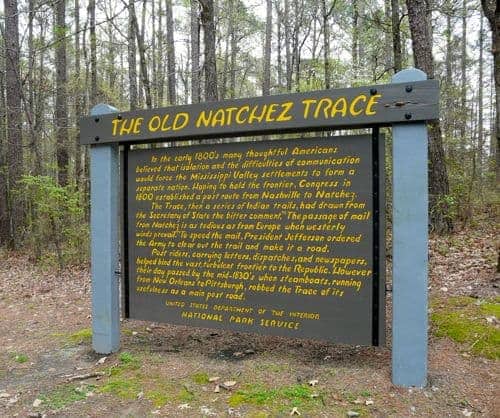
The Trace has been a unit of the National Park System since 1938.
The Parkway can be driven in two days, but why hurry? Take your time by stopping at all of the pullouts, taking short hikes and exploring nearby communities.
Nashville, Tennessee and Natchez, Mississippi are the end points of the Natchez Trace. Those traveling south will begin in Nashville and end in Natchez. For drivers motoring north, the road begins in Natchez and travels north to Nashville.
The road is mostly posted at 50 mph, however some sections have a lower speed limit. This is a road for taking it slow and enjoying your surroundings so don’t hurry the trip.
You won’t find any lodging on the Natchez Trace Parkway itself, except for three primitive campgrounds. However you’ll find bed and breakfasts, inns and hotels in nearby communities. Take the opportunity to explore while you’re there.
Active travelers will enjoy biking on the Parkway. Horseback riding, fishing and hiking are other options. Hiking trails vary in length but include short paths that travel the original Trace.
In spring, you’ll enjoy flowering dogwoods and wildflowers. Fall offers a colorful scene from the changing leaves. Summer is hot and humid on the Parkway.
Many thanks to Mississippi Tourism, especially Visit Tupelo, Visit Jackson, Visit Natchez, and Visit Vicksburg for their support of our Natchez Trace road trip. For more information and tourist tips visit their websites.
Save to Pinterest

Scratch those itchy travel feet!
Boomer travelers rely on our weekly email newsletter for fresh travel inspiration, tips, and advice. It's free! No spam, unsubscribe anytime.
You may also like

Natchez Trace Parkway Highlights: 4-Day Road Trip Itinerary
Purchases made through some links on this page may provide The Detour Effect with commissions (at no extra cost to you). Thank you!
Most American travelers are familiar with famous scenic driving routes such as the Blue Ridge Parkway , Route 66, or the Beartooth Highway, but when I’ve shared stories of my experience driving the Natchez Trace Parkway, the common response has been, “what’s that?”
The Natchez Trace Parkway is a 444 mile national scenic byway through Tennessee, Alabama, and Mississippi that follows the path of the “Old Trace,” a historic walking and wagon trail developed in the 1800s. The Old Trace was roughly based on original Chickasaw and Choctaw footpaths, but was repurposed by colonists as a postal, military, and trade route. Merchants who sailed their goods down the Mississippi River would sell their boats for lumber in Natchez, Mississippi, then walk the Trace back north to get home (where they might contend with robbers or hostile run-ins with indigenous people). “Coffles” of enslaved people were marched down the Old Trace to be sold at market. Soldiers in the War of 1812 followed Andrew Jackson up and down the Trace, and used it to return home after their victory at the Battle of New Orleans.
When you drive the parkway from Nashville to Natchez today, you’ll have opportunities to pull over at historical markers, ghost towns, ancient Native American earth mounds, remnants of 1800s traveler’s “stands” or inns, waterfalls, state parks, and even recent landmarks related to rock’n’roll legends. The Natchez Trace is a tangible journey through eons of American history in the Deep South.
It’s hard to narrow down which road trip stops to choose from all the options! This Natchez Trace itinerary pinpoints the top highlights you shouldn’t miss while driving the parkway over four days, plus additional sites you could fit in depending on your interests and priorities. If you only have three days, you could easily combine days three and four of this itinerary. If you have more than four days, you could spend extra time in Nashville, Franklin, Leiper’s Fork, Jackson, Tupelo, Natchez, or take a detour to Vicksburg.
Click the icon at the top left of the map to see other map layers, such as restaurants along the Natchez Trace.
How to pronounce “Natchez” : Having been born in Texas, I really want to pronounce Natchez similar to how we would pronounce the Neches River, like “naychis,” or at the very least I’m tempted to go for “natch-ehz” with a Spanish flair on the end. Both would be wrong. A common rule of thumb is to remember that the town of Natchez, Mississippi is pronounced by local southerners as if it rhymes with “matches.” However, the indigenous Natchez tribe would pronounce it differently. “The –chez portion of Natchez was kind of a Frenchized version on paper of what the French people were hearing when they encountered the Natchez Indians. The Natchez people who are in Oklahoma pronounce it ‘Notchy.’” – Jim Barnett, director of the Grand Village of the Natchez Indians .
Getting to the Natchez Trace Parkway
Most people will drive the Natchez Trace north to south, beginning in Nashville and ending in Natchez. This is mainly because Nashville is easily accessible from most other points in the country. However, if you choose to drive south to north from Natchez to Nashville, this will mirror the journey merchants would have taken to get home after sailing their wares down the Mississippi. People would have walked the Old Trace in both directions for different purposes, so either way would be historically “correct.” It’s up to you!
I approached the Natchez Trace from Colorado, so I paired this road trip with other fun stops in Kansas and Missouri before making my way south to begin the Trace in Tennessee. This added valuable context for me because I saw Cahokia , the largest Native American earth mound city north of Mexico. There are many earth mounds along the Natchez Trace and seeing the foremost example of such mounds, Monk’s Mound in Cahokia, really informed my understanding of them. I also visited Mark Twain’s hometown of Hannibal, MO , which lies along the Mississippi River. His books about adventures on this river have contributed to Americans’ national identity, and he undoubtedly navigated its waters to and past Natchez.
Prior to your trip, be sure to check the latest Alerts and Conditions on the Natchez Trace Parkway official website. Some historical sites or sections of roads may be temporarily closed.
When is the best time of year to drive the Natchez Trace Parkway?
Autumn is the best time of year to drive the Natchez Trace Parkway if you want to see the beautiful fall colors dominating its miles of untouched forest land. Fall is also when the Natchez Balloon Festival and Natchez Pilgrimage take place (there is a spring version of the Pilgrimage too)! The scenic drive is extremely pleasant and relaxed any time of year because it has low traffic and is heavily tree-lined and cozy, but when I drove it in winter, the lack of leaves and occasionally overcast skies gave it a slightly creepy tone. This also has its benefits; it depends on what you’re looking for.
In winter, because the leaves had fallen, I could see back behind the first rows of roadside trees in order to understand how truly deep the wilderness goes and how alone 1800s travelers must have felt while enveloped by it. If you’re someone who enjoys dark tourism , there will be plenty of ghost towns and cemeteries along the Trace to interest you, and going during a drearier time of year like winter will highlight their gravity. If you’re looking for a travel destination in the United States to escape colder climes in the winter, the Natchez Trace is a good choice, but don’t expect it to be like summertime there. It can still get cold – just not as cold as the northern states.
If you are excited about the waterfalls, you might consider spring or summer when they’ll be flowing more heavily. If you are camping, nights will be warmer in spring and summer. I was comfortable car camping on the Trace in winter, but I have a super warm 0 degree sleeping bag. The parkway might be slightly more touristed in summer than winter, but I would guess not by much. I hardly saw another soul throughout my winter trip and have heard that it’s pretty lowkey in summer too – the Natchez Trace is underrated!
Road conditions and amenities on the Natchez Trace Parkway
The road itself is smooth and in fantastic condition. There is nothing harrowing about driving the Natchez Trace, as it’s mostly flat and you will not be on precarious mountainsides. You only thing you might contend with is weather. The area can experience heavy rains and maybe even a freak snow storm and icy roads every few years.
Note that in order to maintain the integrity of the historic Trace, there are very few modern buildings or amenities directly along the road. I really enjoyed this; I can’t remember another time I’ve been able to “unplug” in this way on a road trip! I don’t recall any gas stations or cafes, though a few times I could pick out homes or farms buried back behind the trees. There are no advertisements, billboards, or stop lights, but there are wooden road signs signaling when to pull over for historic monuments and hiking trails. One thing you can rely on is that there are plenty of well maintained NPS restroom facilities all along the Trace.
You will need to get off the Trace and visit nearby towns for food and gas, which is easy to do. You may feel quite isolated and far from civilization while on the byway, but in reality it should rarely take more than 10-15 minutes to find a community if you drive off the Trace. I usually had good enough cell service for my maps app to guide me to the closest gas station, but I did lose service often enough that it’s a good idea to start thinking about where to fill up before you get into a “last minute” situation. You should also pre-download music and podcasts in case you lose service.
Camping and accommodations on the Natchez Trace Parkway
There are three free campgrounds along the Natchez Trace Parkway and they are perfectly evenly spaced so that you could stay in one each night on a four-day trip! They are the Meriwether Lewis Monument Campground , Jeff Busby Campground , and Rocky Springs Campground . In Natchez there are paid campgrounds, or you could choose a proper hotel.
These first-come first-serve free campgrounds have bathrooms, picnic tables, and potable water, but no showers, electricity, or dump stations. Campers can stay for up to 14 days.
If you prefer hotels across the board, you can stay in Hohenwald, TN or Florence, AL the first night, Tupelo, MS the second night, Jackson, MS the third night, and Natchez, MS the last night (if you’re not getting a head start on your journey home at the end of day four).
Day 1 Highlights on the Natchez Trace: Tennessee
The northern terminus of the Natchez Trace Parkway begins near Loveless Cafe in Nashville, Tennessee. This is convenient because Loveless Cafe is a very popular spot for southern comfort food – if you plan ahead. I tried to go without a reservation and it would have been an hour wait! Luckily you can grab a quick and easy bite at the Biscuit Kitchen next door instead.
Double Arch Bridge at Birdsong Hollow
Sometimes referred to simply as the Natchez Trace Bridge, this double arch architectural feat at Birdsong Hollow is the first stop that greets you soon after passing the Natchez Trace Parkway northern terminus entrance sign. Built in 1994, it received the Presidential Award for Design Excellence and is quite impressive in-person. Pedestrians can’t be on the bridge, but there is a convenient pull-off just before you drive over it where you can park and walk a short trail to a photography viewpoint.
War of 1812 Monument
When I set out to begin my Natchez Trace drive, my top priorities were the Native American earth mounds and Old Trace stands/inns. I’m not typically interested in war history and have never visited any battlegrounds. That said, war related monuments along the Trace did end up luring me, starting with this stark War of 1812 monument.
It’s just a stone pillar erected to honor fallen soldiers on the Trace, but something about it struck me. I had seen no-one else on the lonely parkway yet, and I was the only person at the monument. It was very quiet, and while reading about the hardship they endured while marching along the Trace, I looked around in each direction through the trees and tried to imagine what it must have been like in their shoes. I would have this opportunity for reflection countless more times on the Trace.
Gordon House
Unlike many buildings of the time, the brick home of Captain John Gordon, built in 1818, is still standing today. It was situated directly along the Old Trace and would have been a welcome sight for travelers who needed to use Gordon’s ferry service to cross the Duck River. Gordon served in the War of 1812 and the Seminole War, and was praised by Andrew Jackson himself.
In addition to viewing the house from the outside, visitors can also walk down to the ferry site. At least, you’re supposed to be able to, but I found this walk confusing. While attempting to read the (unreadable) information sign in front of the house, there is an obvious trail to your right which goes into the woods. I went this way for awhile before realizing it wasn’t correct. While facing the information sign, it turns out your back is facing the correct direction of the trail. You need to walk down the big hill into a clearing, where you’ll find a path into the trees which leads to a creek called Fattybread Branch ( map here ). If you are able to cross this creek, you can continue on the Old Trace until you reach the ferry site on the Duck River. I didn’t see an obvious way to cross the creek without sloshing in the water a bit, which would have been fine and not dangerous, but I knew I’d be visiting Colbert Ferry the following day and decided not to continue searching for Gordon’s Duck River ferry. The house itself was the main draw.
Baker Bluff Overlook
Shortly after Gordon House, there is a place to pull over on your left for the Baker Bluff Overlook. This is a quick stop to take in a pretty view of the surrounding landscape. I found some of the other panoramic viewpoints throughout the Trace a bit underwhelming in wintertime (forest overlooks might be nicer when the leaves are colorful in autumn), but this one was worth it.
Fall Hollow Waterfall
Between Jackson Falls and Fall Hollow, I much preferred Fall Hollow because it had a heavier stream. Jackson was barely dripping and had frozen icicles during my visit. If you have time to do both though, there is some interest to Jackson Falls. For that one you’ll follow a paved walkway down into a deep canyon and watch the water pour into it from the rim.
After Jackson Falls, drive on to Fall Hollow. The Fall Hollow site has two different falls. When you park and begin the walking trail , you’ll pass the first trickle almost immediately. Continue past this for the more impressive one. You’ll first walk by its source, and then the trail will bring you down to the base of the fall. The descent to get there may be a bit slippery, but it’s short. Just take your time; the view from the base of the fall is cooler than from the top! Once you’re down there you’ll also have a new perspective on the first fall.
Meriwether Lewis Monument and Grave Site
If you’re camping, you’ll end your first day on the Natchez Trace at the Meriwether Lewis Monument and campground near Hohenwald, TN. Grinder’s Stand was located here, a place where weary travelers could book accommodation and a meal. It’s where Meriwether Lewis, of Lewis and Clark Expedition fame, had the last meal of his life in October of 1809. Late at night the sound of two gunshots rang out, and in one account, a cry for help, but no-one investigated. By morning, Lewis was dead in a log cabin. A replica of this cabin can be seen today. He was buried only a few hundred yards away, where a gravesite monument marks the spot.
The circumstances surrounding his death were mysterious; it was hastily ruled a suicide, but because there were two shots and his money was missing, some historians are not so sure.
A “stand” was like an inn and safe haven where traveler’s could rest, eat, and (attempt to) take sanctuary from potential dangers on the trail. As a long distance hiker myself, I know what a relief it is to arrive at a refuge or mountain hut!
Other potential stops on Day 1
- Jackson Falls : Read above in my explanation of Fall Hollow.
- Old Trace Walk : You will have many opportunities to stretch your legs and walk on surviving sections of the Old Trace throughout this entire road trip.
- Devil’s Backbone State Natural Area : A 3-mile hiking trail for nature lovers.
- Leiper’s Fork, Tennessee : A cute village for those who love shopping, antiques, and galleries.
- Franklin, Tennessee : A Civil War battle took place here and there is a lot to see in historic downtown Franklin. You can take tours of three Civil War era homes, including Carter House, Carnton, and Rippa Villa. Taking a detour to Franklin requires getting off the Natchez Trace.
- The Natchez Trace Parkway website has a list of everything you can see on the Tennessee section of the drive here .
Where to stay, end of Day 1
- Free camping at Meriwether Lewis Monument.
- Hotels in Hohenwald, TN or Florence, AL . There are some good breakfast spots in Florence and a fancy dinner place called Odette .
Day 2 Highlights on the Natchez Trace: Alabama and Mississippi
You have a couple options on how to start Day 2. You can begin by driving from your campsite at Meriwether Lewis Monument towards Sunken Trace and Colbert Ferry. After Colbert Ferry, get off the Trace in order to visit Muscle Shoals. Then retrace your “steps” back to the Trace and continue on to the Native mounds. Or, after Sunken Trace, get off the Trace and head straight into Florence, AL and Muscle Shoals, then visit Colbert Ferry afterwards. If you are planning to have breakfast in Florence/Muscle Shoals, that may decide your timing.
Sunken Trace
There are two pull-offs called “Sunken Trace”; the second one will come on Day 4. At this site, you can still make out three parallel paths where travelers tried carving different trails to get their wagons through the muddy, waterlogged, and “sunken” terrain. It’s a quick stop where you can pretty much look at the three paths, say “yup,” and then keep on your way, so not everyone may be interested in prioritizing this one. Personally, I think landscape archaeology is really cool. I get a kick out of being able to see cuts from pioneer wagon wheels still leaving their mark on the forest.
Muscle Shoals Sound Studio
Like Abbey Road, Electric Lady, and Sun Studio, the iconic Muscle Shoals Sound Studio is known to music fans around the world. Artists including The Rolling Stones, Lynyrd Skynyrd, Cher, Bob Seger, Aretha Franklin, Paul Simon, and the Staple Singers recorded there. More recently, The Black Keys and Lana Del Rey have added to its history.
Muscle Shoals was known for the iconic “swampy” sound of the studio musicians who accompanied the artists who recorded there. This backing band ultimately became known as The Swampers.
Today when you visit the studio, you can take a $20 guided tour which is offered every hour on the half hour from 10:30am to 3:30pm. The tour I took was guided by the sound engineer Chase, who provided a lot of context for the “artifacts” in the studio. I put artifacts in quotes because Muscle Shoals is still a working studio, and Chase said they don’t clear out any of the historic instruments or furniture when modern artists come in to record!
Bob Seger’s song “Old Time Rock & Roll” was recorded using that Yamaha piano pictured in my gallery. Lynyrd Skynyrd’s Billy Powell wrote the piano part on “Freebird” on that Yamaha as well, though it was ultimately recorded elsewhere. The Swampers’ bassist David Hood had a special corner of the room where he always played; can you pick out David’s corner from my gallery? In the Staple Singers song “I’ll Take You There,” Mavis repeats the phrase “little David” a handful of times, a reference to David Hood.
Colbert Ferry
George Colbert ran a stand and ferry on the Tennessee River from 1800-1819. Andrew Jackson and his soldiers crossed the river via this ferry on their return from the Battle of New Orleans. Unfortunately the stand itself no longer exists, though you can see the clearing of land where it would have been located and look out over the riverbank to imagine how useful the ferry dock would have been before the bridge was built.
Colbert had a Scottish father and a Chickasaw mother and was bilingual, so he was the perfect person to run a business that catered to many types of travelers along the Trace. When the Chickasaw people negotiated the treaty allowing the Americans to transform the Natchez Trace into a road through their lands, they did not give Americans all rights to the region. Colbert, as a member of the Chickasaw nation, retained the right to run this ferry (if you’re wondering why Gordon was allowed to establish a ferry on the Duck River despite not being Chickasaw – he came to a special agreement with Colbert).
Colbert was often referred to as a “chief speaker” representing Chickasaw interests. He traveled and met with presidents, including George Washington, to negotiate additional treaties with the US government. He even served in the Creek Wars and War of 1812. Despite all of this goodwill between cultures, ultimately he and his people were removed from their lands and forced to march towards Oklahoma on the Trail of Tears.
Pharr Mounds
The Pharr Mounds site is particularly scenic. You will look out over a large, idyllic meadow dotted with a collage of hay bales and Native American earth mounds. Eight of them, built and used about ~1-200AD during the Middle Woodland period, are spread over 90 acres. According to the National Park Service, some of them are burial mounds. You can read about the archaeological excavation of Pharr Mounds here .
For context throughout the rest of the trip, you may find this chronological timeline of all the Natchez Trace mounds or this list by milepost helpful.
Graves of 13 Unknown Confederate Soldiers
Just outside of Tupelo, pull over to embark on a short 5 minute walk into the woods where you’ll find the grave markers of 13 unknown Confederate soldiers. Their final resting place is quiet and isolated, another opportunity to imagine what life might have been like for infantry who contended with unpredictable conditions in an America yet to be fully developed. Perhaps these soldiers died of exposure, untreated injury, or disease. This is also a place to reflect on the principles this country was (or wasn’t) founded on, and on whose backs.
Civil War soldiers didn’t rely on the fading Trace as much as War of 1812 soldiers did, but they clearly found themselves on sections of it. As a result, some of them, these thirteen at least, died on the same trail that enslaved people would have been forced to march down in order to be sold at market in Natchez. Considering many Confederate soldiers fought to keep slavery alive as an institution, there’s some irony there.
After seeing evidence of beautiful indigenous villages, stops like this juxtapose and cut through the charm of the Old Trace to remind you that the subsequent societies we built on top of them and the belief systems we imposed were not much of an improvement.
Note : On my Apple Maps app, there is a site called “Confederate Gravesites and Old Trace” that sits right on the Trace, and nearby there is another site called “Old Trace Confederate Cemetery” in the woods. If you put the second one into your device, it will take you on a weird suburban backroad where you can spot the back of the cemetery through the woods but you can’t park anywhere. Choose the first option, which has a pull-off parking spot.
Unfortunately, because of European influence, Chickasaw and Choctaw people also bought, sold, and owned African slaves. They continued this practice after their removal to “Indian Territory” on the Trail of Tears and even after slavery ended with the Civil War. Owning slaves was one criteria for acknowledgement as one of the “ Five Civilized Tribes .”
Elvis Presley Birthplace
Considering Tupelo, Mississippi is pretty much known for one thing and one thing only, it would be a shame to pass through without paying homage to The King!
Elvis Presley was born on January 8, 1935 in a small house built by his father, grandfather, and uncle in Tupelo. His twin brother was stillborn. His father Vernon had been loaned $180 to build the house but was not able to repay the loan, so the family was forced to move out when Elvis was 3 years old. They bounced around different residences in Mississippi until they moved to Memphis, Tennessee when Elvis was 13 years old. When he became successful, he ultimately bought Graceland in Memphis.
That first house is still standing in Tupelo, and you can actually go inside. With only two rooms, it reminded me of the historic 1800s stands that used to dot the Trace, which threw my sense of chronology for a loop. Elvis’ heyday was really not that long after the removal of Native American tribes from their ancestral homelands, and not that long after the end of slavery. In the other direction, Elvis died only 15 years before I was born, so I suppose my own lifetime is not that far removed from these events either.
There is also a museum on the grounds featuring stage clothes and casual clothes that Elvis wore, concert ticket stubs, artifacts that speak to the technology of the time, and contextual information about what it would have been like for their family to live “on the wrong side of the tracks” in Tupelo in the early 1900s. It is a small museum, so perhaps if you’ve already been to other Elvis-themed tourist attractions you might find it redundant, but as an Elvis “newb” I thought it was a great collection and very informative.
You can also visit the church the family would have worshiped at. Since the ticket is more expensive if you visit all three buildings, I opted out of including the church. It’s $10 to visit one site, $15 to visit two sites, and $20 to visit all three. I chose the house and the museum .
Other potential stops on Day 2
- Alabama Music Hall of Fame : I was satisfied with my visit to Muscle Shoals, but if you want to dig deeper into regional music history, this museum is highly rated.
- Bear Creek Mound : This mound sits right on the border of Alabama and Mississippi and is one of the later examples from about 1100 CE. Prior to the mound, this was a village site with history dating back to 8000 BC. I think every mound is worth a stop, but this one is quite small compared to the others, and partly reconstructed after excavations . If you are trying to prioritize only a few Native American mounds, I would pick Emerald Mound, Pharr Mounds, and Bynum Mounds.
- Tishomingo State Park : Tishomingo was the last Chickasaw chief and war leader before the tribe’s removal to Oklahoma.
- Chickasaw Village Site : A Chickasaw village once stood here, but there is little remaining evidence. It is more of an interpretive site with some informational signs and depressions in the earth where we can assume structures once stood. They’ve been paved over to highlight the outlines, which seems like an odd choice from a preservation standpoint.
- Natchez Trace Parkway Visitor Center .
- Woodall Mountain : If you are a peakbagger, this is the tallest peak in Mississippi at 806 feet.
- Rock Spring Nature Trail : This is just over the river on the opposite bank from Colbert Ferry. After stopping so long for Muscle Shoals, I wasn’t in the mood to do a walk and wanted to put some driving mileage under my belt to get back on the Trace. I skipped this one, but the peaceful pictures make me regret that a little.
- Tupelo National Battlefield and Brices Cross Roads National Battlefield .
- The Natchez Trace Parkway website has a list of everything you can see from milepost 341.7-249.6 in Alabama and Mississippi here .
Where to stay, end of Day 2
- Free camping at Jeff Busby Campground. There is a nice lookout point called “Little Mountain” that you can check out at Jeff Busby even if you don’t plan on staying to camp, though I think the forested view is probably more impressive when there are leaves on the trees. If you camp at Jeff Busby tonight, then you will pass by Bynum Mounds on the way and I would recommend adding that to your list of stops for today instead of tomorrow.
- Hotels in Tupelo, MS .
As you leave Tupelo behind, you are making your way out of ancestral Chickasaw lands and into Choctaw territory.
Day 3 Highlights on the Natchez Trace: Mississippi
Bynum mounds .
If you stayed in Tupelo last night instead of camping at Jeff Busby, then the Bynum Mounds are your first stop on morning three. The two surviving Bynum Mounds are the earliest examples of Native American earth mounds that you’ll find along the Natchez Trace, dating to the Middle Woodland Period between 100 BCE-100 CE. Human remains were found in the mounds they excavated on this site. I enjoyed this site because you can take a paved walkway up close to the mounds.
French Camp Historic Village
French Camp is so named because it was established in 1812 by Frenchman Louis LeFleur, who ran a stand to accommodate travelers on the Natchez Trace. More businesses set up shop around him, and soon there was a small village. Today about 200 people live at French Camp, in more modern homes of course, but some historic buildings are still standing. Drive or walk a loop road to visit the old blacksmith shop, Colonel James Drane House, the Alumni Museum with Natchez Trace memorabilia, and some kind of barn building that has cute miniature ponies outside! With no-one around to explain, I was confused as to why a seemingly working and active stable was mixed in with the old 1800s log cabins.
Make sure you time your trip so that you aren’t visiting French Camp on a Sunday! I really messed up in this regard. Gift shops and other buildings are closed on Sundays. The quaint Council House restaurant with its consistently well-rated cuisine is a main draw of French Camp, and it’s also closed on Sundays. It’s attached to an 1840s building so that you feel as if you’re experiencing the same hospitality you might have enjoyed in LeFleur’s day. The problem is that the two museums in Jackson are free on Sundays , so if you’re trying to see French Camp and the Jackson museums on the same day, Sunday is both good and bad. You might time it so that you visit French Camp on a Saturday, stay in Jackson overnight, and visit the Jackson museums first thing Sunday morning.
“LeFleur married a Choctaw woman. Their famous son who changed his name to Greenwood Leflore, became a Choctaw chief and a Mississippi State Senator. Named after him are the city of Greenwood and the county of Leflore.” NPS
Cole Creek and Cypress Swamp
The swamps were some of my favorite stops along the entire Natchez Trace Parkway! Having grown up in southeast Texas, I’ve contended with my fair share of mosquito-ridden, hurricane-ravished, smelly swamplands, but the baldcypress and water tupelo swamps at Cole Creek and Cypress Swamp were something else entirely. Rather than rotting, decaying cesspools, these water forests were pristine and elegant. The trees twist and turn like artful sculptures, and the water reflects rainbow color palettes.
There are two separate swamp stops, each with boardwalks that allow you to venture on short interpretive nature trails. The first and shorter stop is Cole Creek, and about an hour’s drive later you’ll come to the longer Cypress Swamp stop. Since I was particularly enchanted by these walks, I would recommend stopping at both, but if you want to prioritize one over the other, go with Cypress Swamp.
As you make your way into Jackson, Mississippi, don’t forget to cue up Johnny Cash and June Carter’s “Jackson” on your radio!
Mississippi Civil Rights Museum and Museum of Mississippi History
These two museums in Jackson are brand new and immaculate.
The Mississippi Civil Rights Museum ’s mission is to “document, exhibit the history of, and educate the public about the American Civil Rights Movement in the U.S. state of Mississippi between 1945 and 1970.” Touring the museum’s eight galleries will teach visitors about Jim Crow Laws, Brown vs. Board of Education , the murders of Vernon Dahmer, Medgar Evers, and Emmett Till, the practice of lynching, the formation of the KKK, the Freedom Riders, the Biloxi Wade-In, and more. The museum also looks back on the experiences of the first enslaved Africans shipped to Virginia in 1619 and Caribbeans brought to Mississippi in 1721.
You could spend hours in this museum, and most people pair it with visiting the Museum of Mississippi History , which covers 15,000 years from the mound-builders to present day. This really puts a lot of what you’ve been seeing along the Natchez Trace into context. Some travelers on the Natchez Trace may want to dedicate an extra day to staying around Jackson to experience both museums fully.
Both museums are closed on Mondays but have FREE entrance on Sundays! Otherwise, general admission includes both museums for $15 per adult.
Jackson is also a good place to stop for lunch. Check out the restaurant layer on my Google Map above .
Rocky Springs Townsite
If you are camping, you’ll end Day 3 at the Rocky Springs ghost town and campground. There is also a hiking trail here if you need to stretch your legs. If you spent a lot of time in Jackson at the museums, you might arrive at your campsite after dark and decide to check out the ghost town in the morning. If you decided to get a hotel in Jackson, then Rocky Springs will be your first stop on morning 4.
Rocky Springs was first settled in the 1790s along the creek that gave it its name. According to the Park Service, 2,616 citizens plus 2,000 slaves lived there by 1860. It ultimately declined for multiple reasons, including crop failure due to a boll weevil infestation, a yellow fever epidemic, and the Civil War.
The only building still standing at Rocky Springs is the old church, which apparently still holds services for surrounding communities (after I posted my pictures of it on Instagram, a friend from Mississippi told me he got married there!). If unlocked, you are welcome to go inside. Behind the church is a cemetery with graves dating throughout the 1800s. I assume some of the people buried there were victims of yellow fever.
Across the trail from the church is a loop walk with information plaques about Rocky Springs. Along this loop you’ll find two metal safe deposit vaults, left behind because they were too heavy to move, I presume, and the remnants of a cistern. One of the safes is the only remaining evidence of the Rocky Springs post office.
Other potential stops on Day 3
- Boyd Mounds : Again, I made an effort to stop at every single mound site, but if I had to recommend visiting only the most impressive, Boyd would not be on that list since it’s quite small.
- Detour to Vicksburg : You’ll need to get off the Trace to visit the U.S.S. Cairo Museum and Old Courthouse Museum. Thoroughly exploring here could add an extra day to your Natchez Trace itinerary. If you do go, check out a self-guided audio tour of Vicksburg here .
- Raymond Military Park : A Civil War battlefield where the Battle of Raymond took place.
- The Natchez Trace Parkway website has a list of everything you can see from milepost 131-249.6 in central Mississippi here .
Where to stay, end of Day 3
- Free camping at Rocky Springs Campground.
- Hotels in Jackson, MS .
Day 4 Highlights on the Natchez Trace: Mississippi
This stop really drives home the meaning of the word “sunken” more than the other “Sunken Trace” stop from Day 2. Where the Old Trace path was soft with loess soil, thousands of walkers, wagons, and riders wore a deep fissure into the ground. I didn’t realize that was the case when I made this stop. At Rocky Springs the night before, signs explained how similar features at the ghost town were caused by erosion, so I thought it was the same situation here. I only parked and took a quick look, but you can join walkers of years past by strolling on this section of the Old Trace.
Windsor Ruins
The Windsor Ruins are not listed on the National Park Service’s official Natchez Trace Parkway website under “things to do” in southern Mississippi, so I’m glad I heard about it elsewhere and was able to work it into my trip!
Construction on Smith Coffee Daniel II’s Greek Revival-style 23-roomed mansion was completed in 1861. This opinion may be in bad taste considering a tragic 1890 fire left only these ruins, but the main draw of Windsor Ruins is how gorgeous the charred and slowly decaying 45-foot pillars look as they tower above your head. As I arrived early in the morning, sunshine glinted through the trees and highlighted the columns from behind, casting long shadows over the grounds. It’s a photographer’s dream.
Mount Locust Stand
Mount Locust is the only surviving stand along the Natchez Trace. By the time you arrive here, you’ve really earned it after seeing so many empty plots of land that require you to squint to imagine where an inn once stood.
Unfortunately, Mount Locust was also a cotton plantation that kept slaves; there is a cemetery behind the stand where 43 enslaved people are buried in unmarked graves. Some of these slaves were likely bought at Forks of the Road market in Natchez, which we’ll visit when we arrive at the southern terminus of the Trace later today.
There is also a cemetery onsite for the white family that ran Mount Locust, featuring much nicer headstones. The same Ferguson-Chamberlain family continued to live on the grounds until 1944. Rick Chamberlain was the last member of the family buried here, and he was the first interpretive Park Ranger at Mount Locust.
When I visited in January of 2024, this alert was on the NPS website: “Due to storm damage the visitor center and restrooms are closed. The grounds, and historic inn and stand will be open intermittently throughout the winter.” I didn’t understand what exactly “intermittent” meant or how to plan around it. When I arrived, the gate to the parking area was closed and I couldn’t drive in. I parked outside of the closure and walked the rest of the way in. I avoided the cordoned off visitor center and restroom block, but continued on to Mount Locust and the cemeteries. I was the only one there. Signs indicated that visitors can enter the stand through the back door, so I walked around back and tried all four doors. I struggled to open three of them and didn’t want to force it. The fourth door opened onto a bedroom with creepy dolls inside. I shut it pretty quickly.
As I made my way back towards my car, two volunteer rangers were walking their dog and found me. I thought I would get in trouble for trespassing, but instead they took me on a private tour of the stand and opened all of the locked doors for me to go fully inside! They taught me more about the history, letting me know the background about Rick Chamberlain, that some travelers would actually sleep underneath the stand, that the high chair in the dining room is thought to be original and passed down through the Ferguson-Chamberlain family for generations, and that some historians belief Mount Locust was built on top of a Native American mound.
Emerald Mound
Emerald Mound is the second largest Mississippian Period Native American temple mound after Monk’s Mound at Cahokia in St Louis . If you only visit one mound on the Natchez Trace, make it Emerald Mound! This one is absolutely massive and has a paved walkway that you can climb to actually get up on top of the first square-shaped flat-topped tier. Once atop this tier, please do not climb up onto the smaller rounded mounds.
Emerald was built and used around ~1300-1600 AD (some sources date the beginning at around 1350 AD and the end as late as 1750. It was built over a prior Mississippian village that existed c. 1200 AD). Cahokia was abandoned circa ~1350 AD. This made me wonder if perhaps Cahokians migrated south and went on to build Emerald? Like Monk’s Mound at Cahokia, Emerald has smaller temple mounds on top of a giant platform mound. Of course, as we’ve learned throughout our Natchez Trace road trip, other mounds were being built all along the Mississippi River Valley since before Cahokia’s emergence.
Grand Village of the Natchez
As travelers arrive at the southern terminus of the Natchez Trace Parkway, they’ll finally enter the town of Natchez, Mississippi.
The National Park Service believes the Natchez are descendants of the Native Americans who built Emerald Mound; when they abandoned Emerald in the 1600s, they established their new capital at the Grand Village site in modern day Natchez. If my theory about Cahokian connections to Emerald is correct, then this was the latest in a long line of southward migration before the Natchez were ultimately removed to Oklahoma reservations, or sold into slavery in the USA and Haiti.
A massive, thunderous storm poured buckets over Natchez on the day I arrived, so I wasn’t able to wander the grounds to check out the mounds, but the indoor museum was free. Here I learned how the Natchez tribe battled against French colonists in the 1700s to protect their homelands. I was also enthralled by accounts of Natchez cultural practices and societal hierarchies written by French ethnographer Antoine-Simon Le Page du Pratz.
The chief of the Natchez was called the Great Sun, and the war chief was the Tattooed Serpent. The person who held the office of Tattooed Serpent was always the younger brother of whoever held the position of Great Sun. The Tattooed Serpent during the time of Le Page du Pratz died in 1725. At his funeral, many of his family members and servants were voluntarily sacrificed along with him, strangled at a temple atop a platform mound. The war chief’s body was carried to this temple on a palanquin, and everyone was buried within and around it.
Forks of the Road
Forks in the Road slave trade “market” operated in Natchez from 1833 to 1863 and was the second largest domestic slave market in the Deep South. Enslaved people were brought here from Virginia, Maryland, Kentucky, and the Carolinas. Shackles and chains embedded in cement on the ground serve to mark the location of Forks in the Road, a particularly heinous reminder of our country’s past.
There is a lot of charm throughout the Natchez Trace Parkway, but by the time I got to Natchez, I struggled to see it anymore. I had no interest in visiting the stately, genteel Old South mansions built from slave labor that are advertised as pretty tourist attractions. They are mixed in with poverty that’s been passed down over generations.
I found the final day on the Trace to be extremely somber. Throughout the Parkway, travelers are physically confronted at every milepost with eons of history, and that history is often traumatic more than celebratory. You watch as beautiful Native mounds stop being inhabited, as enslaved people are forced to build new towns on top of them, and as tombstones of soldiers begin to dot the forest. It made me look around and wonder, “…and for what? So this could take its place? People had to die so that towns like Natchez could exist?” I feel bad talking down on what is many people’s hometown today, but Natchez is quite gloomy. A lot of towns that colonists created in Alabama and Mississippi did not turn out to be some grand wonderland.
While this may sound like a downer of a wrap-up to my Natchez Trace Parkway road trip itinerary, I think it’s appropriate. Elements of this road trip should feel unsettling. We are pilgrimaging through American history, which was not always noble.
Other potential stops on Day 4
- Owens Creek “Waterfall” : This spring would have once been important to the Rocky Springs community, but today it’s just a small trickle. It’s still a pleasant little stop, but a very quick one.
- Mangum Mound : This mound is rather large, and before I got to Emerald Mound, I figured this would probably be the largest example on the Trace. Since Emerald is bigger and you can’t walk on top of Mangum, this one takes a backseat as my second favorite mound of the day.
- Antebellum homes : There are tons of old buildings in Natchez, a few of which you can take tours of. Check out Rosalie Mansion, Melrose Mansion, The Burn, Longwood, Stanton Hall, and St. Mary Basilica. During the Natchez Pilgrimage event held in spring and fall, additional homes are open for tours. Third-party operators also offer history tours in Natchez .
- Natchez Balloon Festival : If you’re in Natchez in autumn, you might be in time for the festival !
- The Natchez Trace Parkway website has a list of everything you can see from milepost 0-131 in southern Mississippi here .
Where to stay, end of Day 4
- Hotels in Natchez, MS .
- There are free campsites 30-60 minutes from Natchez but they aren’t particularly well rated. Staying at one of the paid campgrounds nearby is more convenient.
Driving the Natchez Trace Parkway is so affecting because it’s relatively untouched by modernity and allows visitors to experience history as authentically as possible. There is rarely anyone else around to remind you what decade you’re in. It’s easy to imagine yourself traversing this route in the 1800s, concerned about robbers and the distance to the next stand.
Even if you never step foot in any of the curated museums along the Trace to look at artifacts behind glass enclosures, the roadside pull-offs teach you the same lessons more viscerally. If following my four-day Natchez Trace Parkway itinerary, I guarantee even the most studied historian or ecologist will come away with new perspectives on the peoples and places of the American southeast.
Louisiana: Bonnie & Clyde Ambush Site and Museum
Archaeology travel: ancient mound city of cahokia near st. louis, best moderate difficulty day hikes in the smoky mountains, best easy day hikes in the arkansas ozarks, historic sites in hannibal, missouri: mark twain’s hometown, northern new mexico road trip: bisti badlands, ancestral ruins, western gothic usa road trip stops: “difficult beauty”, things to do in mesa verde national park in winter.
My dream is to write travel and hiking content full-time. All of my guides and itineraries are free and my travels are self-funded. If you enjoy my site and would like to support, you can donate any amount to my Ko-fi page. Thank you!!
Lots of good information! But would be more helpful if you had included the approximate milepost marker number for stop.
Hi John, thanks for the feedback, maybe I will add that. For now, that info is readily available on the official Natchez Trace website if you’re looking to cross reference some of these places with mile markers
Are there bike routes along the Natchez Trace Parkway, or can you only hike? And can you travel here with kids easily?
Hi Trisha, there’s not separate bike lanes or mountain biking trails, but people bicycle on the main driving road. Since it’s not busy most times of year and the road is in awesome shape, I bet it feels pretty safe.
Should be an easy trip with kids since there’s lots of places to pull off and take breaks to stretch your legs and use a bathroom etc! But I guess it depends on the kid; the attractions are mainly historical sites which might be a little boring for some.
This looks so cool, I honestly felt like I had already stepped back in time looking at the photos! Seeing Elvis Presley’s birthplace would be cool too – I feel like he had such an interesting life.
I’ve never heard of this place before reading your article! It sounds like an underrated place to explore. Thanks for sharing your recommendations for this area!
Leave a Reply Cancel reply
Your email address will not be published. Required fields are marked *
Save my name, email, and website in this browser for the next time I comment.

Natchez Trace Parkway
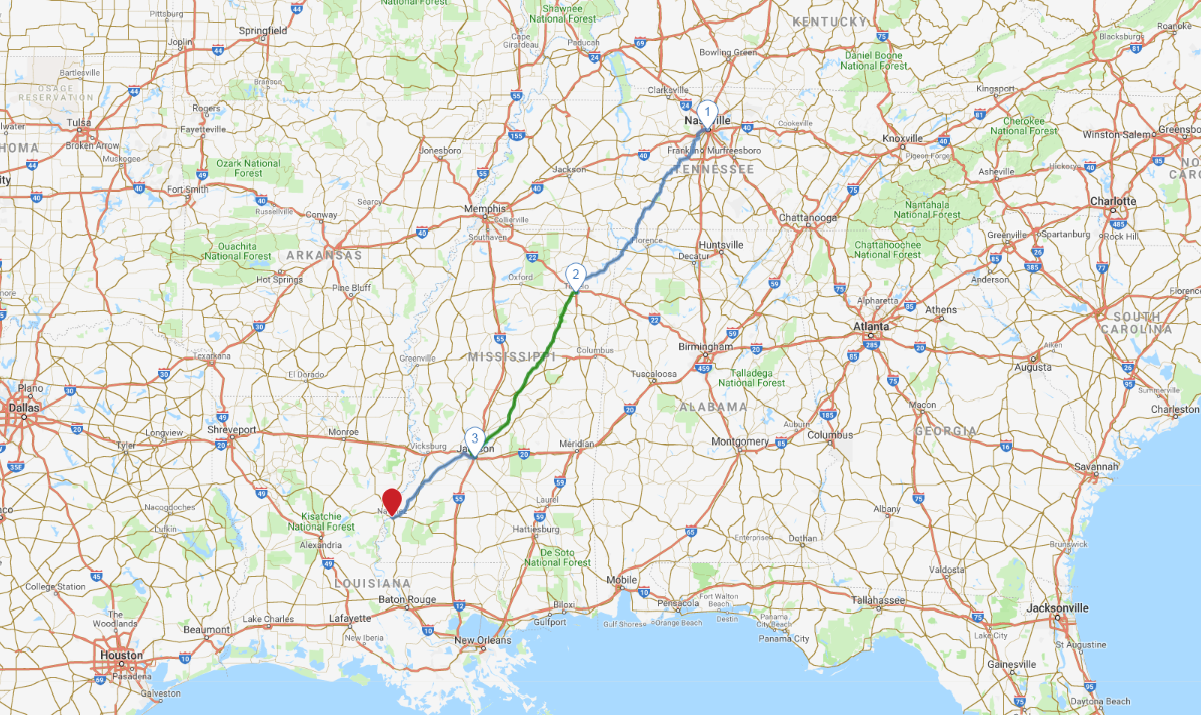

Dora's Corner
Adventurer, Photographer & Blogger
- NATIONAL PARKS
The Natchez Trace Parkway: The Ultimate Recreational Scenic Road Trip Through Three States
- FEATURED POSTS

natchez trace parkway
Table of Contents
The Natchez Trace Parkway – The Ultimate Scenic Road Trip Through Three States
The natchez trace parkway, a 444-mile scenic drive through tennessee, mississippi, and alabama, is a must-visit destination for anyone looking for a beautiful road trip experience. the parkway offers stunning views of rolling hills, forests, and wildlife, as well as a rich cultural history dating back to the native american civilizations that once thrived in the region..

What is the Natchez Trace Parkway?
The Natchez Trace Parkway is a 444-mile recreational road and scenic drive through three states, stretching from the Tennessee Appalachian foothills to the bluffs of the lower Mississippi River. It roughly follows the “Old Natchez Trace,” a historic travel corridor used by Native Americans and European settlers since ancient times. Along the way, visitors can enjoy a variety of recreational activities, such as hiking, biking, horseback riding, and camping.
The Natchez Trace Parkway is a popular recreational road trip because it connects travelers to a unique and rich history, as well as stunning natural scenery. The trail crosses four ecosystems and eight major watersheds, providing habitat for numerous plant and wildlife species.
Along the way, there are sites like Emerald Mound and Mount Locust, which have been preserved as historical landmarks. It is also designated as a National Scenic Byway and All-American Road, allowing travelers to experience the beauty of the landscape at a leisurely pace.
Overall, the Natchez Trace Parkway is a great way to explore a unique and culturally important part of the United States. It gives visitors the chance to experience 10,000 years of history, as well as some of the most beautiful landscapes in the country.
What Is the History of The Natchez Trace Parkway?
The history of the Natchez Trace Parkway dates back many centuries. It originated as a footpath used by Native Americans and early explorers to travel across the region. In the late 1700s, the route was heavily used by Ohio Valley farmers, who floated their goods down the Mississippi, sold their flatboats for lumber, and then returned home on foot.
In 1801, President Thomas Jefferson designated the Trace a national postal road for the delivery of mail between Nashville and Natchez, and by 1820, over 20 “stands” (inns) were located along the route to cater to the increasing traffic.
Established as a National Park System unit in 1938 and officially completed in 2005, the Natchez Trace Parkway commemorates the most significant highway of the Old Southwest. It leads travelers 444 miles through three states and 10,000 years of North American history, bisecting the traditional homelands of the Natchez, Chickasaw, and Choctaw nations.
The scenic Parkway is declared a National Scenic Byway and an All-American Road, and has been chosen as one of America’s 10 best biking roads. Open year-round for motorists, hikers, and bikers, the Parkway provides visitors an unhurried trip through time. It crosses four ecosystems and eight major watersheds and provides habitat for nearly 1,500 species of plants, 33 mammal species, 134 bird species, and 70 species of reptiles and amphibians.
Gen. Andrew Jackson, Jefferson Davis, James Audubon, Meriwether Lewis (who died on the Trace in 1809), and Ulysses S. Grant are among the famous Americans to have traveled the Natchez Trace. Today it continues to be maintained and administered by the NPS, and provides a near-continuous greenway from the Tennessee Appalachian foothills to the bluffs of the lower Mississippi River.
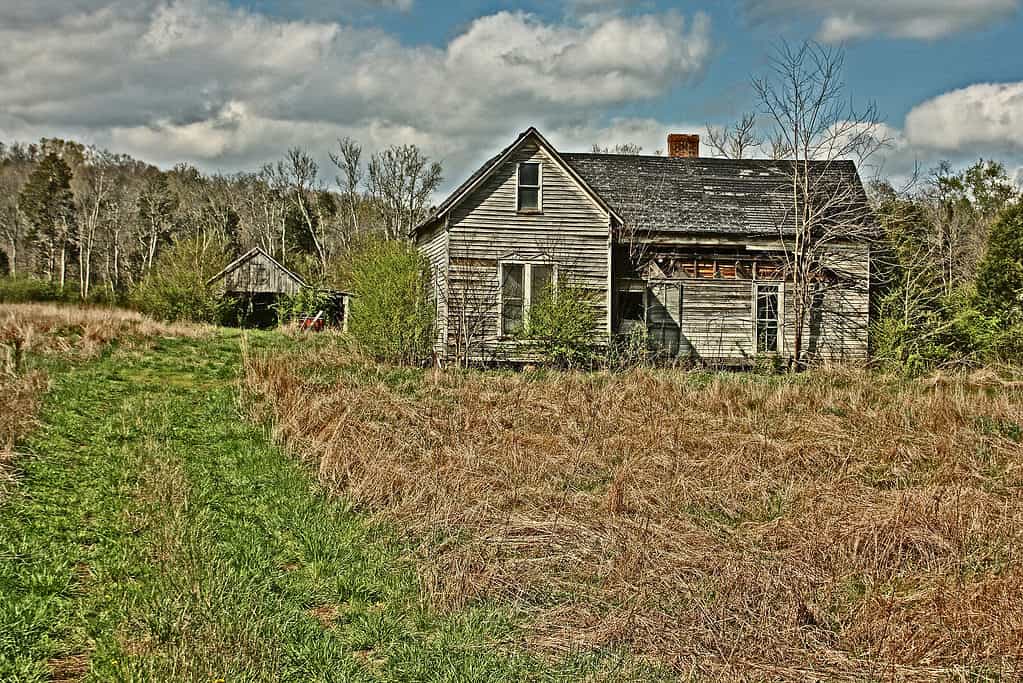
Highlights of The Natchez Trace Parkway for Different Types of Trips
1. old fort pillow state historic site.
The Old Fort Pillow State Historic Site near Florence, Alabama, is a stop on the Natchez Trace Parkway. Located on the Tennessee-Mississippi border, the site commemorates the Civil War battle of Fort Pillow. It features a museum, interpretive exhibits, and a self-guided tour of the reconstructed fortification and earthworks. Visitors can also explore the park’s walking trails, picnic areas, boat launch, and fishing dock, as well as the historic site’s reconstructed hospital, powder magazine, and cannons. There is also an observation deck that overlooks the battlefield.
2. Meriwether Lewis National Monument
The highlights of Meriwether Lewis National Monument include the Meriwether Lewis Monument and Grave Site (milepost 385.9), Fall Hallow Trail (milepost 391.9), Tobacco Farm and Old Trace Drive (milepost 401.4), Trail to Jackson Falls and Baker Bluff Overlook (milepost 404.7), Bridge at Birdsong Hollow (milepost 438), Natchez Trace Parkway Bridge over SR 96 in Tennessee, Rocky Springs Methodist Church, Rocky Springs Cemetery, Cypress Swamp, and the Scenic Waterfall. At this site, visitors can explore the strange circumstances of Lewis’s death, as well as take part in several hiking trails.
To get to the Monument from Franklin, it takes about an hour and a half a day to explore the entire area. Emerald Mound, located just west of the Trace and north of Highway 61 near Natchez, is another important historic site along the Natchez Trace, offering a unique look at the ingenuity and industry of the native culture.
3. Elvis Presley Birthplace
The Elvis Presley Birthplace is a museum and tourist attraction located in Tupelo, Mississippi, at the site of Presley’s birth in 1935. The museum pays homage to the early life of Elvis Presley, providing visitors with insight into the country roots and humble beginnings of the King of Rock Roll. It includes a replica of the two-room house where Presley was born, along with exhibits detailing his family’s life and his early musical influences.
The Elvis Presley Birthplace is a popular attraction along the Natchez Trace Parkway, due to its unique historical significance and its close proximity to other attractions, such as the Tupelo Automobile Museum and the Natchez Trace Visitor Center. Moreover, the birthplace serves as an important reminder of the region’s rich history and cultural heritage, as well as of Presley’s lasting impact on American music and culture. As such, it is an integral part of the Natchez Trace Parkway experience, and an important highlight for both Elvis fans and history buffs alike.
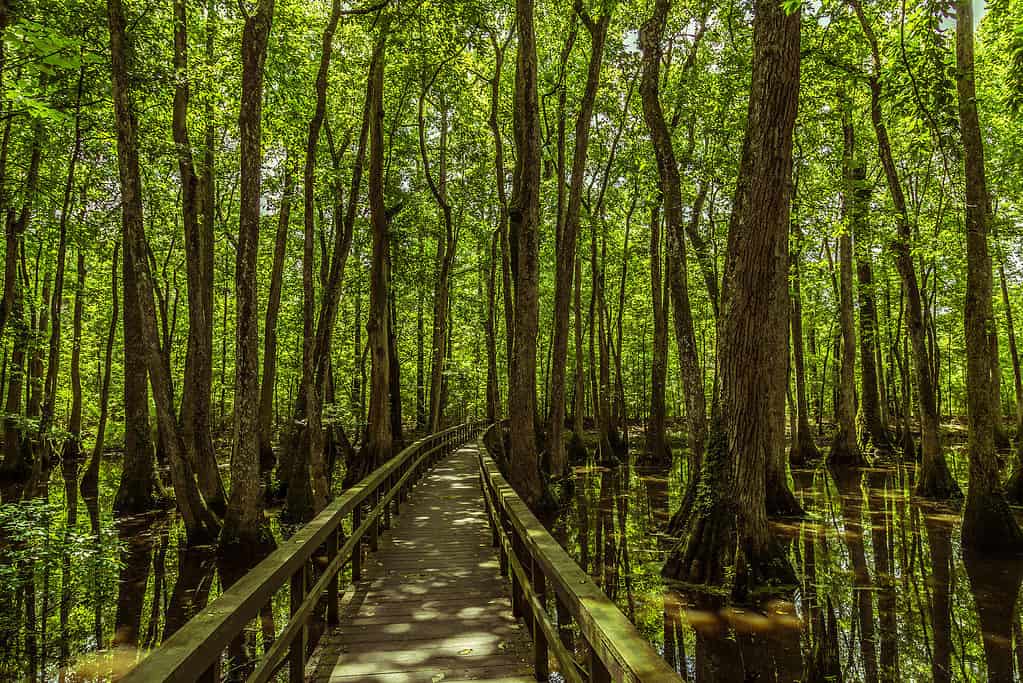
4. The Swampers Exhibit
The Swampers Exhibit at Milepost 122 is a highlight for road trips on the Natchez Trace Parkway due to its stunningly diverse ecosystem. The Cypress Swamp offers visitors a self-guided half-mile tour on a raised boardwalk, offering the chance to spot alligators, a variety of birds and other wildlife. Travelers can also enjoy a unique experience exploring the Ross Barnett Reservoir Overlook, the West Florida Boundary, the Historic settlement of Pigeon Roost, the Bynum Mounds and other unique features of the parkway.
The diverse ecosystems of the parkway provide a unique opportunity for learning about the natural environment, and the Swampers Exhibit is a great way to explore and appreciate the beauty of the area. The exhibit also offers visitors the chance to engage in local arts and entertainment while learning more about the region’s history and culture. The Swampers Exhibit is a perfect way to enjoy the beauty of the Natchez Trace Parkway and make the most of any road trip.
5. Colbert’s Creek
The highlight of the Natchez Trace Parkway at Colbert Creek is Rock Spring Nature Trail, which is site #10 on the North Alabama Birding Trail. This trail is a twenty-minute walk along Colbert Creek and is an excellent place to see ruby-throated hummingbirds feasting on jewelweed nectar in the fall. The Rock Spring Nature Trail can be found at the coordinates 34.869°N, 87.897°W, at an elevation of 330.2 m.
6. Natchez State Historic Site
The Natchez State Historic Site is a 444-mile-long National Park that runs from Natchez, Mississippi to Nashville, Tennessee. It is filled with beautiful scenery and interesting historical sites for travelers to explore. Highlights of the Natchez State Historic Site include:
- Cycling : Enjoy a leisurely bike ride along the Natchez Trace Parkway and take in the sights.
- Camping : Pick a campsite along the Parkway to enjoy a weekend getaway.
- Foliage, Blooms and Wildlife : The National Park is home to a variety of different plant and animal species and is bursting with color during the spring and summer months.
- Hiking : Take a hike on one of the many trails throughout the National Park.
- Interpretive Sites and Exhibits : Check out the many interpretive sites and exhibits along the Parkway to learn more about the history and culture of the area.
- Motorcycling : Enjoy the freedom of the open road on one of the many scenic routes of the Natchez Trace Parkway.
- RVing : Set up camp along the Parkway and explore the area at your own pace.
- The Mississippi River at Sunset : Catch the breathtaking sight of the Mississippi River at sunset from Silver Street in Natchez.
- Longwood : Tour the grand mansion of Longwood, built in the mid-1850s.
- Natchez Under-the-Hill : Take a visit to the historic riverfront restaurants and shops on Silver Street.
- Magnolia Gril l: Enjoy a delicious meal with a view of the river.
- Under-the-Hill Saloon : Have a drink with locals and tourists alike at the saloon.
- The Camp : Grab a burger and a craft beer.
- Roux 61 : Try some Cajun-inspired seafood dishes.
- The Donut Shop : Stop by for a sweet treat.
- Kings Tavern : Enjoy a cocktail, flatbread, and fresh fish.
- Monmouth Historic Inn : Spend a night in this 1818 inn and feel like you’ve stepped back in time.
- Dunleith : Stay in this 1856 mansion and explore the grounds.
- Adventure Awaits : The Natchez Trace Parkway offers so many opportunities for outdoor recreation and sightseeing.

7. The Muscles Shoals Sound Studio
The Muscle Shoals Sound Studio is a recording studio located in Sheffield, Alabama that is renowned for producing some of the most influential music of the 20th century. Founded in 1969 by four session musicians, the studio has seen the likes of Aretha Franklin, Willie Nelson, and the Rolling Stones record some of their most famous songs. The unique sound of the studio has been attributed to its naturally reverberant acoustics, which gives the music a distinct, warm tone.
The Muscle Shoals Sound Studio is a highlight of the Natchez Trace Parkway for several reasons. Firstly, it is a symbol of the deep musical roots that have been cultivated in the south and is a highly respected studio in the music industry. Secondly, it is a great example of how a small community can have a major impact on the cultural landscape of the United States. Lastly, it is an inspiring reminder of just how powerful music can be in uniting people and driving social change.
8. RCA Studio B
RCA Studio B on the Natchez Trace Parkway is a Nashville music landmark and an important part of country music history. Opened in 1957, it was the first recording studio of its kind in the South, and was home to the legendary “Nashville Sound music” of country music. The studio was the site of some of the most iconic and influential recordings in the history of country music, by artists such as Elvis Presley, Dolly Parton, and Roy Orbison.
The studio was also influential in the development of what is now known as the Nashville Sound, a mix of country, pop, and classical music that was popularized by some of the genre’s greatest stars. This style of music was developed in the 1950s and 1960s at RCA Studio B, and helped to propel Nashville’s music industry to the heights it is at today.
The significance of RCA Studio B is not only in its place in country music history but also in its location. It is on the Natchez Trace Parkway, a historic route that was used by Native Americans and early settlers, and is now a popular tourist destination. The studio’s location has made it a tourist attraction in its own right, and has helped to bring attention to the Natchez Trace Parkway, which is now a National Scenic Byway.
There is no doubt that RCA Studio B on the Natchez Trace Parkway is an important part of country music’s history, and has contributed to the genre’s growth and evolution. The studio has also helped to bring attention to the Natchez Trace Parkway, which is now a popular tourist destination. Its influence on the Nashville Sound, and its importance to both country music and the region, make it an interesting and important part of the history of the United States.
9. Shiloh National Military Park
Shiloh National Military Park, located at milepost 385.9 of the Natchez Trace Parkway in Hohenwald, Tennessee, is a national monument to honor Meriwether Lewis. It is managed by the Shiloh National Military Park and includes various highlights that honor the historic site and Lewis’ mysterious death. Highlights of the park include the grave marker for Lewis, the Grinder’s Stand where he stayed during his travels, and the landscape of the area, including the areas where the Battle of Shiloh took place in April 1862. Visitors can also explore the original Union and Confederate earthworks, the historic Shiloh National Cemetery, the Shiloh Indian Mounds, and the Shiloh Interpretive Center.

10. The Trail’s End Museum
The Trail’s End Museum is a popular stop for road trips along the Natchez Trace Parkway because it offers a comprehensive look at the history, culture, and natural beauty of the area. Located at Milepost 266, the museum features a bookstore, nature center, informational video, knowledgeable park rangers, and a hiking trail that leads to a nearby Chickasaw Village site. Visitors can explore the historic tobacco barn, which is a visible landmark that helps people find the two-mile, one-way drive along the Old Trace trail.
As they travel the bumpy dirt road, they will get to experience the beautiful views of the valley and get a taste of what it was like to travel to the Old Trace. Additionally, the museum offers a great range of activities, from the Emerald Mound, one of the largest Indian temple mounds in the United States, to Timberland Park, which has cozy interpretive centers and lovely trails.
Further along the Trace, visitors will find the Donut Shop with its delicious donuts, the Jackson Falls with its striking view, and the Monument and Grave Site of Meriwether Lewis. All in all, the Trail’s End Museum offers truly remarkable and unforgettable experiences that are sure to make any road trip even more memorable.
What Is the Best Way to Explore the Natchez Trace Parkway?
The best way to explore the Natchez Trace Parkway is to drive down the two-lane road and experience its beautiful sights, diverse wildlife, and historical sites. Start in Nashville, Tennessee, and make your way south to Natchez, Mississippi. Along the way, there are numerous attractions to explore such as interpretive sites, scenic overlooks, campgrounds, trails, and waterfalls. Be sure to check out the 18 different communities with tasty local cuisine. You can also take an enjoyable cycling or hiking trip, or even go camping or RVing. Whatever you choose to do, you won’t be disappointed with the wild beauty of the Natchez Trace Parkway.
Natchez Trace Parkway: Camping
Camping along the Natchez Trace Parkway offers a variety of options, from bed and breakfast establishments to hotels and park campgrounds. The National Park Service operates three campgrounds within the parkway boundaries:
- Rocky Springs (Milepost 54)
- Jeff Busby (Milepost 193.1)
- Meriwether Lewis (Milepost 385)
Campgrounds on Or Adjacent to The Parkway

Source: National Park Service

What Landmarks Can Be Found on The Natchez Trace Parkway?
Along the Natchez Trace Parkway, you can find many landmarks, including the Natchez Trace Parkway Bridge (Milepost 438), Jackson Falls (Milepost 404.7), a Tobacco Farm and Old Trace Drive (Milepost 401.4), the Meriwether Lewis Monument (Milepost 385.9), Rock Spring Nature Trail (Milepost 330.2), Colbert Ferry (Milepost 327.3), Tishomingo State Park (Milepost 304), Donivan Slough (Milepost 283), Natchez Trace Parkway Headquarters Visitor Center (Milepost 266), Bynum Mounds (Milepost 232.4), a Cypress Swamp (Milepost 122), the Ross Barnett Reservoir (Milepost 105.6), the Sunken Trace (Milepost 41.5), and the Mount Locust Inn and Plantation (Milepost 15.5). At the end of the Parkway is Natchez, located at the Mississippi River.
Final Thoughts
The Natchez Trace Parkway is a must-visit destination for anyone looking for a beautiful and historic road trip. With its stunning views, rich cultural history, and opportunities for outdoor adventure, the parkway is an unforgettable experience that will leave you wanting to return again and again.
Happy Trails,

Traces Through Time: Natchez Trace Parkway
Read more…
Leave a Reply Cancel reply
Your email address will not be published. Required fields are marked *
Save my name, email, and website in this browser for the next time I comment.
Related Posts
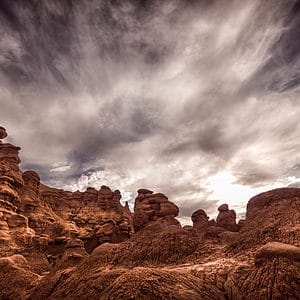
Goblin Valley State Park: A Natural Playground for Hikers, Climbers, and Adventurers
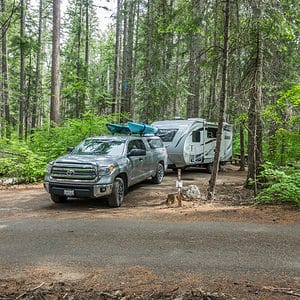
The Ultimate Guide to RV Campground Etiquette: Navigating the World of RVing with Respect and Civility

Capitol Reef National Park: What’s There, Where to See, and Things to do in Utah’s Last Wilderness
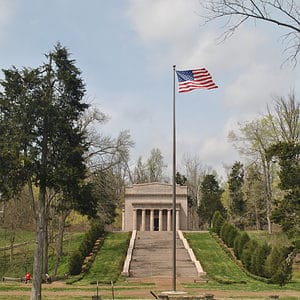
Abraham Lincoln’s Birthplace: Abraham Lincoln Birthplace National Historical Park
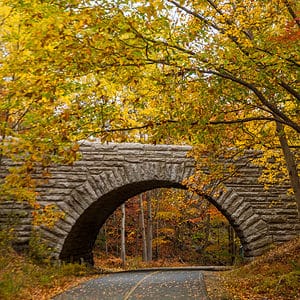
Acadia National Park: Things to do, Attractions, and History in Bar Harbor, Maine

Things to Do at Congaree National Park: Camping, Hiking, Boating, and More
Trending now.

Juke Joints: An In-depth History, From the Past to the Present

Black Bear Pass: The Most Scenic AND Dangerous Road in Colorado
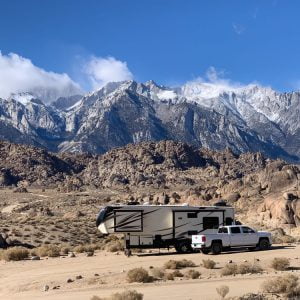
FREE CAMPING 101: How to Find Free Camping on Public Land
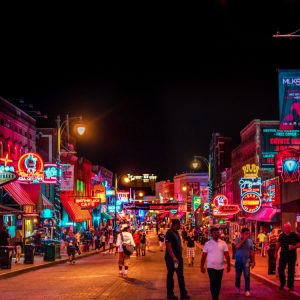
Beale Street Blues: A Guide to Memphis’ Legendary Beale Street
You may have missed.

The Natchez Trace Parkway Guide
Natchez guide, general tips, places to visit, the loveless cafe, natchez trace parkway bridge, leipers fork, water valley overlook, john gordon house, bakers bluff, jackson falls, tobacco farm, fall hollow falls, meriwether lewis monument, old trace dr, glenrock branch, rock springs nature trail, natchez trace parkway lauderdale park, colbert ferry park, natchez trace parkway, tishomingo state park, pharr mounds, old trace and confederate gravesites, tupelo national battlefield, bynum mounds, jeff busby park, french camp, river bend picnic area - natchez trace, cypress swamp, boyd site, natchez trace parkway, rocky springs, owens creek waterfall, sunken trace, mount locust, emerald mound, old trace exhibit shelter.
See your itinerary and your map in one view: no more switching between different apps to keep track of your travel plans.

30 Great Stops on the Natchez Trace Parkway
The Natchez Trace Parkway is a 444 mile National Scenic Trail that stretches from an area southwest of Nashville all the way to Natchez, Mississippi. Not only is the Natchez Trace a history lovers dream, but it is also perfect for those who love beautiful scenery and road trips. There are so many historical and recreational stops on the Natchez Trace Parkway! Honestly, it can be overwhelming when you realize that there are approximately 90 marked stops on the Natchez Trace Parkway.

Of course, everyone is going to have their own opinion about which they think are the best…but in this post I am going to share mine! I have tried to include a variety of historical, recreational, and cultural places in this list.
Obviously this list does not include every stop. Some of the stops on the trace are simply signs explaining what was once in that particular location. You will be able to drive through and read the sign without even leaving the car.
At some of the stops you will spend 5 minutes and at others you could spend an hour or much more. Some stops on the Natchez Trace Parkway involve reading and learning and others involve physical activity.
You definitely do not have to pull over at every site along the parkway to have a great time on this road trip. It’s ok to pick and choose!
The stops on the Natchez Trace Parkway will be labeled by their mileposts. You will find these mileposts on the east side of the parkway.
Even though there are some great cities with some really fun and interesting things to do that are just off of the trace I am not going to include those in this post.
You can read more about Leiper’s Fork here and more about Natchez, Ms here. Tupelo, Tuscumbia, Muscle Shoals, and Jackson, MS are more favorites.
However, for the purposes of this post I will only be including the stops that are directly on or just off of the parkway.
My list of stops on the Natchez Trace Parkway goes from north to south because that is the direction that we traveled!
Here are some more ideas to help you plan your entire road trip on the Natchez Trace Parkway.
Table of Contents
The Best Stops on the Natchez Trace Parkway
Milepost 444: the loveless cafe.
The Loveless Cafe is only a few hundred yards from the end (or beginning) of the trace. This is a delicious and historical restaurant famous for their biscuits.

Milepost 438: Double Arch Bridge
An incredibly picturesque double arch bridge spans Birdsong Hollow. (Don’t you love that name?) As you are driving the trace you will see a pull over for Birdsong Hollow which will give you a view of the bridge from above. You can even walk across the bridge.
If you take the exit toward Leiper’s Fork you will come to a parking area that will allow you to see the bridge from below. Both views are amazing.

Milepost 437.2: Timberland Park
Timberland Park is a very pretty and not too heavily used park. It has a cozy interpretive center where you can find a map of the trails in the park.
Milepost 427.6: Garrison Creek
We stopped here to eat our picnic lunch. This is a sweet little area, with a gurgling creek and picnic tables. There were kids playing in the water while we were here and I think this would be a great stop if you are traveling with children.
There are also horse and hiking trails at Garrison Creek.

Milepost 407.7: The Gordon House
This is a must see! The Gordon House is one of the few remaining original structures on the trace from its glory days. It is a small but stately brick structure which was built in 1818 to be the home of Captain John Gordon and his family. Gordon was also the ferry operator who took travelers across the Duck River.

Milepost 405.1: Baker Bluff Overlook
This is an overlook with a pretty view of farmhouses, fields, and woods.
While here you will see a sign pointing down a trail to Jackson Falls. As I was doing my research I continuously saw these Baker Bluff and Jackson Falls together and made the assumption that this was only one stop.
I was wrong!
We took the trail thinking that this was the only way to Jackson Falls. Unless you are looking for a fairly difficult hike with some very steep hills do not do what we did!
Enjoy the overlook and then continue driving on down the parkway to…


Milepost 404.7: Jackson Falls
Jackson Falls is a gorgeous spot. There is a steep but short paved walk down to the falls. It is worth it! This is one of the most popular stops on the trace and you will find bathrooms and a picnic area here in addition to the trail to the falls.

Milepost 401.4: Old Trace Drive at the Tobacco Barn.
This is a stop where you will see an old tobacco barn and have the opportunity to get off of the new paved parkway onto the old trace. It is an easy one way drive that will connect back up with the paved road.
This little drive gives you an opportunity to imagine that you are in the past traveling by wagon or horseback or on foot…all from the comfort of your car.
Milepost 400.2: Sheboss Stand
You might enjoy taking a drive through this stop on the Natchez Trace Parkway to read the sign for a funny story of one of the “stands” that used to be along the trace. The stands served as inns and stores for weary travelers and almost none…including this one…are still standing.
Milepost 391.9: Fall Hollow Waterfall
First walk down a paved path to an overlook where you can see the top part of the falls. The more adventurous can proceed on down the short but steep dirt trail to see even more falls and cascades as well as pretty pool of water at the bottom. Fall Hollow really is a magical place.
Do watch your footing as the trail can be a little slippery.
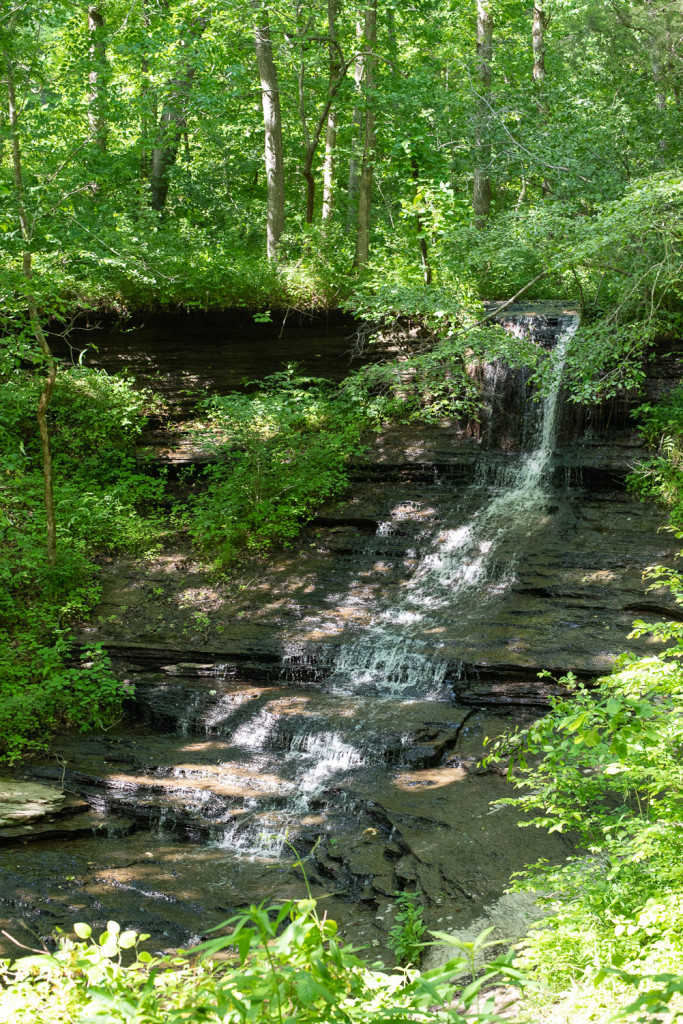
Milepost 385.9: Meriwether Lewis Death and Burial Site
Here you will find the grave of Meriwether Lewis and the ruins of the Grinder House. The Grinder House was one of the stands along the trace. It was also where Meriwether Lewis died (under mysterious circumstances) while traveling the trace.
The cause of his death is still a great mystery. You can read more about it here.
There is a Meriwether Lewis Visitor Information Center here but it is only open seasonally. Unfortunately it was not open during our trip but when open it has exhibits about Meriwether Lewis and a ranger on hand to answer questions.

Milepost 382.8: Metal Ford and Buffalo River
A short walk will bring you to the place where travelers of old would ford the Buffalo River. It gets its name from the stones on the bottom which looked like metal.
Milepost 355: The Dragonfly Emporium
The Dragonfly is a cute shop just off of the trace near Collinwood, Tennessee. It has locally created arts & crafts, select antiques, jewelry, gift items and a coffee bar. It is a great place to get a snack and something to drink as well as to use their wi-fi.
Milepost 364.5: Glenrock Branch
A walk down a short trail will lead you to pretty creek with a limestone bluff bend and a shaded picnic area. You might want to bring your coffee and baked goodies from Dragonfly Emporium here for a little picnic.
Milepost 338: Wichahpi Commemorative Stone Wall
In my opinion this place in Alabama was the most fascinating stop on the parkway.
It is also called Te-lah-nays Wall. This wall, the largest un-mortared stone wall in the nation, was constructed by Tom Hendrix over a period of 30 years in memory of the journey of his great-great-grandmother Te-lah-nay. She was taken to Oklahoma when the Indians were removed from the area, but made her way back to Alabama.
Her path home, like the wall, was neither straight nor easy.
You can read more about the story of both Te-lah-nay and Tom Hendrix here.

Milepost 330.2: Rock Spring and Colbert Creek
Stepping stones lead over a clear spring-fed creek to an approximately 1/2 mile loop trail. The trail is easy to walk and will lead you past the spring fed pool. It has interpretive signs about the vegetation and wildlife in the area. This is also a great place to rest your feet in the cold water.
If you happening to be traveling the trace in the fall this is a particularly important stop.
The creek is intermittently dammed by beavers which has created an impressive wetland area. The edges of the wetland support the orange jewelweed, a plant which happens to attract hundreds of Ruby-throated Hummingbirds each fall.

Milepost 327.3 Colbert Ferry
Another stand used to be located here as well as the spot where George Colbert operated a ferry across the Tennessee River. There is a story (that I have a hard time believing) that Mr. Colbert once charged Andrew Jackson $75,000 to ferry his Tennessee Army across the river.
A short stroll will take you to an overlook where you can see the bridge that now takes travelers across the Tennessee River.
Milepost 304.5: Tishomingo State Park
The Natchez Trace Parkway actually travels right through the middle of this incredibly scenic state park in Mississippi. You can take a driving break at Tishomingo State Park to hike, canoe, fish, or even play disc golf.
Milepost 286.7: Pharr Mounds
Built about 2,000 years ago, the Pharr Mounds is a complex of eight dome-shaped mounds, spread over 90 acres. Cultures around the world and across time have built monuments and lasting memorials like these.
The modern Chickasaw feel a kinship with Pharr mounds and consider them sacred.

Milepost 269.4: Confederate Gravesites.
The truth is that nobody really knows exactly who was buried here in this stretch of 13 graves alongside the old trace.
Tradition holds that they were Confederate soldiers who marched, camped, and died along the Old Trace. Was there a skirmish here? Were they sick? Who is really buried here?

Milepost 266: Parkway Visitor’s Center
You will definitely want to stop by the Parkway Visitor’s Center. They have a movie that you can watch about the trace as well as a variety of information and exhibits. Rangers will be on hand to answer questions.
The visitor center is open daily from 9 a.m. to 4:30 p.m. except for Thanksgiving Day, Christmas Day, and New Years Day.
Milepost 261.8: Chickasaw Village Site
This site is on land that was once a Chickasaw fort and village. Although nothing is really left here you can use your imagination to envision what it might have looked like with the help of interpretive signs and artist renderings along a pathway.
Milepost 232.4: Bynum Indian Mounds
What was interesting about this location was that you can walk right up to and around these ancient Indians Mounds. This is the site of the oldest Indian mounds on the trace.

Milepost 193.1: Jeff Busby Park and Overlook
There is a campsite, bathrooms, and picnic areas at Jeff Busby Park . The overlook stands on the summit of a large hill, and provides a scenic view of the Parkway and the forested areas around it. Take the Little Mountain Trail to overlook. The hike is about 1.5 miles round trip.
Milepost 180.7: French Camp Historic Village
This is the only place with lodging and food right on the trace. You can stay at the French Camp bed and breakfast or eat at the Council House Cafe. There are several other historic buildings at this site including the Colonel James Drane House.

NOTE: There are a couple of stops south of French camp that were destroyed during recent tornadoes in Mississippi. This includes River Bend and Cypress Swamp at milepost 122. They were still closed on our trip so I am not including them in this post but I wanted you to be aware that they exist for when they, hopefully, reopen.
Milepost 105.6: Ross Barnett Reservoir
You will drive a pretty stretch of the parkway right alongside the Ross Barnett Reservoir. It appears that many people just pull right off of the road into the grass and do a little fishing. I’m not sure if this is actually allowed just pointing out what we saw. Stop at this milepost for an slight overlook view of the lake.
Milepost 54.8: Rocky Springs
Such an interesting stop on the parkway. Rocky Springs was once a thriving community that took its name from the nearby water source.
Settlement of the area began in the late 1790’s and continued until about 1860, reaching a peak of approximately 2600 people. Poor land management, yellow fever, the Boll Weevil and the Civil War brought an end to the settlement.
Today there is a campsite and bathrooms.
Drive past the camping area straight through to the back where you will find a place to park and a half mile loop walk with signs that explain more about the town as well as see how the poor farm management caused the land to erode.
Be sure and visit the remaining church and graveyard on top of the hill.

Milepost 41.5: Sunken Trace
Here you can see a portion of the trace that was deeply eroded from many years with thousands of walkers, riders, and wagons. travelers. This especially happened where the ground was relatively soft with loess soil.

Milepost 15.5: Mount Locust Historic House
Mount Locust is the only surviving “stand” or inn of the more than 50 that once served travelers on the old Natchez Trace. This was a fascinating place! You can walk through the house and see typical furnishing from the area.
They have recently discovered the foundation where the old kitchen used to stand. There is a graveyard where more than 46 enslaved people were buried.
A ranger is on site to answer questions. This site is not open on Mondays and Tuesdays.

Milepost 10.3: Emerald Mound
Emerald Mound is the second largest Indian Temple Mound in the US. They were used by the forerunners of the Natchez Indians for burials and ceremonies. This 35-foot-high mound covers eight acres and measures 770 feet by 435 feet at its base. Two secondary mounds sit atop the primary mound, bringing the total height to approximately 60 feet.
Hope you have enjoyed learning more about the stops on the Natchez Trace Parkway!
We spent four days driving the parkway and found it incredibly interesting and relaxing. You will probably want to visit some of the cities along the trace. Such as Leiper’s Fork, Muscle Shoals, Tupelo, Jackson, and, of course Natchez, Mississippi.
Thanks for stopping by!

Planning your Natchez Trace Road Trip
Last Updated on February 22, 2024 by Grant
The Natchez Trace Parkway is so much more than a 444-mile drive. It is a journey through thousands of years of history. Native American tribes used the road as a trade route between the various tribes. Early American settlers used the road as a way to get to what was then known as the Southwest, bordering the Mississippi River. Now, this route is perfect for a relaxing Natchez Trace road trip.
President Thomas Jefferson ordered the construction of a postal road connecting Nashville with the Mississippi River, connecting trade with the Cumberland and Tennessee rivers as well. The native and settler footpath was improved by the US Army and entrepreneurs built ferries and stands, or roadside inns.
The path was not well regarded by travelers, who decried the often muddy conditions of the road, the remoteness of the territory and the frequency of highway robbery. But, it did its job, encouraging trade, which in turn developed the port city of Memphis. Eventually, better routes and steamboats replaced the Natchez Trace and it fell into disuse and disrepair.
The current Natchez Trace Parkway was proposed by Rep. Jeff Busby of Mississippi during the 1930s as a Civilian Conservation Corps project during the Great Depression. While much of the road was completed in the 30s, there were still several sections that remained incomplete until 2005.
(Disclaimer: When we link to places where you can buy our stuff or places we stayed, we are using special codes that earn us commissions on the sales at no additional cost to you. Please see our Review Policy for more information.)
You can drive the road in either direction, from Nashville, TN to Natchez, MS or vice versa, without any difficulty. We chose to drive from Nashville south, so our article is based upon going north to south. The mile markers go south to north, so bear in mind you will count down as you go south.
The single biggest piece of advice for planning your Natchez Trace road trip we have is to download the National Park Service app . I cannot tell you how useful this app was. We were able to download the content for the Natchez Trace to our phone and use it offline as we traveled south. This app gave us a stop-by-stop listing so we could decide which pullouts were worth our time and which weren’t.
You can do the Natchez Trace road trip in two days and feel like you saw everything you need to see. If you are planning on staying in a hotel, Tupelo, MS makes a great halfway point to stop at. If you are planning on camping, there are three free NPS campgrounds along the Trace. There’s one between Natchez and Jackson, one about an hour south of Tupelo and one about 60 miles south of Nashville. None of the campgrounds have hookups.
We highly recommend taking both snacks and a picnic lunch with you for your Natchez Trace road trip… This road goes through fairly remote areas and it can take a bit of driving to find a town of any size.
Last tip: slow down and enjoy the drive! The best part about this drive is there is no stress and the speed limit forces you to slow down and enjoy the journey.
Read more about what to do in Nashville here.
Where to Stop in Tennessee
Here are our favorite stops in order on the Tennessee section of the Natchez Trace:
Mile Post (MP) 438 Birdsong Hollow: Stop here on the north end of the Double Arch Bridge. This bridge is more than worth the stop. This graceful bridge arches over Highway 96 as it snakes through Birdsong Hollow. You can also find a brochure/map of the parkway here. Just south of the turnout is an exit road that takes you down to the highway. Head down to this exit for a great view of the bridge.
MP 404.7 Jackson Falls: Follow the steep trail down 900 feet to see this branch of the Duck River as it cascades over the bluffs. This is one of two waterfalls along the Trace.
MP 401.4 Tobacco Farm and Old Trace Drive: There is an old tobacco barn here. The Park Service works with local farmers to supply this barn with actual tobacco so you can see how the drying process works. There is also a small section of the Old Trace you can drive. It makes for a pleasant drive through the woods but it is too tight for an RV.
MP 391.9 Fall Hollow Waterfall: Just off of the parking lot is a short trail to a viewing area for this 20-foot waterfall. It’s not a long stop but the waterfall is worth a few minute’s of your time.
MP 385.9 Meriwether Lewis: This area preserves where the famous explorer, Meriwether Lewis, died while traveling along the Natchez Trace. Here you will find a recreation of the cabin-like Grinder’s Stand, where Lewis died, and the monument constructed to honor him.
Where to Stop in Alabama and Northern Mississippi
MP 328.7 Trail of Tears Water Route Overlook: This pullout tells the story of the Cherokee Indians who traveled via the Tennessee River from Chattanooga to make their way to Indian Territory in modern-day Oklahoma while on the Trail of Tears. This stop also gives you an excellent view of the Tennessee River.
MP 308.8 Bear Creek Mound: Built nearly 900 years ago, the Bear Creek Mound is one of several earthen mounds built by the Mississippian people. The mound was used as a platform for a ceremonial building. The nearby Bear Creek provided an early method of easy travel.
MP 308.4 Cave Spring: Be sure to stop at Cave Spring to walk this brief paved trail to see a cave that housed a water source for Native Americans. Note: the water is no longer safe to drink.
MP 266 Parkway Visitor Center: We always recommend stopping at the visitor center to learn more about the park and get advice from the rangers.
Spend the Night in Tupelo on Your Natchez Trace Road Trip
Tupelo, MS makes for an excellent stop to spend the night on a Natchez Trace road trip.
Our first stop was the Elvis Presley Birthplace Home because you can’t visit Tupelo and not pay homage to the King! Seriously, seeing this small house is pretty cool and if you are an Elvis fan or haven’t visited Graceland before, be sure to hit up the museum as well.
There are also two battlefields nearby that do not take long to visit. Tupelo National Battlefield is located just off Main Street west of downtown and is not much more than a small park in town. There are a few informational signs and the obligatory cannon.
Brices Cross Roads National Battlefield Site is located about 20 miles north of town and does not have much more in the way of facilities.
For dinner, we chose Kermit’s Soul Kitchen , which had a few interesting dishes and we enjoyed our meal there. You can also try the Amsterdam Deli right next door, which had live music while we were there.
We decided to stroll around downtown Tupelo after dinner and found the hardware store that sold Elvis his first guitar. We also found Crave , a cool dessert joint right by the courthouse that serves a skillet cookie that was to die for!
Tupelo is not that far from Memphis and that lovely city makes a perfect detour off this route.
Read more about Memphis here.
Where to Stop Between Tupelo and Jackson
MP 232.4 Bynum Mounds: This is the oldest mound site along the Natchez Trace, dating back more than 2,000 years. There used to be six mounds but five were excavated by Park Service scientists. The largest of the six were reconstructed, leaving a total of three.
MP 180.7 French Camp: A French-American trader established this post in 1812 to trade with the Choctaw people who lived nearby. The village there retains the name to this day. There is a small cafe and exhibits there.
MP 122 Cypress Swamp: This area used to be where the Pearl River flowed but the river changed course, leaving this area to become a swamp. There is a boardwalk through the area so you can observe the swamp and look for small alligators.
MP 105.6: Reservoir Overlook: Be sure to stop here to stretch your legs and check out the Ross Barnett Reservoir which is the largest source of drinking water in Mississippi.
MP 102.4: Parkway Information Cabin: This cabin used to be home to the Mississippi Crafts Center and now provides information on early Choctaw history and culture.
Where to Stop Between Jackson and Natchez
MP 78.3 Battle of Raymond: There is not much more than an informational sign for this skirmish during the Civil War but it led to the siege of nearby Vicksburg.
MP 54.8 Rocky Springs Town Site: There’s not much left of the town of Rocky Springs but as you walk the trail through the woods, you will find the remains of homes long since fallen down. The only remaining building is the church.
MP 41.5 Sunken Trace: There are ample places you can walk on sections of the original Natchez Trace but this spot is where the road “sunk” into a natural path between earthen banks. It’s a five-minute stop but provides an iconic image of the trace.
MP 15.5 Mount Locust Historic House: Settlement in this area dates back 1,500 years with various tribes occupying this area as recently as 1350 AD. The house presently there was built in 1784 and is the last remaining stand along the Natchez Trace. Plan on spending at least half an hour exploring this historic building and plantation.
MP 10.3 Emerald Mound: This is the second-largest Mississippian Period ceremonial mound in the US and was built more than 400 years ago. The large mound is 35-feet tall and has two secondary mounds on top of it.
MP 5.1 Elizabeth Female Academy: After a brief walk from the parking lot, you will find the remains of the first women’s college in Mississippi which was closed in 1845 and burned in the late 1870s.
Exploring Natchez
Natchez, MS serves as the southern terminus for the Natchez Trace. This port city was established by the French and was, at various times controlled by the British and Spanish before being ceded by the British to the US after the Revolution. Once the capital of Mississippi, Natchez was one of the most prevalent slave-trading cities in the South.
Here, you will find the Natchez National Historical Park, which has several units, including Forks of the Road and Melrose.
Forks of the Road is a small, roadside park now but was once the second-largest slave market in the US and is worth a visit to see how this horrific practice impacted those on all sides of the trade.
Melrose is the quintessential example of an antebellum mansion and plantation in the South. This 15,000-square-foot mansion was built in 1848 and you can tour the grounds and the mansion.
We toured the mansion back in 2011 and were impressed with how well the Park Service has preserved not only the mansion but the various other buildings, making a point to tell the stories of the enslaved people who worked the plantation as well as those who owned it.
When we visited in 2021, the mansion was closed to tours due to COVID, so, alas, we have to rely on our memories of visiting a decade ago.
Where Stay and Eat in Natchez
In terms of finding somewhere to eat in town, we asked our dear friend and colleague who grew up just across the river in Louisiana where we should eat and she said we have to make a point to eat Under-the-Hill. Under-the-Hill is the historic port district. There’s not much is the way of parking but we found a spot and walked down to the Magnolia Grill for dinner.
We really enjoyed the lively seafood joint. In particular, the Cream Cheese Sausage Rotel appetizer was unique and tasty, while the redfish and shrimp and grits hit the spot in terms of entrees.
When it came time for a place to stay, the Hampton Inn is located right by the Natchez Visitor Center and was quite comfortable.
Read Trip Advisor Reviews | Book the Hotel
Final Thoughts on a Natchez Trace Road Trip
We really enjoyed driving this road. While you won’t find the stunning mountain views of the Blue Ridge Parkway, it offers an excellent drive that connects Nashville to very close to New Orleans ( read more about visiting New Orleans here ) and if you have the time, you can spend a couple of days in Memphis along the way to make this a music road trip.
There is a ton of history along this route that you can spend a few minutes or an hour exploring, depending on you and your interest. And, despite the lack of stunning views, you will find the subtle beauty of the rural South along the way.
We are looking forward to driving this route again if for no other reason than it forces us to slow down.
Travel Resources
What do you use to find a flight.
We use Skyscanner to find deals on flights. Skyscanner has a great interface and compares tons of airlines for the best pricing and routing. That said, it does not always have every airline and some airlines will have better deals on their website. Still, Skyscanner is a great place to start. Click here to search for a flight.
What do you use to find a hotel?
We typically stay at Hilton properties , so we use the Hilton website . You can find good Hilton Honors discounts or AAA discounts for a hotel there. We make great use of our free night certificates from our Hilton Honors American Express. Click here to book a Hilton property.
If there are no Hilton properties available, we use TripAdvisor to read reviews and book the hotel. We find we can get the best price that way. Click here to search for a hotel.
We recently partnered with Stay22 to add interactive maps to each of our destination posts. This will allow you to see a plethora of hotels and vacation rentals all in one responsive map of the area. Click here to search an interactive map.
What if I need more space than I can get at a hotel?
We use Vrbo for the times when we have rented a cabin for a weekend getaway, like this cabin in Townsend, TN , or needed to rent a house for a large family vacation. We had a great experience with them in terms of refunding deposits when COVID hit and will continue to use them. Click here to search for a vacation rental.
Who do you use for rental cars?
As a general rule, we book with Hertz for rental cars. We have had nothing but good experiences with them. Plus, we really like unlimited mileage and not worrying about crossing state lines. We have even rented from Hertz overseas in both Slovenia and Croatia . Click here to book a rental car.
How about booking a cruise?
We have found some amazing prices for booking a cruise through Cruise Direct . We have saved a lot of money on our cruises compared to what we found elsewhere, making a last-minute Bahamas cruise even cheaper. Click here to book a cruise.
What if I want to rent an RV?
We highly recommend Outdoorsy for RV rentals. We rented a camper van for a week to visit Rocky Mountain National Park for the elk rut and Custer State Park for the Buffalo Round-Up and had a blast. The program was easy to use and we really enjoyed the freedom of having a camper van for that trip. Click here to rent an RV.
What do you use for booking tours?
We don’t often book tours. Typically, we like to do stuff on our own. That said, there are some experiences you can’t have any other way. So, when we do want to book a tour, we always check Viator first. Click here to book a tour.
Do you use anything to get discounts on the road?
We make extensive use of both Good Sam and AAA on the road. Good Sam is normally regarded as a discount card for RVers at campgrounds and Camping World but anyone can use the 5 cents off a gallon at the pump at both Pilot and Flying J. Click here to get a Good Sam membership. We have had AAA as long as we have been married and it has more than paid for itself in discounts at hotels, aside from the peace of mind of having roadside assistance. Add in paper maps and the ability to get an international driver’s license and it is more than worth it for any traveler out there. Click here to get a AAA membership.
Where can I get Travel Insurance?
We have partnered with Global Rescue for travel and evacuation insurance. This provider will put you out of the worst situations and get you to medical care promptly. You can even purchase “cancel for any reason” insurance from Global Rescue. This is our go-to provider of travel insurance. Traveling somewhere dangerous? They will even extract you if war were to break out on your trip. Click here to get Global Rescue for your upcoming trip.
2 thoughts on “Planning your Natchez Trace Road Trip”
FACT The Natchez Trace National PARK should install SPEED BUMPS !!!!!
Hi David! I can see that in a few places… but the whole point of the Natchez Trace is a nice, relaxing drive. I would be concerned that would break up the enjoyment of the drive.
Leave a Comment Cancel reply
I accept the Privacy Policy

Best Southern Road Trips: Natchez Trace Parkway
Whether you’ve already taken your fair share of Southern road trips and you’re ready to embark on another, or you’re looking for a great way to explore the South for the first time, this road trip gem is one of the best ways to see the South. The 444-mile Natchez Trace Parkway traces a Native American trading route and explores the most beautiful sections of Tennessee, Alabama, and Mississippi. It’s a popular multi-day getaway for motorcyclists and road trippers, with plentiful places to stay along the way.
Most travelers navigating the parkway will start the journey outside of Nashville. It officially begins at the Highway 100 turnoff near Loveless Cafe. Once you’ve had your fill of honky-tonks and neon lights, head south to the quieter community of Franklin.
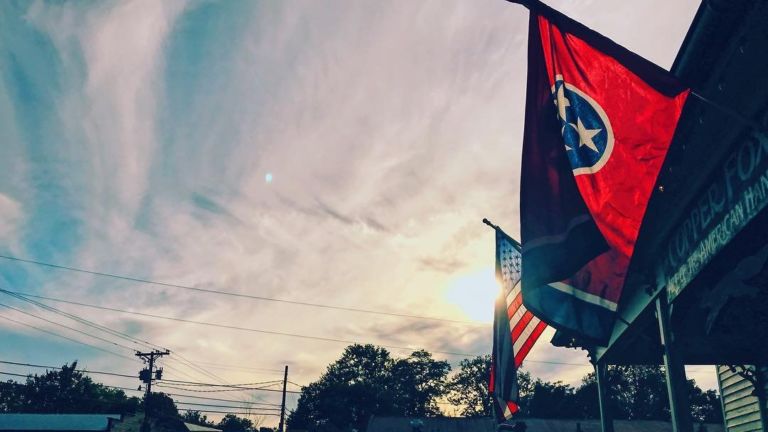
Franklin was an important site during the Civil War, as a devastating loss for the Confederacy, and is now home to a community of musicians that live outside of the “Music City.” Many still perform at small venues around town like Puckett’s Grocery & Restaurant and Kimbro’s Pickin’ Parlor.
Stop at milepost 438, which has incredible views of the Natchez Trace Parkway Arches bridge which soars 155 feet over the valley. The bridge’s design won a Presidential Award for Design Excellence after it’s completion in 1955.
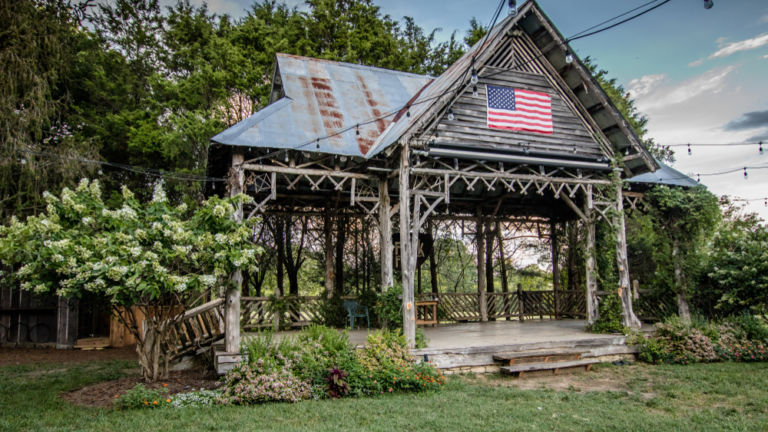
Leiper’s Fork
Tennessee may be the land of Jack Daniel, but he’s far from the only whiskey maker. The Tennessee Whiskey Trail honors these distillers throughout the state, including Leiper’s Fork Distillery , located around milepost 428. Opened in 2016, the distillery crafts small-batch Tennessee whiskey and offers tours of the facility and tastings. Sip on the Old Natchez Trace White Whiskey, named for the scenic byway. You can also catch an impromptu show at any of the “pickin’ corners” in town, where musicians can borrow instruments and just start playing. Leiper’s Fork Market and Serenite Maison are two favorites.
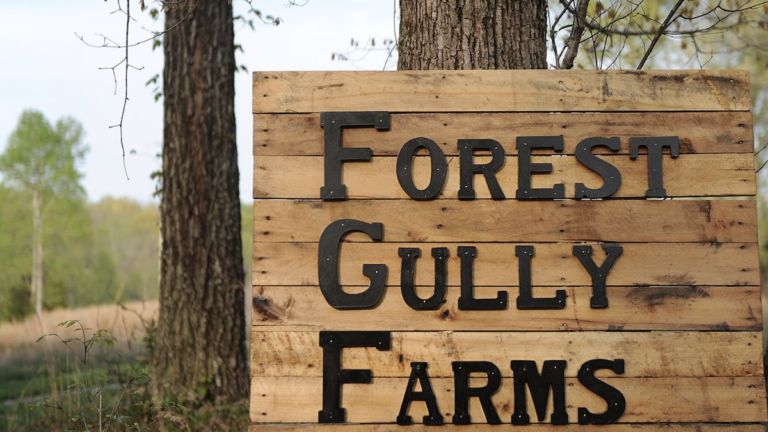
Spend the night around milepost 416 at Forest Gully Farms , a working permaculture farm that has underground hobbit houses. Like their Tolkien-inspired counterparts in New Zealand, they are built into the earth, feature round doors, and have herbs growing atop them. The three interconnected huts must be rented together in advance. All come equipped with cozy quilts and access to the small kitchen and nearby bathhouse. Guests can even explore trails from the property and pick their own produce.
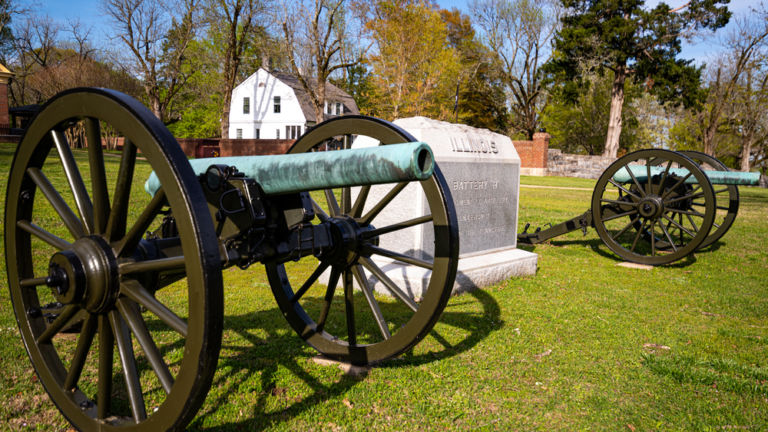
Pay your respects to one of America’s explorers at the Meriwether Lewis Monument at milepost 385.9. In 1809, after Lewis, Clark, and Sacagawea navigated the West, he passed through the South on his way to Washington, D.C. While staying with a local family, he mysteriously died from two gunshot wounds. The site, including his gravesite, is now part of Shiloh National Military Park . It is set next to one of the original Natchez Trace footpaths.
While the Elephant Sanctuary in Tennessee isn’t open to the public, they do have a Discovery Center , which educates visitors on their mission and history. Detour from milepost 391 to learn about the gentle giants.

The trace cuts off the northwest corner of the state around milepost 341, entering Alabama. This region along the Tennessee River is known for its “Muscle Shoals Sound” recording studios which have attracted artists like Aretha Franklin, the Rolling Stones and Percy Sledge. You can tour these studios, which have now been restored. Music fans can also spend the night at the GunRunner Hotel , a boutique hotel with rooms inspired by the famous acts.
Back on the parkway is the Wichahpi Commemorative Stone Wall, also called Teh-la-nay’s Wall. The late Tom Hendrix created the winding path by hand to honor his Native American ancestors removed from this region on the Trail of Tears.
Mississippi
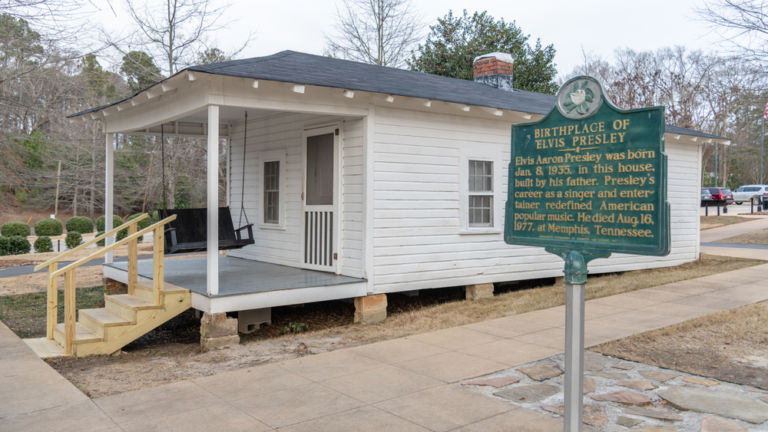
You visit Tupelo to connect with “The King.” Not only was Elvis Presley born here, but he lived much of his early life here before his family moved to Memphis. Fans can see the small home where he lived with his parents, the restaurant where he ate “slug burgers,” and the store where he bought his first guitar .
But the town is also home to the Dogwood Valley Sunken Trace at milepost 275.2, one of many points where travelers can see the original path that travelers took by foot or horse, wearing it down. You can reach the town between mileposts 248 and 281 and visit the official Natchez Trace Parkway Visitor Center in town, the halfway point.

Named for a Polish Revolutionary War officer, the small town of Kosciusko is located between miles 135 and 166. Here visitors can learn about notable former residents James Meredith, the first African American student at the University of Mississippi, and media mogul Oprah Winfrey. A small sign marks the location of the home where she grew up, set on (what else?) Oprah Winfrey Road.
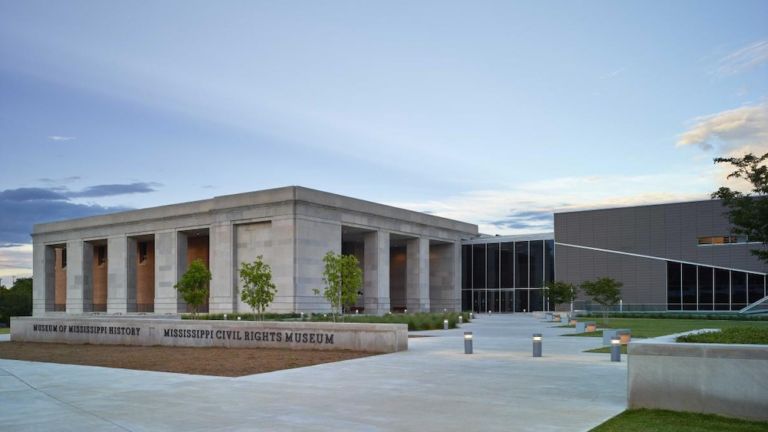
Exit the parkway between mileposts 87 and 103 to get onto interstates 20 and 55 to see the state capital. The city has a number of incredible museums, including the Museum of Mississippi History and the Mississippi Civil Rights Museum .
But the International Museum of Muslim Cultures is the only museum of its kind in the United States. The exhibits cover the heyday of Islamic cultures like Timbuktu and connects slave spirituals to the Muslim call to prayer.
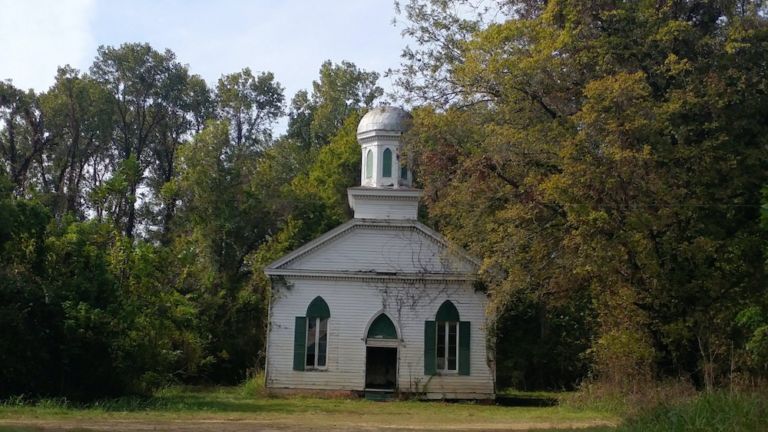
Next, detour on State Road 552 to visit the ghost town of Rodney. It was originally the site of a Mississippi River crossing on El Camino Real, an early Spanish route across what’s now America. It developed into a thriving town with the state’s first opera house and a number of plantations and businesses. But a yellow fever epidemic, the Civil War, and a devastating fire led to the economy’s crash. It was no longer considered an official town in 1930. A handful of flood-damaged buildings are all that remains.
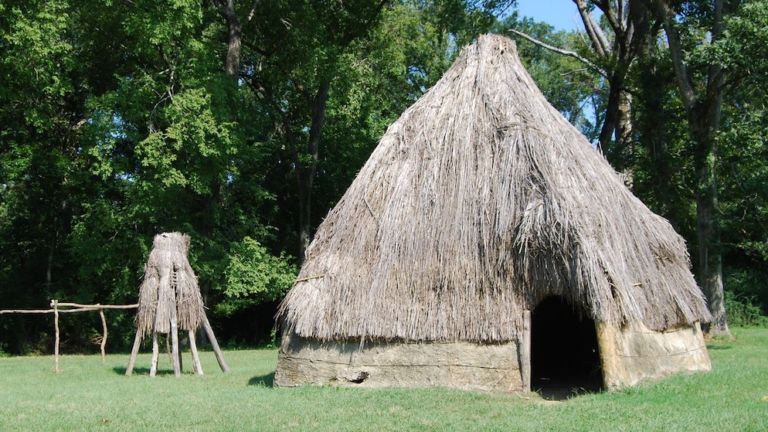
The journey ends in the over-300-year-old city of Natchez, which sits across the Mississippi River from Louisiana. Forks of the Road , the site of the former slave market, and the Natchez Museum of African American History and Culture tell the stories of the enslaved. The Grand Village of the Natchez Indians is another important landmark, featuring the ceremonial mounds of the former inhabitants of the area.
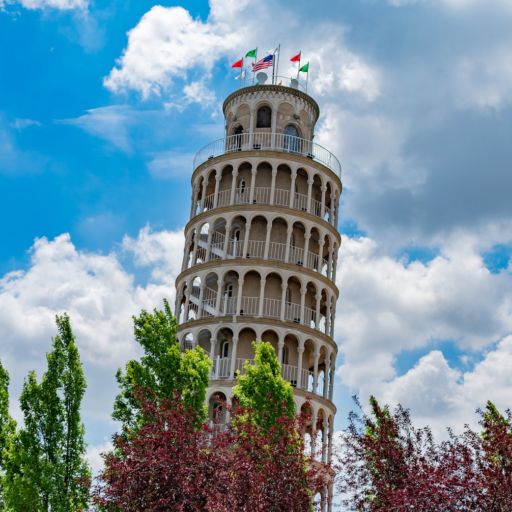
An Ode to Cool Water Towers
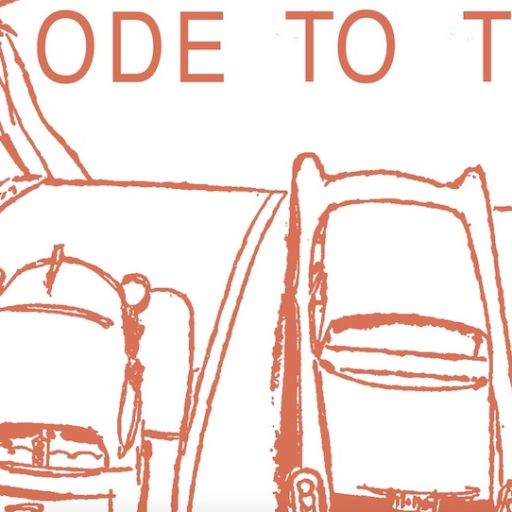
Always Take the Road Trip Detour

PLAN YOUR TRIP

join our e-newsletter
- Name * First Last
- Email This field is for validation purposes and should be left unchanged.
Connect with Us @thenatcheztrace
- Skip to global NPS navigation
- Skip to this park navigation
- Skip to the main content
- Skip to this park information section
- Skip to the footer section

Exiting nps.gov
Alerts in effect, things to know before you visit.
Last updated: April 14, 2023
Park footer
Contact info, mailing address:.
2680 Natchez Trace Parkway Tupelo, MS 38804
800 305-7417 The Parkway Visitor Center near Tupelo, MS, is open 9am-4:30pm seven days a week. The visitor center is closed Thanksgiving, December 25th and January 1st.
Stay Connected

- HOW IT WORKS
- TRIP PLANNERS
Natchez Trace Parkway Trip Planner

A drive along the Natchez Trace Parkway is a journey through time, history, and the natural beauty of the American South. Natchez Trace is unique in that it is a national park, that is a ribbon of parkway enveloped by the tranquility of the countryside and sometimes urban areas. The route essentially follows the historical route of the original Trace that was a network of trails used by Native Americans and later by European explorers and traders, maintaining the legacy of these early travelers. Remnants of their presence can still be seen in the form of ancient mounds, historic markers, and interpretive exhibits scattered along the route.
The rolling hills and lush forests serve as a picturesque backdrop as we venture through important river crossings and beautiful landscapes, with scenic viewpoints and short hikes where you can put yourself into the footsteps of thousands of years of human traffic, and in some sections, even drive a little of the original route.
How to Get Here Getting Around Entrance Fees Map Where to Stay When to Visit How Much Time Do You Need How to Avoid the Crowds Things to See and Do Best Hikes Family Fun Adventures Awesome Experiences Packing List Top Travel Tips
How To Get Here
The entire Natchez Trace Parkway runs through three states – Tennessee, Alabama and Mississippi – in its 444-mile (715-kilometer) journey from the outskirts of Nashville, Tennesssee, to Natchez, Mississippi. This tour covers 136 miles (219 kilometers) of the Natchez Trace Parkway, stretching through the Tennessee and Alabama sections of the drive.
You can drive the Parkway from north to south or south to north.

Northern Terminus
Nashville, Tennessee
From its northern terminus just south of Nashville, Tennessee, it’s an easy 40-minute drive from the Nashville International Airport to the start of the Parkway. This major airport is serviced by 22 airlines, including major carriers and regional partners to cities across the US, as well as to Canada and Mexico.
Southern Terminus
Mississippi – Alabama Stateline
The southern terminus of the tour is at the Alabama-Mississippi state line, with the closest small town being Tishomingo, Mississippi. To access the Parkway from here, the closest airport is Huntsville International Airport (HSV) in Huntsville, Alabama, located one hour and 40 minutes away. American Airlines, United Airlines and Delta Air Lines and several others offer non-stop flights to 14 cities including Chicago, Houston, Las Vegas, Los Angeles, Miami and Washington D.C.
The next closest airport is Birmingham-Shuttlesworth International Airport (BHM) in Birmingham, Alabama, which is two hours and 10 minutes away. This is the largest airport in Alabama and American Airlines, Delta Air Lines, Southwest Airlines and United Airlines offer non-stop flights to 17 cities.
Natchez, Mississippi
To drive the entire Natchez Trace Parkway, the southern start to the route is in Natchez, Mississippi. To get there, the Baton Rouge Metropolitan Airport in Baton Rouge, Louisiana, is just an hour and 40-minute drive away. The Jackson-Medgar Wiley Evers International Airport in Jackson, Mississippi, is a one hour and 50-minute drive to Natchez. Please keep in mind that if you start at the southern terminus, our tour won’t begin until you reach the Mississippi – Alabama border.
Getting Around
The most common transportation used to explore the Natchez Trace Parkway is by private vehicle, there is no public transportation along the Parkway itself. Driving the Natchez Trace Parkway is fairly simple. You can either drive it north to south, or south to north. Of course, there are a number of attractions near the Parkway, so you’ll find yourself veering on and off the Parkway for short excursions or even overnight stays.
The speed limit on the Parkway is 50 mph. It’s fast enough to keep people moving along, but there are many pull-offs maintained by the National Park Service designed to get you out of the car and out exploring the Parkway’s historic sites, picnic spots and beautiful hiking trails.
In addition, you’ll notice mileposts along the entire 444-mile route. They’re numbered from south to north, starting with milepost 0 in Natchez, Mississippi, and ending with milepost 444 near Nashville, Tennessee.
The parkway is a designated cycling route , and bicyclists are permitted to use the entire lane. It’s important for drivers to slow down and pass cyclists with care.

Recreational vehicles are a popular way to see the parkway. Bear in mind that the length restriction for RVs is 55 feet, including a tow vehicle, and the height restriction is 14 feet.
Entrance Fees
Driving the Natchez Trace Parkway is free. Despite attracting more than 6 million visitors per year, the National Park Service does not charge admission to drive the Parkway nor to visit its park service-maintained interpretive sites and trails.
Natchez Trace Parkway Tour Map

Like A Tour Guide In Your Car
Where to stay.
At the northern terminus, Nashville in Tennessee is a bustling city filled with lodging for all budgets from high-end hotels to low-budget national chain hotels. Known as Music City, Nashville offers a ton of entertainment options from live music in its bars and concert venues to lively restaurants and cocktail lounges.
From Nashville as you travel south, lodging options depend on where you are. While some small towns offer really limited hotel options, others like Florence, Alabama, have everything from national chains to high-end boutique hotels and vacation rentals.

For those who prefer to spend the night in a sleeping bag under the stars or in a tent, the National Park Service maintains three no-frills campgrounds that are first-come, first-served. These campgrounds serve campers and RVers, but there are no hookups or showers there.
On this tour route, sits the Meriwether Lewis Campground in Hohenwald, Tennessee, at milepost 385.9. The other two National Park Service campgrounds are located south of our GuideAlong tour: Jeff Busby Campground at milepost 193.1 and Rocky Springs Campground at milepost 54. In addition, a number of private campgrounds and state park campgrounds are easily accessible from the Parkway .

When To Visit
The Natchez Trace Parkway is open year-round, so it can be visited anytime of year. However, there are certain factors to consider when planning a Natchez Trace Parkway vacation, most importantly weather. Spring is a beautiful time to drive the Parkway because so many trees and flowers are in bloom. Spring temperatures are more mild than in the summer with March highs in the mid-60s and April highs in the low-to-mid 70s.
Summers can be extremely hot in Tennessee, Alabama and Mississippi with average temperatures in the 90s. On top of that, high humidity levels can make you feel like you just jumped into a pool, even though you’ve just stepped out of your car. Hiking can be challenging with the heat and insects like mosquitoes, ticks, stinging ants and something called the sweat bee, which is attracted to human sweat.
Conversely, you can avoid all insects and most tourists if you drive the Natchez Trace Parkway in winter. Temperature highs will be in the low to mid-50s in December, January and February, while lows will be in the 30s. While you may need a layer or two for a hike or excursion, you’ll also experience more solitude on trails and exploring the sites.
The downside is you’ll be immersed in a sometimes stark winter landscape. That wintry landscape can include snow or sleet, so be aware of potential winter storms and choose an alternate route in inclement weather. The National Park Service doesn’t plow, salt or sand the Parkway during winter storms, and will close sections of it due to weather.
Fall is a gorgeous time to drive the Parkway because the trees and shrubs along the road explode with reds, yellows and oranges. It’s also the driest time of year in the South. Plus, cooler temperatures make it comfortable to be outside, exploring the Parkway’s trails and historic sites. While September’s high temperatures can hover in the mid-80s, October ushers in temperatures in the mid-70s and November’s high are in the mid-60s.

How Much Time Do You Need to Visit
Our route covers the northern 135 miles through Tennessee and Alabama. It’s doable in a day, but we recommend staying overnight along the way, to be able to walk on the Trace’s hiking trails and see sights both on and just off the Parkway.
If driving the entire 444-mile Parkway, breaking it into three days is common, but some visitors like to really enjoy their exploring and will spend a full week, stopping frequently and also taking time to enjoy the sights just off the Parkway too. Some will also do the Natchez Trace in sections – returning at different times, or different years, to complete lengths not previously drive. Remember that your tour does not expire, so you can return and keep using it.
How To Avoid the Crowds
Unlike other national park sites like Yellowstone or Glacier where traffic can rival a city at times, it’s relatively easy to feel solitude on the Natchez Trace Parkway. Rarely will you find yourself in a traffic jam. Having said that, avoid driving on the Parkway in Tupelo and Jackson, Mississippi, during rush hour. Commuters use the Parkway to get to and from work.
To avoid crowds on popular trails like Jackson Falls or sites like the Meriwether Lewis Monument, aim to get there early in the morning before others arrive or later in the day close to evening time. On longer hikes, you’ll find most people turn around within a mile of the trailhead, making it easy to find tranquility the farther you walk.
Things to See and Do
The beautiful views and roadside stops along the Natchez Trace Parkway are the main attractions on this road-trip adventure. For the 135 breathtaking miles of this tour, highlights include cascading waterfalls, ancient and early settler sites, fantastic hikes and Civil War history.
Bear Creek Mound
Right at the Alabama-Mississippi state line sits Bear Creek Mound, an ancient settlement inhabited sometime between 1100 and 1300. Archaeologists believe that the mound was much larger originally and that farmers tilling the land reduced its size over the decades.

Jackson Falls
Even Nashvillians who aren’t specifically on a Natchez Trace road trip love to visit Jackson Falls. It is one of the closest waterfalls to the city and the biggest waterfall payoff for the least amount of effort. These falls were named for President Andrew Jackson.
Taking in the view from the top of the falls is satisfying, but walking at least halfway down the path is even better. Continuing to the bottom reveals a clear pool and the beauty of the water stepping down a limestone outcropping.

John Coffee Bridge & Colbert Ferry
John Coffee Memorial Bridge is nearly a mile long, making it the Parkway’s longest bridge. It was built in 1964 and is named after John Coffee, who fought with Andrew Jackson in the Battle of New Orleans.
The bridge crosses what was once the location of the Colbert Ferry Stand Site. George Colbert operated a ferry that took travelers across the Tennessee River from 1800 to 1819 here. George’s father was Scottish and his mother was Chickasaw, and being Chickasaw gave George the right by treaty to run the ferry. Today, you can walk along a path to see where Colbert’s inn stood and look at Native American exhibits.

Leiper’s Fork
A 5-minute side trip off the Parkway takes us to a small but stylish community and Leiper’s Fork. While exploring the small selection of stores, restaurants and galleries, you might even spot some of country music’s biggest names. The community is the home for some true headliners!

Meriwether Lewis Memorial
Meriwether Lewis was of course the leader of the famed Lewis and Clark expedition who were tasked with finding out what lay west of the Mississippi River – at the time a wholly unknown place to the young United States. The 8,000 mile journey changed the USA forever. The location contains the Monument to Lewis, as well as a reproduction of Grinder’s Stand, the lodging where Lewis’ life came to an end. It’s not a sad place to visit – it’s very interesting! It’s also the site of a major campground, and there some pleasant short trails available to hike.

Muscle Shoals Sidetrip
This fascinating region is just too close to the Natchez Trace Parkway to not include a sidetrip to visit the major highlights of the Quad City area. There are five places of interest and you can choose to visit one, all, or just a few. It would be easy to fill a day to see everything if we have the time. It takes approximately 20 minutes to drive off the Trace to visit the closest site. Those interesting places are: Ivy Green (the Helen Keller childhood home), the Alabama Music Hall of Fame, Muscle Shoals’ two iconic recording studios, the Florence Mound and Museum, and the Rosenbaum House designed by Frank Lloyd Wright.

Natchez Trace Parkway Bridge
The last major addition that completed the Parkway’s uninterrupted path – and perhaps the most visually stunning! Spanning 145 feet over woods and a state highway, this bridge was uniquely constructed with two concrete arches that span over the valley. This is a photo you will want to stop and take on your Natchez Trace journey.

Old Trace Drive
One of the few places on the Parkway where we can drive (rather than walk) on the true, original Trace route. This section is a narrow, one-way journey of 2.5 miles that enjoys some excellent views, as well as following the historic path. A very worthwhile short detour!

Rock Spring
A simple and quick location to visit, with idyllic scenery punctuated by the square stepping stones that cross Colbert Creek on the trail to the natural spring.

Sunken Trace
The Parkway is full of spots where the original Old Trace, worn by decades of horse hooves, wagon wheels, footsteps and erosion, have created permanent sunken ruts. At the Sunken Trace, three different pathways come together, revealing how travelers had to stray from the main route to avoid getting stuck in mud.

War of 1812 Memorial
The Trace was an effective route to move troops and cavalry, and that’s what Andrew Jackson did in 1813. The Memorial stands to honor those who marched the route and particularly those lost their lives, and were buried in unmarked graves.

Wichahpi Commemorative Stone Wall
The late Tom Hendrix spent more than 30 years building what has become the largest unmortared wall in the country. Just off the Parkway, the mile-long wall is a monument to Hendrix’s great-great grandmother, Te-lah-nay, and her journey on the Trail of Tears. Each stone, hand-placed by Hendrix, symbolized a single step Te-lah-nay took during the Trail of Tears. Visitors can walk along the maze-like wall.
Devil’s Backbone National State Area
Technically, Devil’s Backbone State Natural Area is a park adjacent to the Trace, not actually on it. The area’s only trail is a 3.2-mile moderate-effort loop that runs along a ridgeline before dropping to a creek and then back to the ridge. Even so, there’s only about 200 feet of elevation change, making for a few short steep areas.
These falls are popular for good reason – and partly because they are one of the closest “wow-factor” waterfalls to Nashville. Follow the trail to the bottom of the falls is conditions are not muddy. To turn this into a longer hike, consider adding a round trip hike from Jackson Falls to Bakers Bluff, a 1.5 mile out and back hike to some pretty awesome views.
Natchez Trace National Scenic Trail
The Natchez Trace National Scenic Trail is composed of five different trails totalling more than 60 miles. In Tennessee, the Leiper’s Fork District of the Natchez Trace National Scenic Trail runs 20 miles, starting up near milepost 427 and ending at milepost 408, where TN‑50 crosses the Parkway. This trail, which is part of the larger Highland Rim Trail, is one of several preserved sections of the Old Trace. Walk for as long as you want along the 20-mile Highland Rim Trail that’s mostly flat. The most popular, and therefore crowded, access point for the Highland Rim Trail is from Garrison Creek Trailhead.
Get out into nature on a short half-mile loop on the Rock Spring Nature Trail, which leads to a bubbling spring called Rock Spring. The terrain is easy, with picturesque square stepping stones that cross Colbert Creek. It’s possible to see beavers, ruby-throated hummingbirds, and salamanders here. In the late summer and early fall, there are tons of wildflowers, like jewelweed, which grows between two to five feet high and has a small bright orange spotted flower.

Sweetwater Branch
Sweetwater Branch offers a half-mile loop hike, which is alive with wildflowers in the spring. It’s a quiet area along the creek banks, with lots of shade. The walk includes some stairs and hilly terrain to get to the trail itself, so it isn’t appropriate for wheelchairs, but it isn’t particularly strenuous once hikers reach the riverbank itself.

Tishomingo State Park
Minutes from the Alabama-Mississippi border, the Natchez Trace Parkway crosses through Tishomingo State Park, and it’s known for its 13 miles of hiking trails. The Outcroppings Trail is a beautiful two-mile loop that runs along a ridge of large rock outcroppings that are popular with rock climbers. Along the way, there are views of the valley and caves where Chickasaw people lived. The trailhead starts at Swinging Bridge built in 1938.
Family Fun Adventures
Fall hollow falls.
One of two waterfalls along the Natchez Trace Parkway, Fall Hollow Falls is a small accessible waterfall, making it great for families. There’s an easy, paved path that leads to a wooden bridge and platform about halfway down the falls. Depending on the conditions, getting to the bottom of the falls can be muddy. Even so, it’s one of the prettiest places on the Tennessee section of the Trace.

Grand Ole Opry
Not strictly on the Trace – but since you are so close….. Known for hosting some of country music’s most famous singers, the Grand Ole Opry in Nashville, Tennessee, offers country music shows multiple nights a week. These weekly performances can include music greats like Keith Urban and newer country singers just establishing themselves. The Opry also offers several types of state-of-the-art special backstage tours.
Visit Ivy Green in Tuscumbia, Alabama, the childhood home of Helen Keller who met 12 presidents, was nominated for the Nobel Peace Prize, and helped establish the American Civil Liberties Union. Keller became blind and deaf at age two, but with the help of her teacher, Anne Sullivan, she overcame many obstacles and spent her life advocating for the visually and hearing impaired.
Laurel Hill Lake
Just three miles from the Parkway, Laurel Hill Lake is a great place for families to fish or rent kayaks and explore the lake by paddle. There’s even a 16-and-under, youth-only fishing area, and you can buy a state fishing license at the nearby Laurel Hill Tackle and Deli. Depending on the time of year, you may catch bass, bluegill, crappie and catfish.
A charming town just 45 minutes south of Nashville and just off the Parkway, Leiper’s Fork offers families a fun stop to explore one-of-a-kind shops, restaurants and galleries. While small, it’s big on personality and known for its resident celebrities like Faith Hill, Nicole Kidman and Justin Timberlake.
When people used to travel on the Old Trace, Metal Ford was a popular place to cross the Buffalo River. Today, it makes for a great swimming hole. The riverbank is just steps away from the parking lot, as are a few picnic tables. Because of the rocky river bottom, water shoes are recommended.
The Elephant Sanctuary and Elephant Discovery Center
Close to the Parkway in Hohenwald, Tennessee, the sanctuary is a non-profit that cares for Asian and African elephants. While the sanctuary is not open to the public, travelers can visit the Elephant Discovery Center in downtown Hohenwald to learn more about the elephants, see presentations by staff and watch the elephants on webcams. Hohenwald is about six miles west of the Parkway on Highway 412.
The Loveless Cafe
Located a quarter of a mile from the northern terminus of the Parkway in Nashville, Tennessee, this iconic landmark has been serving hungry travelers since 1951. Known for its biscuits, the restaurant serves Southern style breakfast, lunch and dinner with a large dose of southern hospitality.
Awesome Experiences
Alabama music hall of fame.
Take a deep dive into Alabama’s music history at the Alabama Music Hall of Fame in Tuscumbia, Alabama. The state is home to many singers, including Nat King Cole, Emmylou Harris, Hank Williams and Lionel Richie and the exhibits here tell so many stories. The hall of fame is a 15-minute drive from the Parkway.
Florence Mound and Museum
The Florence Mound in Florence, Alabama, and hundreds of others across the Southeast were part of ancient cultural centers. The Florence Mound measures 145 feet by 95 feet near its top. Archaeologists believe it was built between 100 and 500 AD. Visitors can walk up the stairs on this sacred mound and visit the museum that houses ancient jewelry, pipes, spear points, necklaces and more.
Muscle Shoals
About 25 minutes off the Parkway, Muscle Shoals is known for its two famous recording studios. Opened in 1959, FAME Studio brought black and white musicians together to create and record music. This was especially daring back in the days of segregation. Rival studio Muscle Shoals Sound Studio popped up afterwards and together they gave rise to so many classic songs sung by the likes of Aretha Franklin, Bono, Keith Richards, Alicia Keys and Jimmy Cliff. Both studios offer tours.
Tennessee Wineries
While Tennessee is known for its whiskey distilleries, there are several wineries not far from the Parkway. Amber Falls Winery & Cellars in Nashville is all about novelty fruit wines, plus some dry reds. Grinder’s Switch Winery in Centerville is housed in a log cabin and makes sweet and dry reds and whites. Keg Springs Winery in Hampshire is minutes from She Boss Place on the Parkway and has sweet wines and live music. Natchez Hills Vineyard, also in Hampshire, focuses on sustainable growing using Old World techniques.

The Dragonfly
Located in Collinwood, Tennessee, across from the Wayne County Welcome Center, The Dragonfly sells antiques, gits, handbags, jewelry and coffee and smoothies. It’s a true emporium experience and an iconic Trace stop.
The Rosenbaum House
Architect Frank Lloyd Wright designed a number of buildings and homes during his career. One of his homes, The Rosenbaum House, is open to the public in Florence, Alabama. It’s a Usonian-style house and the design style is right in the name – Usonian – United States of North America. Wright designed Usonian homes to be affordable for middle-class American families but simultaneously innovative. Explore the Rosenbaum House’s open floor plan and see the furniture he designed.
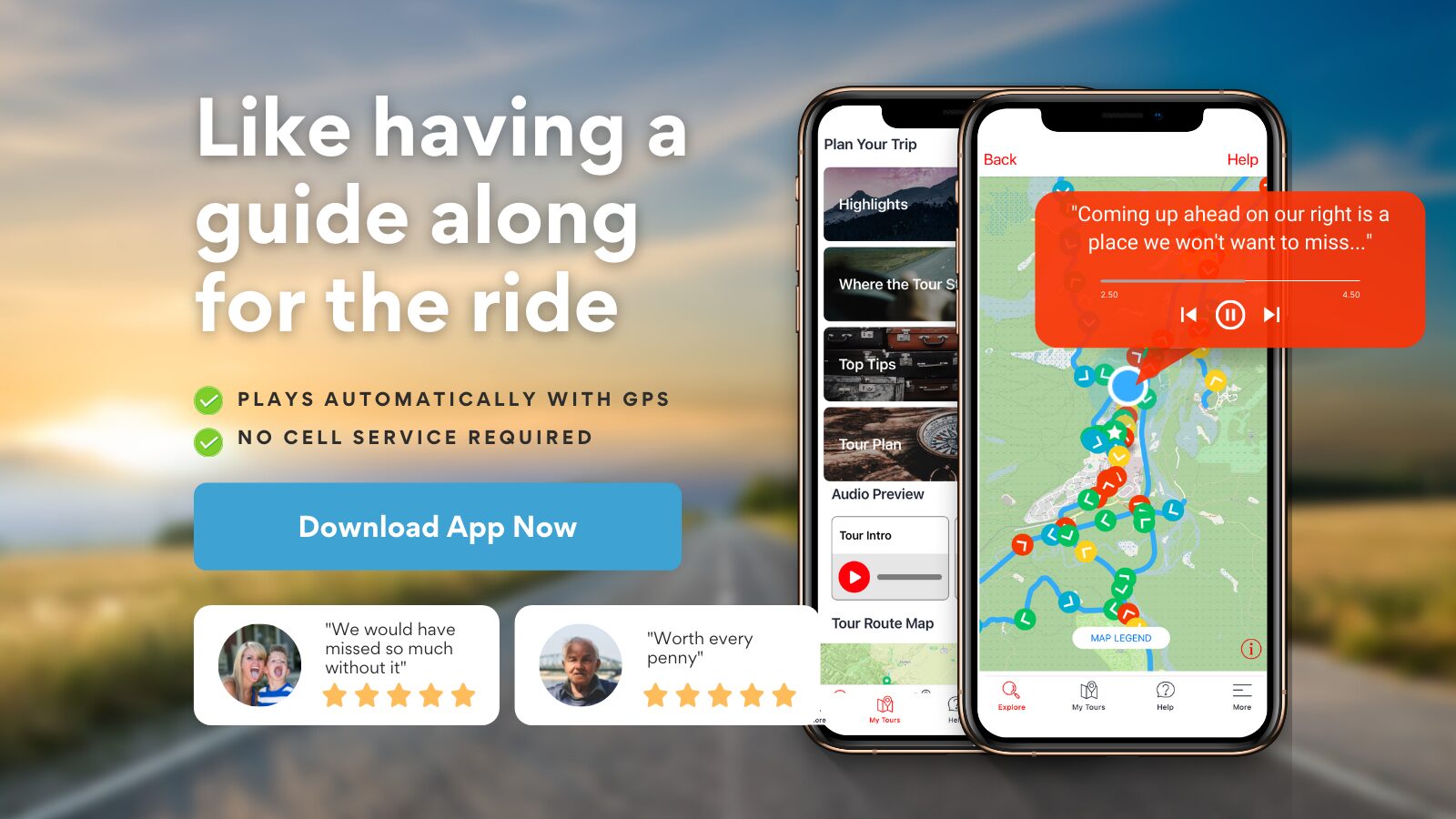
Natchez Trace Parkway Packing List
Seasonal Layers : The type of clothes you pack depends on the season, so check weather temperatures for when you will be visiting. It’s always a good idea to pack clothes that will be comfortable whether you decide to pull over and do a short hike or tour a historic site. Bringing layers allow you to regulate your temperature easily.
Footwear: Comfortable, sturdy shoes like hiking boots or sneakers are ideal for exploring the Natchez Trace Parkway. No one wants to navigate a woodsy trail in work shoes.
Daypack: You may want a comfortable daypack or small backpack for day hikes.
Sun Protection: Pack sunscreen, sunglasses and a hat to protect yourself from the sun.
Bug Spray: It can get very buggy in the South when the weather is warm, so pack bug spray and have it easily accessible for hikes, picnicking and any time you venture out of the car.
Picnic Kit : Having lunch at one of the Parkway’s pull-offs is a must-do, so pack a cooler, tablecloth, utensils, plastic plates and a sponge for cleaning up afterward.
Sports Gear : If you’re planning on outdoor adventures, pack the gear you may need like spare bike tubes, fishing tackle, or your kayak.
Water Bottles: Bring along a water bottle for the drive as well as for any hikes you do. If you pack a refillable water bottle, you’ll save money and reduce your carbon footprint.
Trekking Poles: Light-weight hiking poles are nice to have if you plan on doing short or long hikes. They help provide a sense of balance over uneven terrain.
Maps : While GuideAlong helps you navigate, it’s always nice to have a road map for Tennessee, Alabama and Mississippi. Plus, make sure to grab a Natchez Trace Parkway Map and information pamphlets when you stop at visitor centers.
Phone Charger: If you’re taking pictures with your phone, running out of batteries may result in missed opportunities. A DC car charger is best, so that you can charge your phone while driving.
Plastic Bag: We always carry plastic bags with us, so we have a place to put our car trash, as well as to collect any trailside trash. If we all pick up a few pieces of trash along the Parkway’s pull-offs and trails, we’ll leave it better than we found it.

Top Tips for the Natchez Trace Parkway
- Accommodation Reservations: Book your lodging before you hit the road. Festivals or fall leaf peeping can lead to a scarcity of hotel rooms along certain stretches of the Parkway.
- Check Conditions: The National Park Service doesn’t maintain the Parkway in inclement weather, and will shut down sections when ice and snow make conditions hazardous. Check for road conditions and closures on nps.gov and the Parkway's Facebook page.
- RV Restrictions: The length restriction for RVs is 55 feet, including a tow vehicle, and the height restriction is 14 feet.
- Services: By design there are no food, gas or lodging services "on" the Parkway, but you'll find services in the many communities along the drive.
- Pay Attention to Your Speedometer: It’s tempting to speed, but the speed limit is 50 mph and sometimes lower. The Parkway is all about taking in the scenery and discovering new trails, towns and historic markers, so keep your foot off the gas and enjoy the ride.
- Watch for Cyclists: The Parkway is a designated cycling route, and bicyclists are permitted to use the entire lane. It's important for drivers to slow down and pass cyclists with care, changing lanes completely to pass.
- Cell Phone Coverage: Cell phone coverage can be spotty, so download any maps in advance and perhaps pick up a road map from one of the visitor centers.
- Bring Insect Repellant: It can get very buggy in the South when the weather is warm, so pack bug spray and have it easily accessible for hikes, picnicking and any time you venture out of the car.
Acadia ALABAMA Alberta Arches ARIZONA AUSTRALIA Badlands Banff Big Island Big Sky Drive Big Sur Black Hills Blue Ridge Parkway British Columbia Bryce Canyon CALIFORNIA CANADA Canadian Rockies Canyonlands Capitol Reef Catskills COLORADO Copper Country Trail Death Valley FLORIDA Florida Keys Glacier Going To the Sun Road Grand Canyon Grand Canyon West Grand Teton HAWAII Hikes Honolulu Hoover Dam Hwy 61 Hwy 101 Icefields Parkway Itineraries Jasper Joshua Tree Kancamagus Kauai Keweenaw Key West Kings Canyon Lake Louise Lake Superior North Shore Lake Tahoe Las Vegas Lodging M22 MAINE Maui Mesa Verde Miami MICHIGAN MINNESOTA Montana Mount Rushmore Natchez Trace NEVADA New Hampshire NEW YORK Niagara Falls NORTH CAROLINA North Dakota Oahu OBX Olympic Ontario OREGON Oregon Coast Outer Banks Petrified Red Rock Canyon Road to Hana Rocky Mountain Sedona Sequoia Shenandoah Sleeping Bear Dunes Smokies SOUTH DAKOTA Tech Tips TENNESSEE Theodore Roosevelt Travel Tips Trip Planners UTAH Videos VIRGINIA Waikiki WASHINGTON Wildlife WYOMING Yellowstone Yoho Yosemite Zion
- {{ index + 1 }} {{ track.track_title }} {{ track.track_artist }} {{ track.album_title }} {{ track.length }}
- Skip to global NPS navigation
- Skip to the main content
- Skip to the footer section

Exiting nps.gov
Insider tips - before you visit the natchez trace parkway.
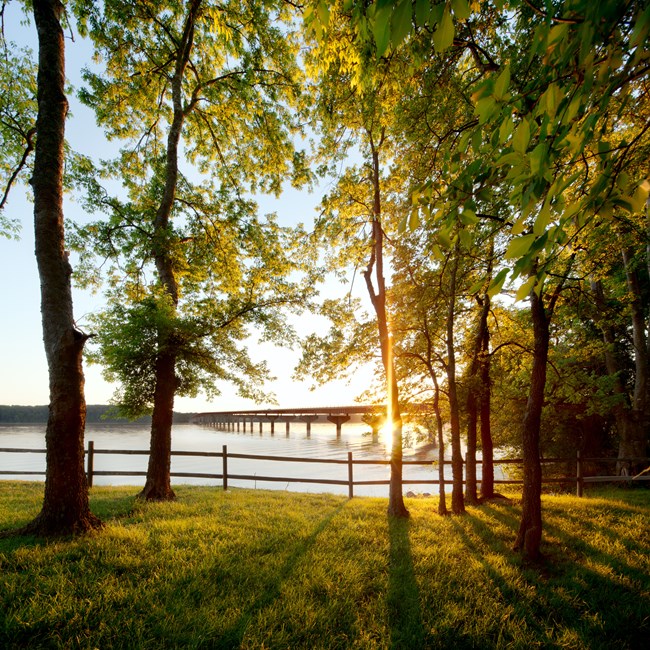
NPS/Marc Muench
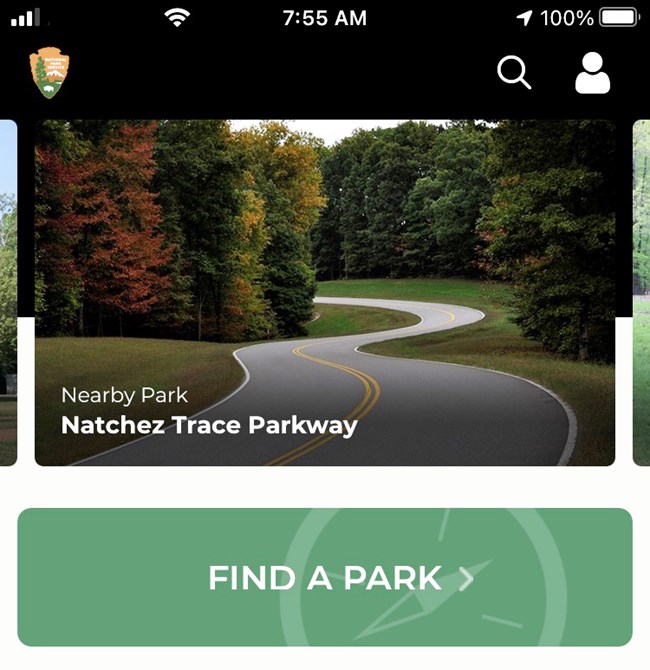
Screen shot
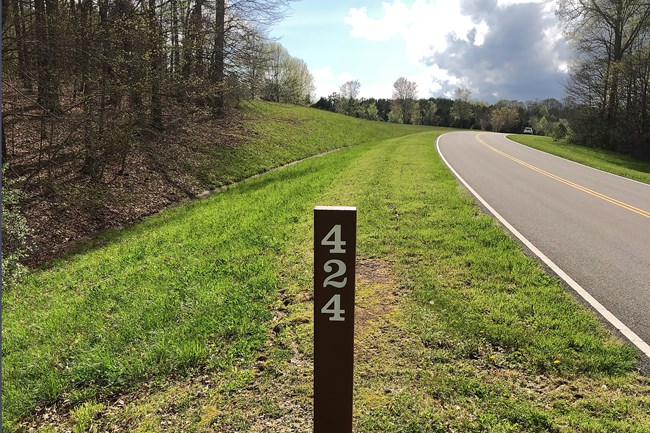
NPS Photo/ Daniel Shawl
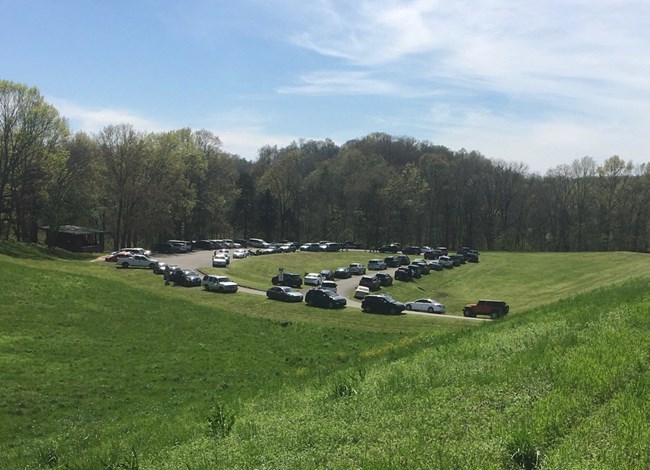
NPS Photo/ J Brewer
- What's Open What's Closed
- Current Conditions
- Operating Hours
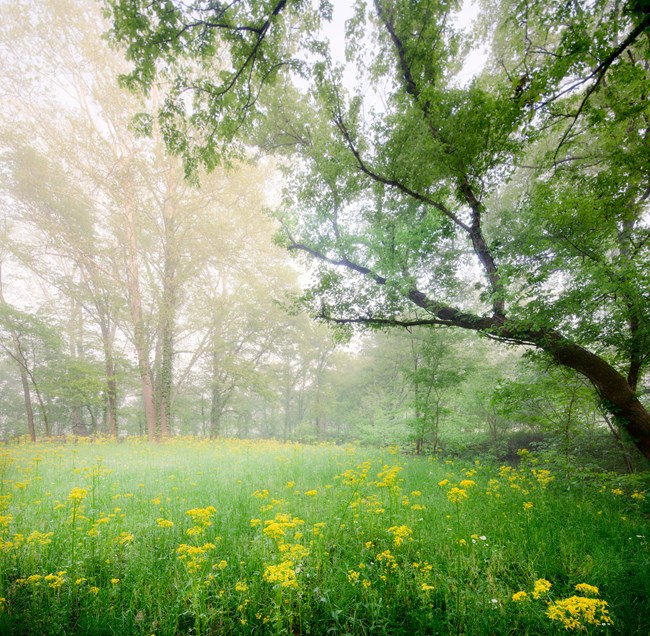
NPS photo / Marc Muench
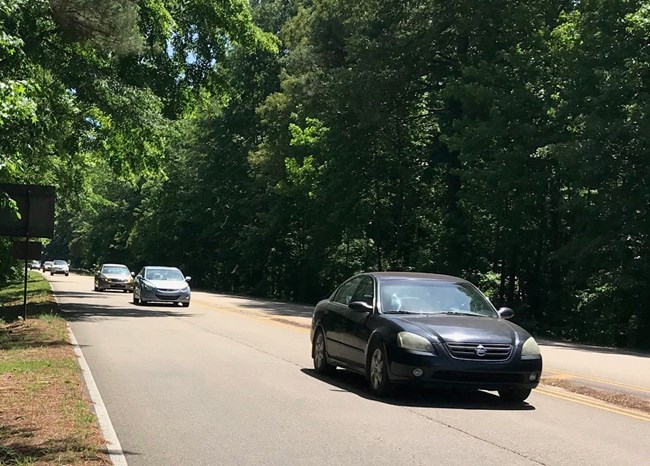
NPS Photo/J Farmer
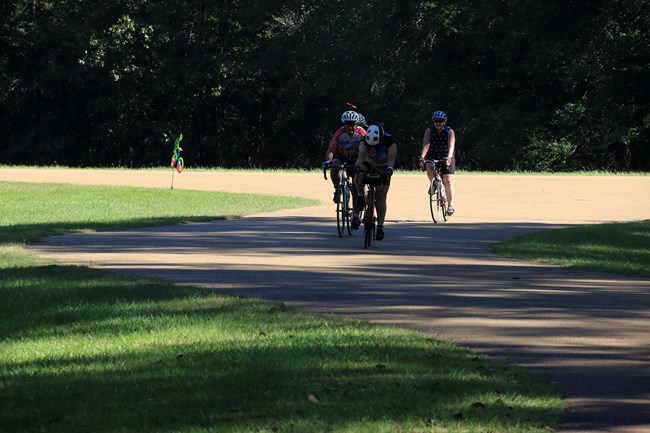
Photo Sherwood Photography

NPS Photo/ Brian Powers
You Might Also Like
- natchez trace parkway
- summer 2021
- trip planning
Natchez Trace Parkway
Last updated: October 13, 2023
- Featured Stories
- Recipe Library
- Drink Library
- Your Insider’s Guide to South Carolina
- City Guides
- Restaurants
- Print Subscription
- The Local Palate Newsletters
- Digital Edition Access
- Marketplace

subscribe now
Our magazine for $24.99 a year
2 Subscriptions For the Price of 1! Only $24.99 a year

Discover the best of
Southern food.
Plus, receive 10% off at the Local Palate Marketplace
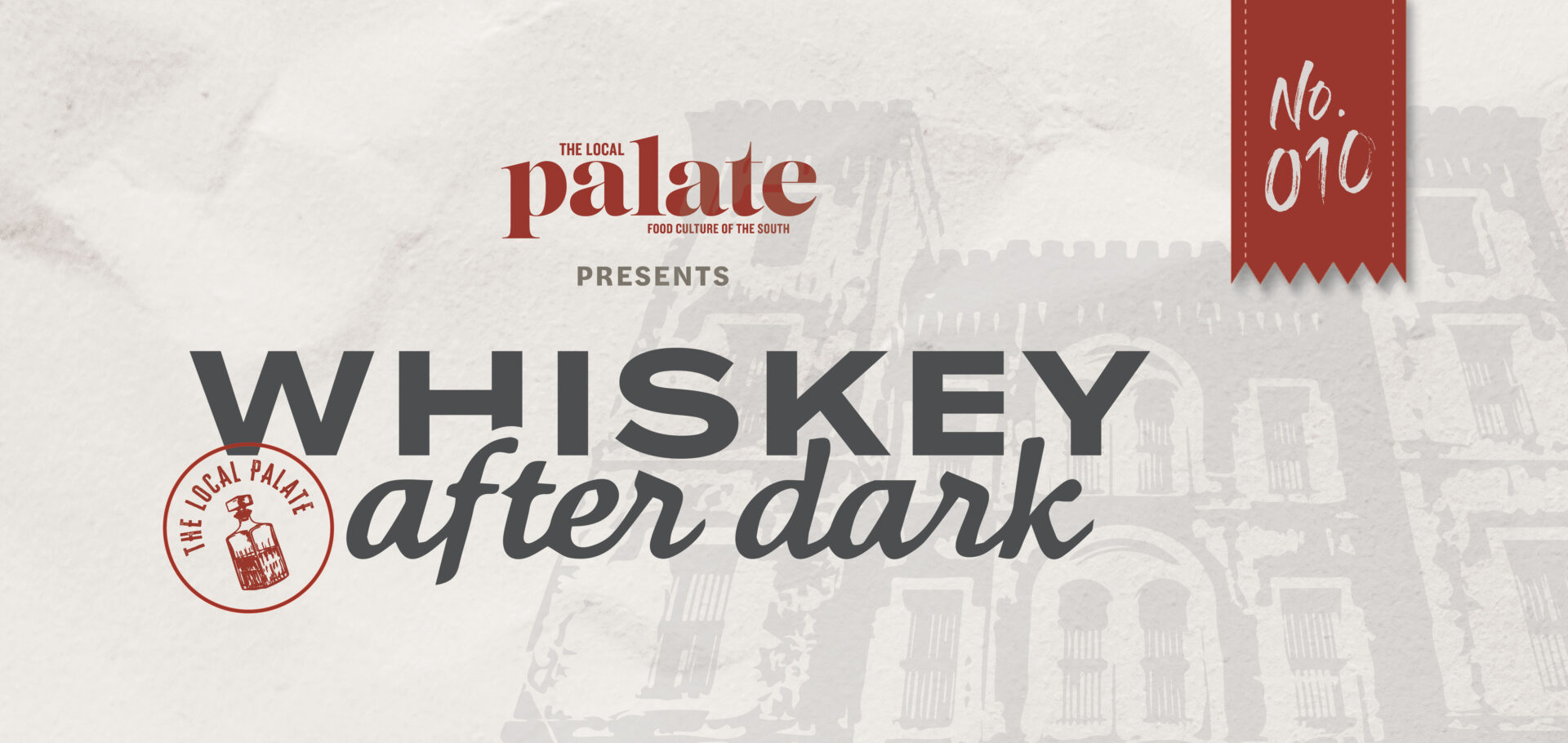
Whiskey After Dark is turning 10!
Sip your way through more than 100 whiskeys within the storied walls of Twenty-One Magazine. You don’t want to miss our biggest celebration yet!
Get Tickets

Shop The Local Palate Marketplace
Shop Small! Click to the Local Palate Marketplace for a curated Southern-made selection of gifts and specialty items for your home.

Subscribe Today!
Subscribe NOW and SAVE—plus, receive 10% off TLP Marketplace!
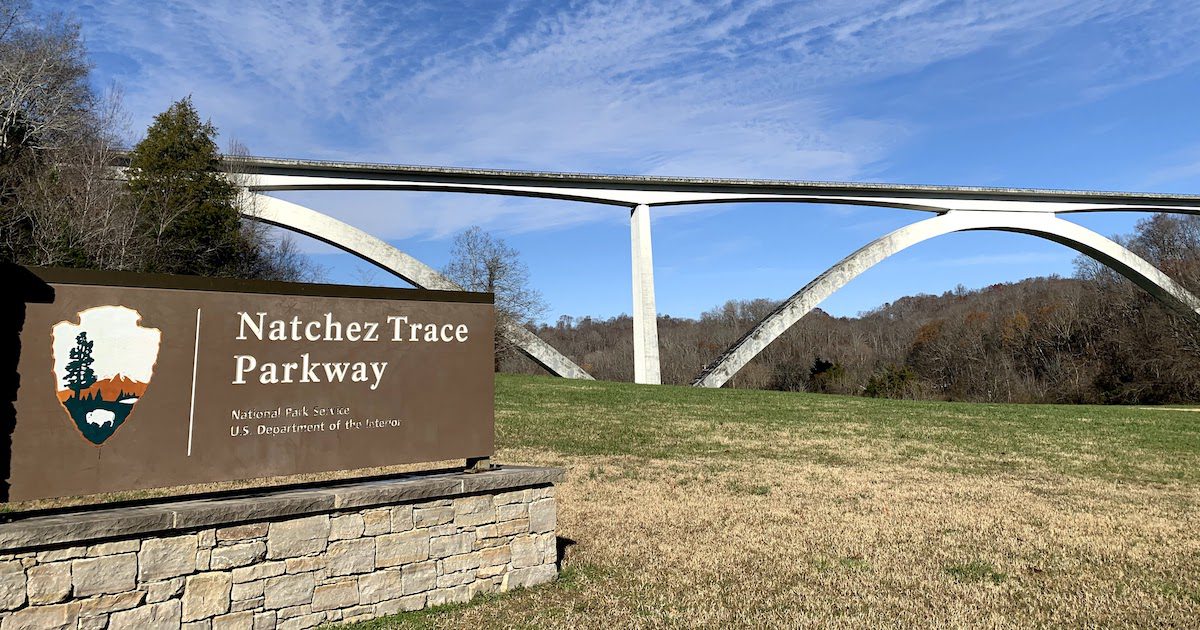
On the Road
Road trip: natchez trace parkway.
- Copy to clipboard
Traversing the Trace
Natchez Trace Parkway is a 444-mile route managed by the National Park Service. It runs through three states—Tennessee, Alabama, and Mississippi—connecting Nashville to Natchez, Mississippi. Like any good national park site, it is all about nature and history. The road itself has no commercial stops and doesn’t even have gas stations (you can fill up easily after exiting the parkway). Instead, it boasts miles of redbuds, sugar maples, and loblolly pines. Instead of billboards imploring you to stop, you’ll find more than fifty pullouts with historic markers, hiking trailheads, and waterfall overlooks.
But the Trace is far more than a scenic byway. For thousands of years, it was the way animals and people traversed the southeast to find food and water. By retracing their steps, you’ll learn about Native-American communities, the Trail of Tears, military operations, music from country to soul to blues to jazz, and, of course, the foods that sustained them all. From north to south, here are six stops for experiencing the Natchez Trace Parkway.
Jackson Falls: At milepost (MP) 404.7, a waterfall spills over limestone rock, the force of which depends on recent rain levels. Take a short, but steep, hike to the base and back, and be rewarded with the sound of a splashing pool and an absence of road noise. Just 20 miles away is the Natchez Hills Vineyard and Winery , where you can taste local wines, cheeses, and chocolates.
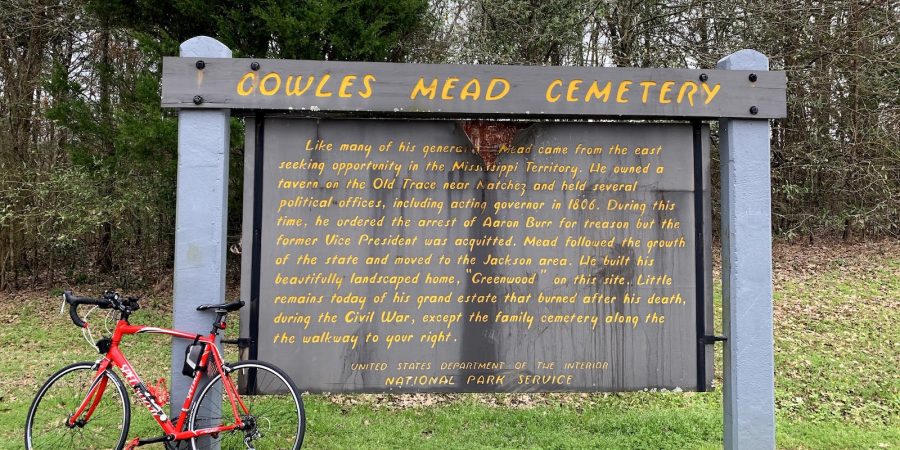
Meriwether Lewis Monument, Gravesite and Campground (MP 385.9) is the final resting place of the explorer who helped chart the western half of the United States. He died here in 1809, many believe by suicide, and the site includes a memorial, seasonal museum, hiking trails, and a popular campground. Stock up for a picnic at Yoders Homestead Market, just 5 miles east. Fresh-made baked goods are good post-hike carbs–don’t sleep on the chocolate chip cookies.
Crossing into Alabama, Wichahpi Commemorative Stone Wall (MP 338) is a powerful monument to one woman’s trek on the brutal Trail of Tears. Her great-great-grandson built this winding wall, said to be the longest unmortared wall in the country, to honor her forced removal and return home. Stick with the outdoor stone theme by dining at Rattlesnake Saloon , a restaurant positioned under a rock about 30 miles from Wichahpi, and then stay overnight on-site at the Seven Springs Lodge .
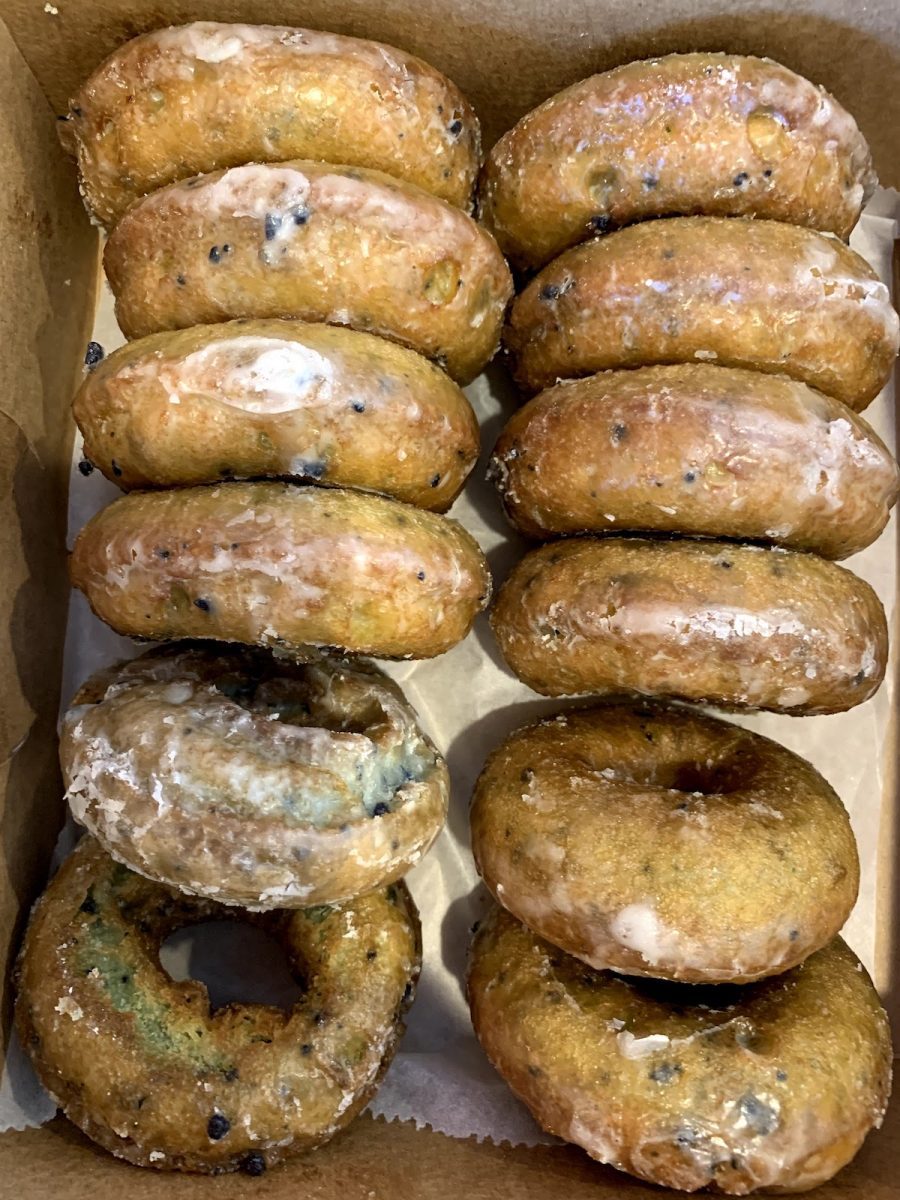
The unofficial halfway point on the Trace, Tupelo, Mississippi, is home to the Birthplace of Elvis Presley, which skips some of the flashiness of his later life at Graceland and focuses on his modest upbringing. The nearby Chickasaw Village Site (MP 261.8) was once home to a fort and dwellings of the Chickasaw people. Today it is a wildflower meadow with trails and interpretive signs and plans for more in the future. If you eat only one thing on your Trace trip, it should be the sublime blueberry cake doughnut at Connie’s Fried Chicken, which also sells chicken and biscuits.
Mississippi’s capital city, Jackson, is known for its soul music as well as its roots in the civil rights movement. The Medgar Evers Home Museum and National Monument and the Two Mississippi Museums are powerful stops to better understand the fight for civil rights, not just in the 1960s, but as it continues today. End your day at Cathead Distillery, where you can take a tour and have a cocktail or have dinner at Mayflower Cafe, the city’s oldest restaurant and once a favorite of writer Eudora Welty. (Welty fans can also visit her home while in town.)
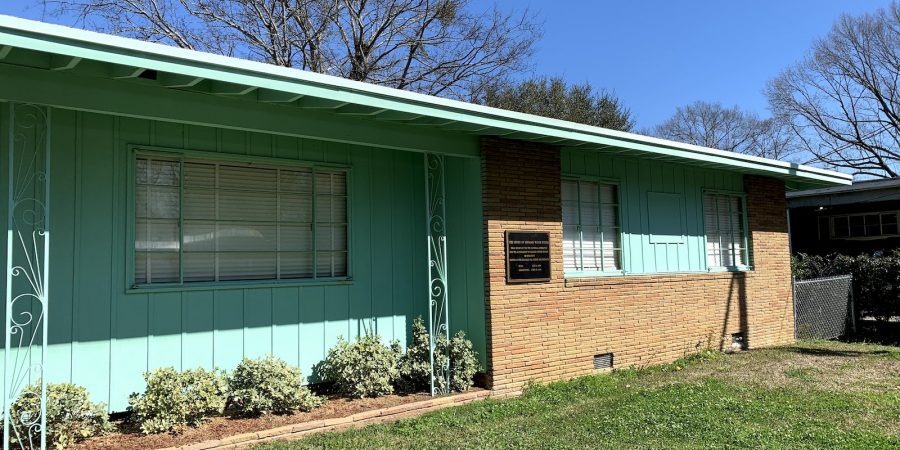
The Trace is dotted with Native-American mounds, verdant green expanses that help us remember the people and cultures who once lived in these hills. Emerald Mound (MP 10.3) is the second-largest ceremonial mound in the US. A steep walkway gets you to the base of the mound where you can take in its size and significance. It’s just 12 more miles south to the finish line, the city of Natchez, which is chock-full of B&Bs and inns. Monmouth Historic Inn offers lovely gardens with live oaks and magnolia trees under which you can stroll.
TLP Editors
Trending content, a taste of chamblee tour | video, spring forward in uptown houston | listen, dine and dash in bowling green | listen, pure po’boy pleasure | listen, in the spirit: cook’s mill whiskey | listen, more from on the road, bring your flip-flops to myrtle beach | listen, cruise the cherokee foothills | listen, leave a reply cancel reply, be the first to comment..

- Theme Parks
- Zoos & Aquariums
- Sightseeing
- National & State Parks
- RV & Camping
- Browse by State
- Food & Drink
- Quick Guides
Select Page
Natchez Trace Parkway Road Trip
Posted by hotelcoupons | Jan 8, 2015 | Road Trips , Sightseeing , Things To Do | 0
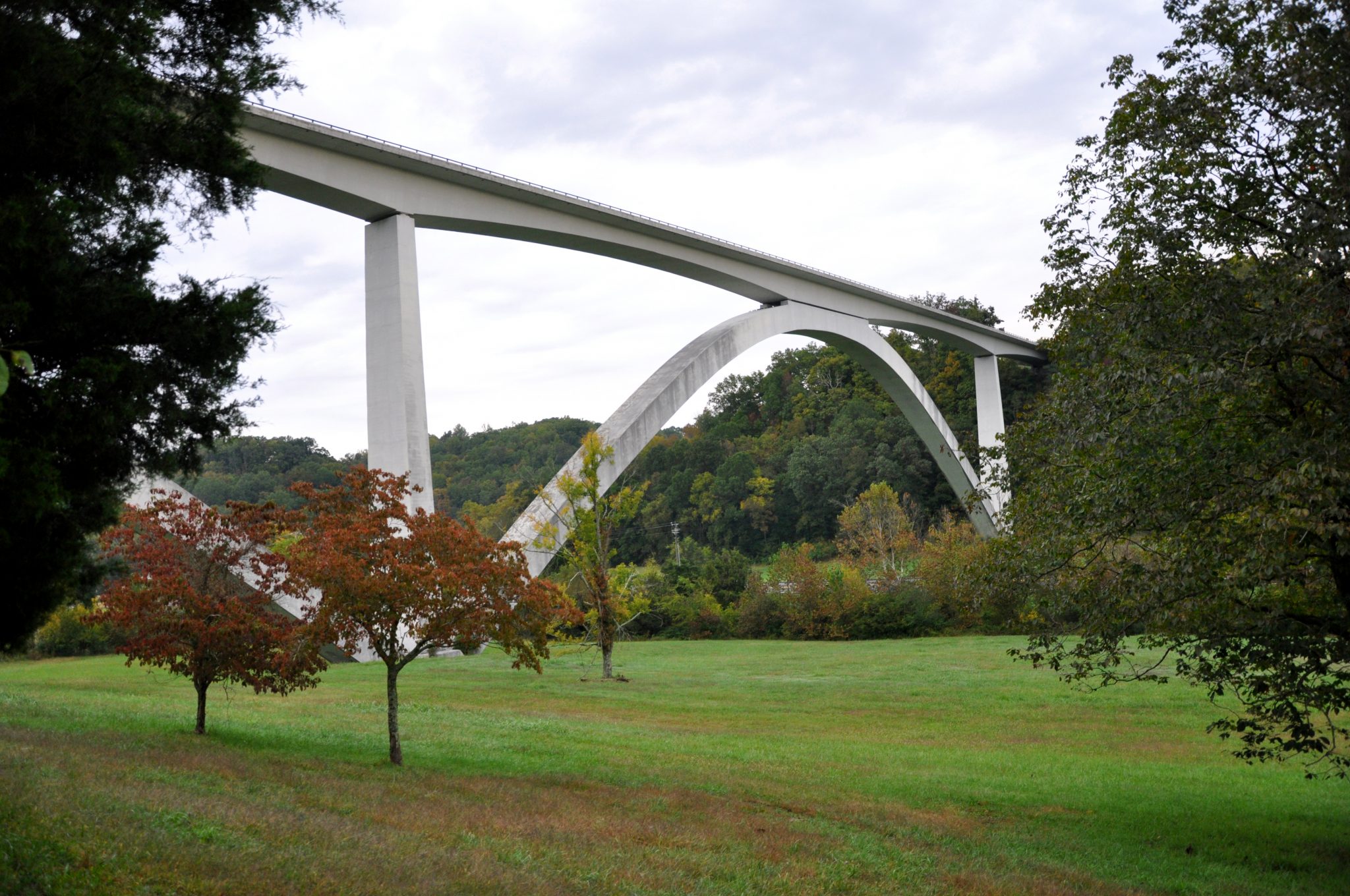
Via Wikimedia Commons
Sunken Trace Via Wikimedia Commons
Via Mississippi Children’s Museum
Ross Barnett Reservoir via Wikimedia Commons
Birthplace of Elvis in Tupelo via Wikimedia Commons
About The Author
hotelcoupons
Related posts.

The Best 4th of July Fireworks Displays
July 3, 2019

Easy Holiday Photo Tips
December 8, 2014
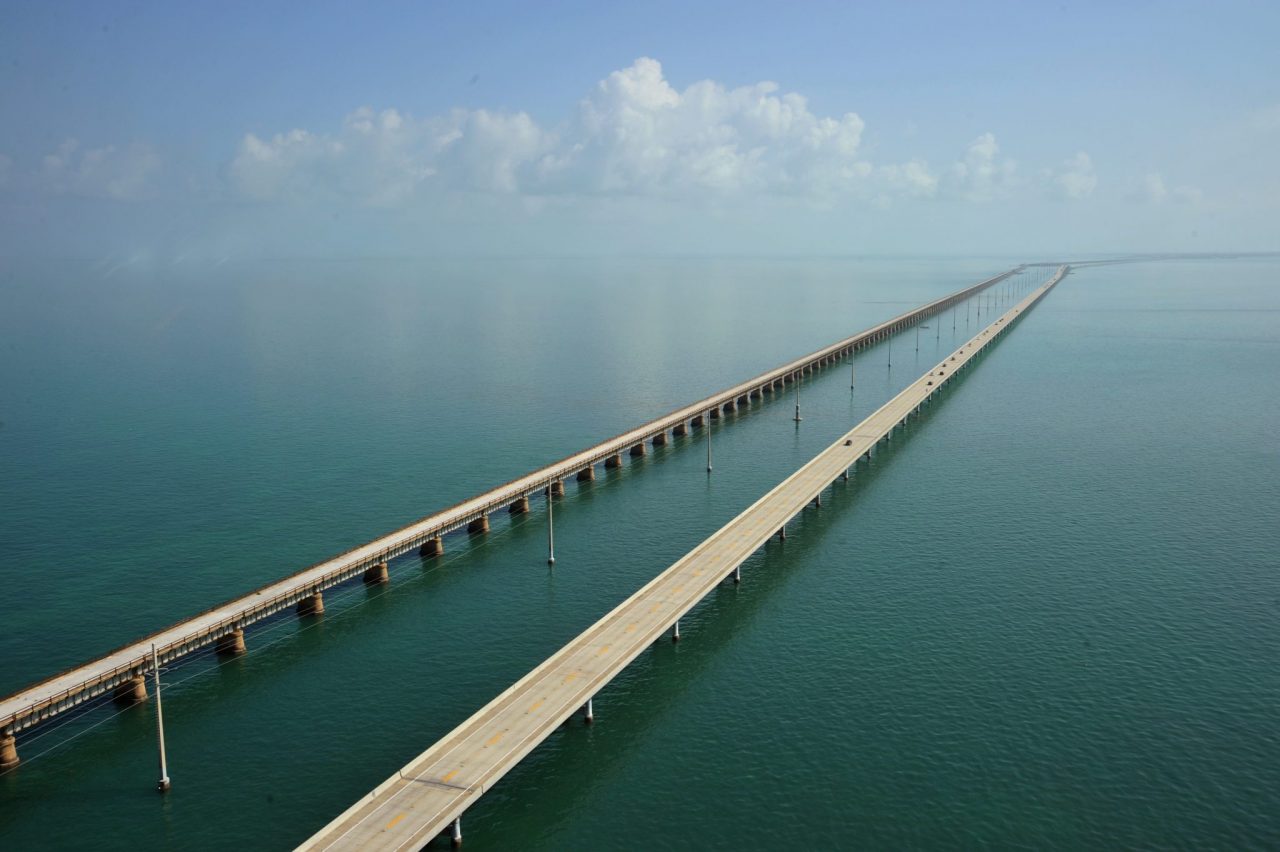
Quick Guide to the Florida Keys
June 27, 2014
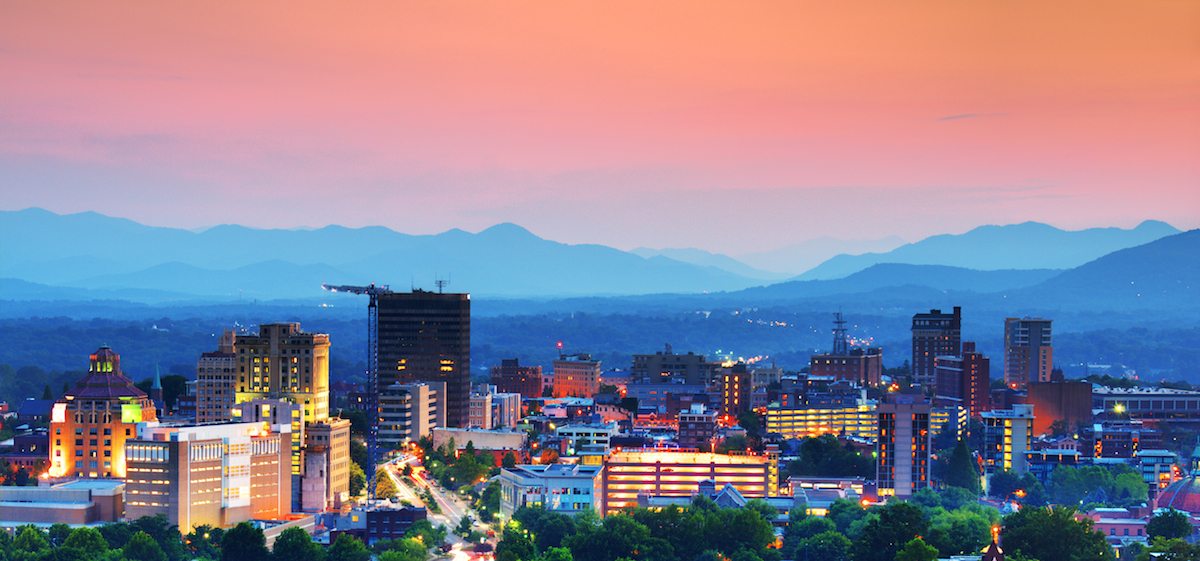
20 Places to See in Your 20s
August 9, 2014
Search for Deals on HotelCoupons.com

Recent Posts
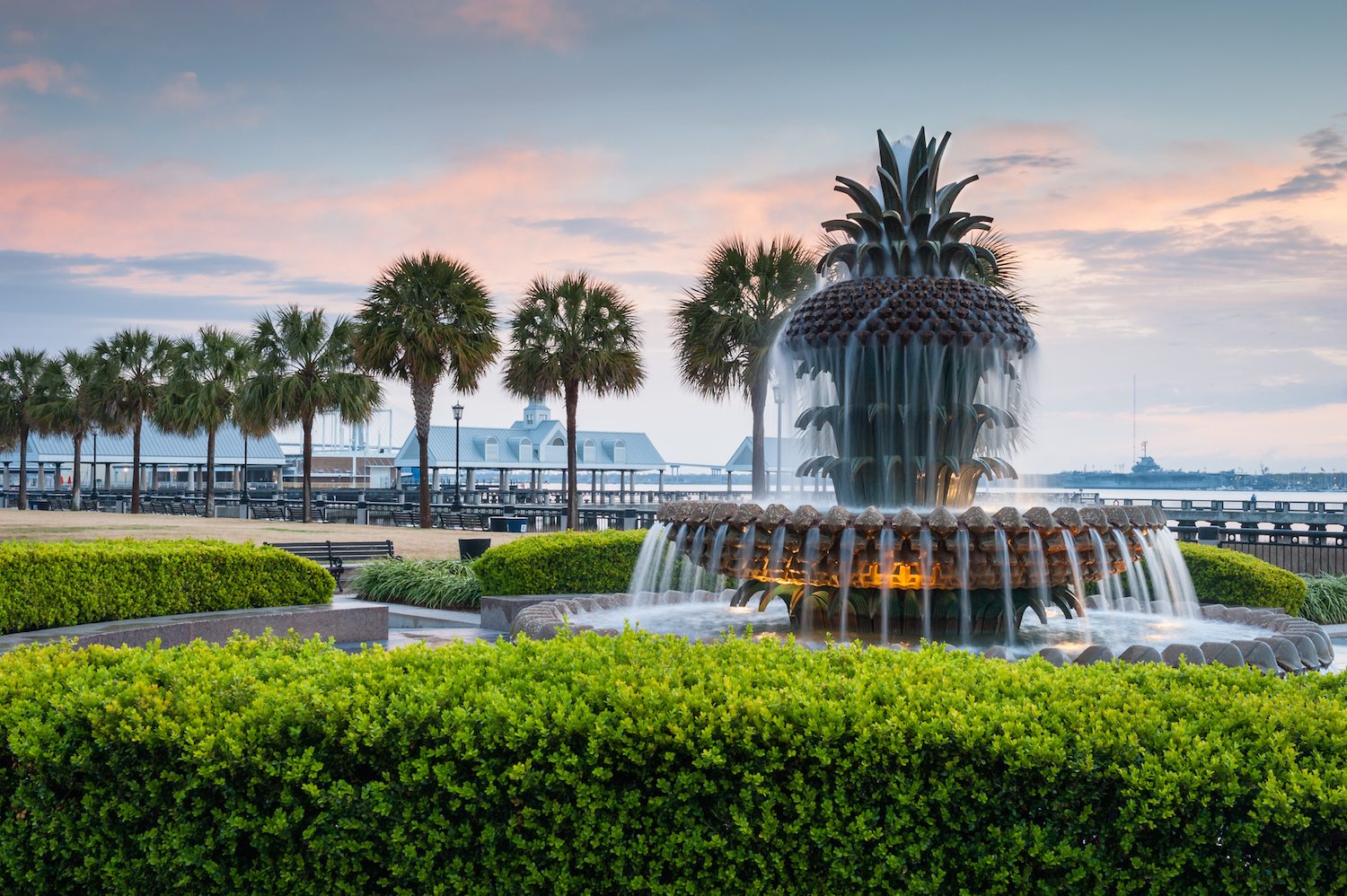
- Search Please fill out this field.
- Manage Your Subscription
- Give a Gift Subscription
- Newsletters
- Sweepstakes
- Fall Travel Ideas
5 Must-Take Drives To Experience Autumn's Glory Across The South
Jessica Farthing writes about food and has a busy speaking schedule teaching aspiring authors to do the same. She's published in numerous publications, tackling a range of subject related to the culinary world.
:max_bytes(150000):strip_icc():format(webp)/jessica-farthing-277c4fa39dbb48a485808ff803f3642f.jpeg)
Blue Ridge Parkway
Talladega scenic byway, foothills parkway, natchez trace parkway, dragon eyes.
The South celebrates the change of season from summer to fall with a glorious display of color. Maple trees turn fiery red and orange, and flowering dogwood produces bright berries for the squirrels and birds to store for the winter ahead. When the weather cools, nothing beats wrapping up in your favorite sweater and heading out on a drive to take in the vivid fall color.
When the autumnal equinox or first day of fall happens in September, days become shorter and nights longer. The absence of a long span of sunshine is actually what causes the leaves to change color, not the cool temperatures themselves. A shorter daytime period is the signal that tells the plants to get ready for winter. Because the time period can fluctuate, it’s not the easiest to predict the best time to take a fall foliage drive. There are predications, but it’s best to check local information as you plan. Here are some ways to view the best fall displays in the South , and our favorite scenic drives.
Virginia and North Carolina
The Blue Ridge Parkway winds through 469 miles of mountain vistas through several states, spanning the distance from the Shenandoah National Park in Rockfish Gap, Virginia to the Great Smoky Mountains National Park in Cherokee, North Carolina. Along the way, drivers can take in the awe-inspiring views of over 280 scenic overlooks, but only around speeds of 45 miles per hour, allowing plenty of time for fall gazing.
The time to visit varies with elevation, giving a lot of opportunity to see autumn’s finest show. Some stops of note are the Purgatory Mountain Overlook in Virginia, which you can view via a virtual camera here and the historic Mabry Mill , with Sunday afternoon music, dancing, and food. Mount Pisgah, with an elevation of 5,721 feet above sea level, starts early with fall color; the area around James River sits lower at 600 feet above sea level, making it the last to change.
Traversing over the higher elevations of Mount Cheaha, the Talladega Scenic Byway is Alabama’s shining example of a picturesque drive. The 29-mile route offers a view over the Appalachian Mountains, covered in color in the fall. At the summit of the drive, the open air Bunker Observation Tower, built by the Civilian Conservation Corps in 1933, offers a panoramic long-range view of the mountains.
Nestled at the base of the Great Smoky Mountains National Park , the 71 mile Foothills Parkway gives views of the mountains and the Tennessee Valley on either side. It took a while to complete: construction started in the 1960s and the final portion, known as the "missing link," didn't open to the public until 2018. Look Rock has a gorgeous overlook with a short trail that leads to a picnic area—the perfect place to enjoy lunch while you’re out looking for crimson and yellow landscapes.
Alabama, Mississippi, Tennessee
This scenic drive offers 444 miles of recreation and leaf gazing. There are three campgrounds available on the route, plus walks, hikes, and RV areas. Leaf changes usually happen in middle to late October at easy to find in places like the Little Mountain, Swan View, or Freedom Hills Overlooks.
Robbie Caponetto
For a more thrilling ridge, take this trip through the Southern Appalachian Mountains that passes through the beloved mountain towns of Blairsville and Helen . Well known to motorcyclists for its 715 curves spread over a 77-mile road, Dragon Eyes provides some serious long-range mountain glory. There’s even merch to prove you’ve made the challenging drive. Along the way, there are quaint towns, waterfalls and incredible state parks. Just don’t take your eye off the road.
Related Articles

IMAGES
VIDEO
COMMENTS
The 470-mile road trip from Nashville to Natchez along the Natchez Trace Parkway takes 9 hours to drive, passing Leipers Fork, Fall Hollow Falls, the Meriwether Lewis Monument, Florence, Dogwood Valley, Tupelo, Bynum Mounds, Jackson and Sunken Trace. One of the best things about the Natchez Trace Parkway is that for almost its entire length, it ...
The 444-mile Natchez Trace Parkway runs from Nashville, Tennessee, to Natchez, Mississippi. The recreational road and scenic drive links the Cumberland, Tennessee, and Mississippi rivers, while passing through three states. The Trace travels from Nashville to Natchez along a lovely, wooded corridor.
The Natchez Trace Parkway is a 444 mile national scenic byway through Tennessee, Alabama, and Mississippi that follows the path of the "Old Trace," a historic walking and wagon trail developed in the 1800s. The Old Trace was roughly based on original Chickasaw and Choctaw footpaths, but was repurposed by colonists as a postal, military, and ...
The federal government began construction of the Natchez Trace Parkway in 1939. It was designed as a limited access two-lane scenic road between the river city of Natchez, Mississippi up to just southwest of Nashville, Tennessee. The current parkway encompasses more than 45,000 acres and is managed by the National Park Service.
Address: 2680 Natchez Trace Parkway, Tupelo, MS 38804 • Learn More…. Our Natchez Trace road trip takes you through the three states of the parkway (Tennessee, Alabama, and Mississippi, then into Louisiana for the flight home. We stop at some of the most historic sites as we wind through this historic and mostly rural road.
Your itinerary will start to build on the right hand side. As you design your trip from the Interactive Map, view and edit your Trace Itinerary anytime here. Email and print options are available, too. Natchez Trace Brochures & Maps. Having travel materials on hand will help guide and enhance your journey that much more. View brochures and maps.
Road Trip. An old Native American footpath turned bucolic, 444-mile scenic drive linking Nashville, TN, and Natchez, MS, the Natchez Trace Parkway defies the jaded notion that the U.S.A. has become a coast-to-coast strip mall. Blissfully free of commercial blight, the relaxing two-lane route treats you to gorgeous woodlands, moss-framed swamps ...
The Natchez Trace Parkway, a 444-mile scenic drive through Tennessee, Mississippi, and Alabama, is a must-visit destination for anyone looking for a beautiful road trip experience. The parkway offers stunning views of rolling hills, forests, and wildlife, as well as a rich cultural history dating back to the Native American civilizations that ...
The Natchez Trace Parkway is a 444-mile recreational road and scenic drive through three states. It roughly follows the "Old Natchez Trace," a historic travel corridor used by American Indians, "Kaintucks," European settlers, slave traders, soldiers, and future presidents. Today, people can enjoy a scenic drive as well as hiking, biking, horseback riding, and camping along the Parkway.
The Parkway maintains restrooms along the way. There is usually no more than 50 miles (an hour of driving) between rest stops. Cell phone coverage can be spotty. Use the NPS app and save the Natchez Trace Parkway section of the app to your phone. The Parkway road is two lane and only 11 feet wide with no shoulder.
Travel back in time with a trip on the 444-mile-long Natchez Trace Parkway. This All-American Road travels from Natchez, Mississippi, to Nashville, Tennessee, and clips the northwestern corner of Alabama. ... 🦔 South Western USA Road Trip. Allan Watt 11357 views • 51 likes. US Road Trip from Boston, MA . Marissa Winsser 25015 views • 137 ...
You will probably want to visit some of the cities along the trace. Such as Leiper's Fork, Muscle Shoals, Tupelo, Jackson, and, of course Natchez, Mississippi. Thanks for stopping by! The Ultimate Natchez Trace Trip Planner. Here are 30 great stops on the Natchez Trace Parkway. From historical to scenic to cultural sites.
The Natchez Trace Parkway is so much more than a 444-mile drive. It is a journey through thousands of years of history. Native American tribes used the road as a trade route between the various tribes. Early American settlers used the road as a way to get to what was then known as the Southwest, bordering the Mississippi River.
Running parallel alongside the "Old Trace," the parkway begins in Natchez, in the southwest region of the state, and continues north for 715 kilometers to Nashville, Tennessee. The surrounding countryside was green, the trees well established and the undergrowth plentiful. The two-lane road was flanked on either side by densely wooded areas.
This recreational road and scenic drive through three states is one of the most scenic drives in the USA. A road trip down the Natchez Trace Parkway can be an awe-inspiring experience. It may not strike you at first, but as you drive along the Parkway, you'd be traveling down the approximation of a 10,000-year-old pathway steeped in history.
🚙 Drive America's Highways for 9 miles north along the Natchez Trace Parkway in Tupelo, Mississippi 🏞Starting at the interchange with U.S. Route 278, we ta...
The 444-mile Natchez Trace Parkway traces a Native American trading route and explores the most beautiful sections of Tennessee, Alabama, and Mississippi. It's a popular multi-day getaway for motorcyclists and road trippers, with plentiful places to stay along the way. Most travelers navigating the parkway will start the journey outside of ...
Use our interactive map to explore the scenic Natchez Trace Parkway. Add points of interest to an itinerary to start planning your trip.
It's a parkway and parkways need repaving. At any one time, there is likely to be a portion of the parkway closed to traffic, bicyclists and pedestrians. Check our Alerts for current detours. Fines are heavy for violations. Normal Driving Times. 10 1/2 hours from Natchez, MS to Nashville, TN ; 4 to 4.5 hours from Tupelo, MS to Nashville, TN
The entire Natchez Trace Parkway runs through three states - Tennessee, Alabama and Mississippi - in its 444-mile (715-kilometer) journey from the outskirts of Nashville, Tennesssee, to Natchez, Mississippi. This tour covers 136 miles (219 kilometers) of the Natchez Trace Parkway, stretching through the Tennessee and Alabama sections of the ...
Wichahpi Stone Wall (milepost 338) This is absolutely the weirdest stop on the Trace. A short drive on County Road 8 takes you outside the parkway's boundaries to a spot in the woods where the late Tom Hendrix spent 30 years building a winding stone wall. The 5-foot-high and 5-foot-thick wall runs more than a mile like a maze through the trees.
Select the Natchez Trace Parkway on the National Park Service free APP . Screen shot. Tip #1: Look at a map. Pick your travel distance and entry point. The Parkway is 444 miles long with an end-to-end driving time of about 10 hours (The speed limit is 50 MPH, and lower in congested areas). It travels near a few cities and near many small towns.
Traversing the Trace. Natchez Trace Parkway is a 444-mile route managed by the National Park Service. It runs through three states—Tennessee, Alabama, and Mississippi—connecting Nashville to Natchez, Mississippi. Like any good national park site, it is all about nature and history. The road itself has no commercial stops and doesn't even ...
Natchez Trace Parkway Road Trip. The Natchez Trace Parkway winds its way from Natchez, Mississippi, to the outskirts of Nashville, Tennessee. The Trace began 10,000 years ago as buffalo and Indian trails. It became the first national highway of what was then the southwest, under authority of the US government, following treaties with the ...
Map of Mississippi from 1819 showing the "Road Made by Order of Government from Pierre River to Nashville" One of numerous overpasses on the Natchez Trace toward the exit to Vicksburg Grindstone Ford photographed c. 1938 Even before the 1803 Louisiana Purchase, President Thomas Jefferson wanted to connect the distant Mississippi frontier to other settled areas of the United States.
The Blue Ridge Parkway winds through 469 miles of mountain vistas through several states, spanning the distance from the Shenandoah National Park in Rockfish Gap, Virginia to the Great Smoky Mountains National Park in Cherokee, North Carolina. Along the way, drivers can take in the awe-inspiring views of over 280 scenic overlooks, but only around speeds of 45 miles per hour, allowing plenty of ...
Visitors can get brochures and ask questions at the Natchez Trace Parkway Visitor Center six miles up the road at 2680 Natchez Trace Parkway, Tupelo. Got a news tip? Contact Mary Boyte at mboyte ...